
- Subscribe Now
- Digital Editions


Best electric outboard motors: 11 top options for zero-emissions propulsion
- Electric boats
- Top stories
Electric outboard motors seem to be springing up all over the place right now. We round up 11 of the best electric outboards on the market…
Electric outboard motors are nothing new, after all the humble electric trolling motor has been around for decades, but in the past couple of years a new breed of more powerful units has emerged.
Capable of powering everything from a tender to a 50-knot sportsboat, this new generation of electric outboard motors will surely play a big role in the growing trend towards all- electric boats .
We’ve rounded up 11 of the best options available on the market right now to help you track down the right one for cutting down your boat’s carbon footprint.
Compact electric outboard motors for your tender

Torqeedo 603 Travel
Weight: 15.5kg Power: 600W / 0.8hp Battery: 500Wh Range: 11nm Price: £1,499
Torqeedo has been making electric outboard motors for quite a while now, and their latest offering slots into the travel range of electric outboards between the 503 (1.5hp) and the 1103C (3hp).
All the usual Torqeedo refinements are present and correct. IP67 rated as totally waterproof, the 603 Travel has a magnetic kill cord and an onboard computer providing instant readouts of operating range at current RPM and battery-charge status displayed on the tiller arm.
You can link it to an Apple or Android app and gain even more information including a map-based range indicator.
Read more about the Torqeedo 603 Travel

Mercury Avator 7.5e
Weight: 27.1kg Power: 750W / 1hp Battery: 1kWh Range: 34nm Price: $1,500
Announced in early 2022 and launched less than a year later, the Mercury Avator 7.5e is the first electric unit from the world’s biggest builder of outboard engines .
The whole top plate hinges up to reveal the battery, which can be quickly removed from your electric boat or replaced for convenient charging.
It’s by no means the lightest electric outboard motor on the market, but its claimed range at 25% throttle is very impressive – we look forward to putting one to the test.
Not resting on its laurels, Mercury launched the Avator 20e and 35e this summer as well. These units are no bigger than the 7.5e, but need wiring in to an on-board battery bank.
Read more about the Mercury Avator 7.5e
Read more about the Mercury Avator 20e and 35e

Weight: 14.5kg (inc. bracket) Power: 1kW / 3hp Battery: 1,085 Wh Range: 14nm Price: £2,185
The idea behind the Remigo One electric outboard makes perfect sense; rather than mounting the battery on top of the shaft, like the engine on an old-school petrol outboard, the Slovenian company has integrated it into the shaft and shaped it like a rudder to minimise drag and maximise steering effect.
It is backed by a 2-year warranty and has a magnetic key/kill cord. There are some other neat ideas too. The rudder casing is waterproof to IP67 above the water and IP69 below the water so it will survive a dunking, and it’s held in place by a clamp mechanism that allows you to adjust the shaft length to suit your boat with the aid of an allen key.
The transom bracket is separate to the motor so you can leave the bracket attached to the boat and simply slot the motor on and off. The tiller also folds and locks parallel to the blade so you can use it as a perfectly balanced carry handle.
Watch our test drive video of the Remigo One electric outboard

The Kicker is exceptionally light and surprisingly powerful
Thrustme Kicker
Weight: 4.4kg Power: 1kW / 3hp Battery: 259kWh Range: 5nm Price: £1,250
If it’s light weight and value that you prioritise over cruising range, then this Norwegian option is hard to beat.
Launched in 2021, the Kicker boasts enough range and grunt to get one person from ship to shore and back again in calm conditions, as editor Hugo proved in a week-long test.
The only downside is that the battery isn’t removable, which can make charging a little more difficult.
Read more about the Thrustme Kicker

Weight: 15kg Power: 1kW / 3hp Battery: 740Wh Range: Up to 1hr Price: €2,850
A brand new option from France, the TEMO-1000 doesn’t look anything like a traditional outboard motor.
The design doesn’t have any rectangular box on top, just a rudder-shaped shaft with an electric motor at the bottom and a long slim battery that simply slides down into it, connecting automatically to your electric boat without having to plug wires into it.
The tiller arm does the same, meaning it disappears completely when not in use and yet it is never detached and therefore never mislaid.
Read more about the TEMO-1000

Haswing Ultima 3
Weight: 16kg Power: 1kW / 3hp Battery: 1.03kWh Range: 18nm Price: £1,570
A top-of-the-range option from trolling motor stalwarts Haswing, the Ultimate 3 is suitable for boats up to 7m long.
The brushless DC motor produces 3hp (claimed to be equivalent to a 4hp petrol outboard motor), and it’s available in short and long shaft versions as well as the standard length.
Not only is the detachable battery unusually light at 5kg (lightest in class, according to the manufacturer), it also connects to the engine in a single simple operation without the need for connecting cables or other fiddly parts – no bad thing when you’re bobbing about in a tender!
Read more about the Haswing Ultima 3

ePropulsion Spirit 1.0 Plus
Weight: 19.3kg Power: 1kW / 3hp Battery: 1,276Wh Range: 22nm Price: £1,600
The original Spirit 1.0 has actually been in production for six years with over 10,000 units built. Featuring a 1,000W brushless motor, this electric outboard motor is claimed to be equivalent to a 3hp petrol engine, ideal for tender duties or small to medium sized dinghies.
This Plus version, launched in 2020, is the same weight, size and power – the big gain is where it’s needed most, run time. It has been achieved by upgrading the battery from 1,018Wh to 1,276Wh.
At the same time, the power cord has been upgraded for durability and reliability, and the voltage has been changed from 40.7V to 48V, making it compatible with an external 48V battery. The battery will even float if dropped overboard!
Read more about the ePropulsion Spirit 1.0 Plus
Most powerful electric outboard motors for day boats

Yamaha Harmo
Weight: 55kg Power: 3.7kW / 9.9hp Battery: Sold separately Range: Depends on battery Price: £TBC
Announced in 2022 and tested on a 12m Venmar water taxi, the Yamaha Harmo electric boat drivetrain may be a rather modestly powered 3.7kW motor, equivalent to a 9.9hp petrol engine, but it is being seen as a major statement of intent from the Japanese brand synonymous with big, powerful four-stroke outboards.
Intriguingly, the Harmo is neither an outboard engine nor a sterndrive but a new propulsion package that borrows ideas from both camps.
It is mounted on the transom just above the waterline much like a sterndrive leg, but in keeping with the outboard engine ethos it’s an entirely self-contained unit that includes the motor and steering mechanism.
Read more about the Yamaha Harmo electric rim drive

RAD Propulsion RAD40
Weight: 100kg Power: 40kW / 55hp Battery: 20-60kWh Range: 100nm Price: £28,000 (ex. battery)
The RAD40 drive from British start-up RAD Propulsion appears to be far more than just a conventional outboard leg with an electric motor bolted on top.
Every single element of it has been designed from the ground up to maximise the benefits of electric power. The result is a brand new drive system that is not only much cleaner, quieter and more efficient than a petrol outboard engine but also smaller, lighter, cheaper to maintain and even more manoeuvrable.
In its current 40kW guise (equivalent to around 55hp) it’s powerful enough to propel everything from a 25-knot planing RIB to a 10-knot displacement craft but with a larger 160hp RAD120 as well as a portable tiller steered RAD2 already in development, it’s clear that RAD Propulsion has its eyes set on a much wider market.
Read more about the RAD Propulsion RAD40 electric outboard

E-Motion 180E
Weight: 580kg Power: 110kW / 180hp Battery: 70kWh Range: 70nm Price: $78,990
Launched in 2021 by Canadian firm Vision Marine Technologies, the E-Motion 180E looks like a genuine alternative to the 150-200hp petrol outboard motors that power the vast majority of 18-25ft sportsboats and RIBs.
The outboard engine itself weighs around 180kg, compared to 216kg for a 200hp V6 Mercury Verado, but that relatively modest saving pales into comparison next to the 400kg weight of the 70kWh battery pack.
Admittedly, a fair chunk of that will be offset by the lack of fuel tank and starter batteries, but unlike a petrol boat, the battery pack’s weight stays constant whether full or close to empty.
Read more about the E-Motion 180E

The Evoy Storm looks, feels and goes like a well-matched petrol outboard engine
Weight: 350kg Power: 222kW / 300hp Battery: 2x 63kWh Range: 25nm Price: €144,700
Although currently still in development, the Evoy Storm is a working prototype that has already been fitted to a number of partner brands’ boats, including an Iguana amphibious craft and an Axopar 25 that we tested at last year’s Cannes Yachting Festival .
Despite a 450kg weight penalty over a fully fuelled petrol boat, and five passengers, we still recorded a top speed of over 50 knots – vastly quicker than any other electric boat we’ve tested and not far off the world speed record for a production electric boat of 57.7 knots (held by a Goldfish X9 powered by a 400hp Evoy inboard).
The anticipated price for this electric Axopar 25 is €185,000 (ex tax), which looks pretty good value given that the price of the motor alone is €74,900 plus another €69,800 for the batteries. Whether Axopar can maintain, or even reduce, that price once the Evoy Storm enters production in 2024 remains to be seen.
Read more about the Evoy Storm
Tip of the iceberg
If this seems like a lot of choice, there are even more options coming down the pipeline in 2024. MBY understands that several major outboard manufacturers are planning on entering the electric outboard market, so watch this space…
If you enjoyed this…
Be first to all the latest boats, gadgets, cruising ideas, buying advice and readers’ adventures with a subscription to Motor Boat & Yachting . Available in both print and digital formats, our monthly magazine will be sent directly to your home or device at a substantial discount to the usual cover price. See our latest offers and save at least 30% off the cover price.
Maserati Tridente: The First Maserati-Branded Motor Boat, and It’s Electric
Witness appeal after reports of a motor boat collision, james bond’s birthday gift to the rnli, latest videos, watch: parker sorrento sea trial: 50-knot cruiser with a killer aft cabin, watch: virtue v10 sea trial: €272k weekender, how to mark your anchor chain: 6 top tips from our expert, watch: galeon 560 fly sea trial – the best galeon flybridge you can buy.
Yachting Monthly
- Digital edition

Electric outboard motor: we test 13 options
- Theo Stocker
- July 25, 2023
An electric outboard motor is now a viable option for dinghy propulsion. Emrhys Barrell puts the latest outboards and trolling motors to the test
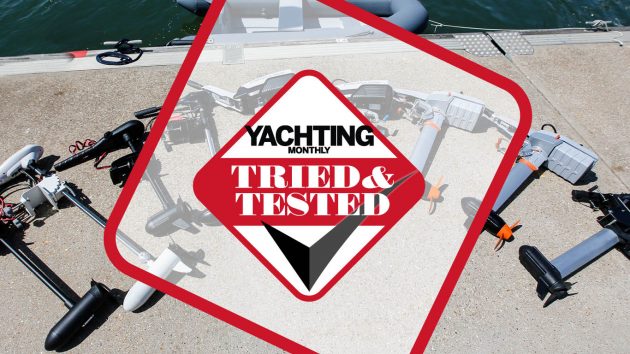
The electric outboard motor has been around for many years, but they have either been too low powered or their lead acid batteries have made them too heavy to lift in and out of a small tender, so petrol outboards have remained the engine of choice.
The development of lightweight lithium batteries has changed all this, making an electric outboard motor a practical alternative to petrol – and making all electric yachts a real possibility too.
With this in mind, we tested 12 models whose all-up weight, or the weight of their individual components, did not exceed the 14-17kg of a 2.5hp petrol outboard.
See how we tested the electric outboards at the end of this article.
Best electric outboard motor

Specifications Outboard weight: 12kg Overall weight with outboard and bracket: 14.5kg Battery capacity: 1085Wh Top speed: 5kts Thrust: 30kg / 66lbs
Designed along the lines of a dinghy rudder, this Remigo outboard is incredibly easy and intuitive to use. No external cables or anything to be snagged, it clips onto a bracket pre-mounted to your tender or dinghy, in a similar way that you’d attach a dinghy rudder.
Flip down the handle, attach the magnetic kill cord and you’re good to go.
On test this outboard gave as much thrust as the ePropulsion below but out performed it in terms of maneuverability. The Remigo can be switched from forward to reverse thrust at the touch of a button.
We like the Remigo for it’s sleek simplicity. If you want a clean smart easy to carry outboard to take you from your mooring to shore or quietly meander from your anchorage to shore then this is definitely worth considering.
We especially liked the rudder effect of this outboard giving us steerage even we had turn the power completely off to coast in alongside our pontoon.
Read Fox Morgan’s review of this outboard – Remigo One Electric Outboard review
Reasons to buy
very easy to stow, innovative rudder design, lightweight, built in battery, easy to mount and dismount
Reasons to avoid
No multiple battery swap options like more conventional electric outboards
Find a dealer at Silent Yachting

Photo: Paul Wyeth
ePropolsion Spirit 1.0 EVO
Yachting Monthly’s best buy
Specifications Motor weight: 10.5kg Battery weight: 9kg Battery capacity: 1276Wh Top speed RIB: 4.5mph Top speed skiff: 6.0mph Thrust: 31kg/68lbs
The Chinese firm ePropulsion has been developing its electric outboard motor range and lithium batteries for some time. We tested the Spirit 1.0 Plus and Evo, both 1kW motors with integral batteries.
Clearly ePropulsion was influenced by Torqeedo, but there are some important differences. From the outset ePropulsion went for a direct drive motor, being quieter and avoiding gearbox problems.
The battery has a greater capacity than the original Torqeedo, and is still 30% higher than the latest version. It also floats – useful if you should drop it overboard.
Fitting the battery is a two-handed job, with the carrying handle being at the back, and latch lock at the front, which requires leaning over the transom to install it. You also cannot see the locating slots underneath, which isn’t quite so easy in a bobbing inflatable. The power cable socket is protected by a rubber cap.
You have a display, but it only shows power being consumed, voltage, and remaining runtime, which means it has larger figures, easier to read on a sunny day, but it lacks GPS speed or range.
It has the same trim settings as the Torqeedo, with a similar fiddly retaining split ring. It also has a magnetic kill cord. Three shaft lengths are available, catering for transom heights up to 61cm. The shaft is streamlined but rotates through 360º for maximum manoeuvrability and reverse.
High battery capacity Quiet 360º rotation
Limited display options
Buy it now from epropulsion

Yachting Monthly’s best in class
Specifications Motor weight: 10.5kg Battery weight: 9kg Battery capacity: 1276Wh Top speed RIB: 4.5mph Top speed skiff: 6.0mph Thrust: 68lbs Regeneration: 4 knots – 40W / 10 knots – 300W
The 1.0 EVO has the same dimensions and performance as the Spirit, but it has the options of a removable tiller, plus remote controls and steering, but the real innovation is that it offers regenerative charging while you are sailing, putting 40W at 4 knots, and 300W at 10 knots back into the battery.
You can even have a wristband remote for steering and throttle.
The ePropulsion Spirit 1.0 EVO is undeniably more expensive than it’s little sister without the regenerative charging and the cost difference is significant. If you are likely to be doing a lot of sailing and using your electric motor from ship-to-shore in relatively remote locations then the regeneration will probably be worth it. For most, though the price differential is probably a little too steep.
Regenerative charging Removable tille Remote controls
Relatively expensive

Torqeedo 1103 and Torqeedo 603
Torqeedo 603 specifications Motor weight: 11kg Battery weight: 4.2kg (floats) Battery capacity: 500Wh Top speed RIB: 4.0 mph Top speed skiff: Not tested Thrust: 44lbs
Torqeedo 1103 specifications Motor weight: 11kg Battery weight: 6kg Battery capacity: 915Wh Top speed RIB: 4.4mph Top speed skiff: 6.0mph Thrust: 68lbs
Torqeedo was the first company to commercially produce an outboard with an integral lithium battery in 2005. The earliest motors used a high-revving geared motor, which produced a characteristic whine. Following the launch of its new larger battery, Torqeedo changed to direct drive at about the same time that ePropulsion arrived on the scene.
The 1103 is 1.1kW and has a removable battery and tiller/throttle. The battery locates in slots in the powerhead and can be dropped in one-handed, with the slots clearly visible from above, which is helpful in a rocking dinghy. It then hinges back and locks in place with a separate plastic pin. The tiller locates in similar slots.
The two are then connected to the motor by a power cable and a data cable, but the latter has an 8mm plug, with five tiny pins that have to be carefully lined up, then secured with a threaded plastic collar. Neither of the sockets have caps to prevent debris or water getting into them when the cables are not connected.
The display on the tiller shows four lines of data at the same time, which makes them small to read (a phone app can be used for a large display). They include volts, battery capacity, range at a given speed, speed in kts, mph or km/h, and power consumption in watts. A magnetic kill-cord cuts the power circuits if you fall overboard.
The motor has four trim positions to allow for angled transoms, but the split ring securing the locking pin is very stiff and fiddly, especially when you have to adjust it hanging over the transom. A side-mounted lever allows the motor to be tilted horizontally. In normal use a catch prevents the motor kicking up in reverse, but this can be released with another side-mounted lever if you are in shallow water.
Long and short shaft versions are available, with the height of the transom to the top of the prop on the long shaft being 62cm. Clamps screws and fittings are stainless steel, making it suitable for salt water use, but an anode is an extra. It has forward and reverse but not 360º rotation.
Established brand with relatively long history Removable battery and tiller Lots of display options
Display hard to read
Buy the Torqeedo 603 now from Torqeedo Buy the Torqeedo 1103 now from Torqeedo
Best Trolling motors
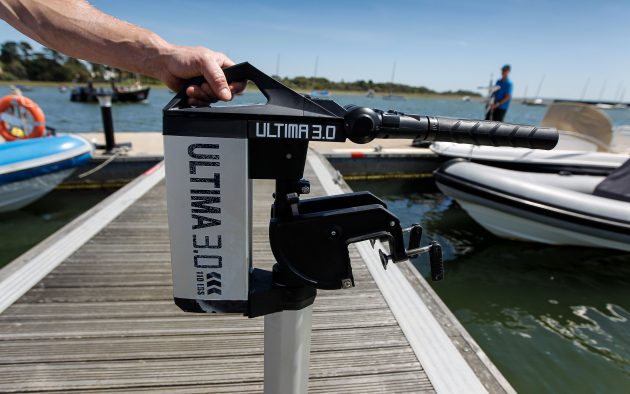
Haswing Ultima 3
Specifications Motor weight: 11kg Battery weight: 5kg Battery capacity: 600Wh Top speed: RIB 4.0mph Top speed skiff: Not tested Thrust: 51lbs
Haswing is a new name to us, but this Chinese manufacturer now has an extensive range of motors, several of which we were able to bring along to our test.
The Ultima 3 has an integral Lithium battery and an output of 1,000W, with the ‘3’ in its name indicating the 3hp petrol outboard its makers claim it is equivalent to. The battery is 600Wh.
The battery was the easiest of all in our test to fit and remove, just sliding down a set of grooves, with contacts in the bottom removing the need for any linking cables or wires, and an easy one-handed operation.
The unit is well engineered, with stainless steel used throughout plus an anode as standard, making this suitable for use in salt water, and a spare anode and shear pin. The tiller/throttle hinges up and down for easy operation and storage. It has a streamlined aluminium leg, but rotates 360º.
A magnetic kill cord is a useful safety feature, and there are 5 LEDs showing battery capacity remaining, but this is the only instrumentation, so there is no way of gauging how much power you are using. It also meant that with no exposed power cables, we could not measure intermediate power settings.
Easy to fit battery Anode as standard for salt water usage High end materials
Limited instrumentation
Buy it now from Amazon

Motorguide Varimax 40
Specifications Motor weight: 9.1kg Battery (Sterling 60Ah) – 8kg Battery capacity: 780Wh Top speed RIB: 3.2mph Top speed skiff: 4.0mph Thrust: 28lbs
Another trolling motor, this has a claimed 40lb thrust and a variable speed electronic control. The throttle pulls forward for ahead, and pushes back for reverse then twists in the same direction for speed. A clever feature once you get used to it. Ten LEDs show the battery state.
The sliding shaft gives transom heights up to 65cm transom to prop, and 360º rotation. It also quickly tilts through 90º, with 5 positions, for shallow or weedy water.
Clamp screws and fittings are mild steel, meaning you should wash it off with freshwater after using it in the sea.
Clever throttle control Variable transom heights accomodated
Quite basic in functionality

Haswing Osapian 55
Yachting Monthly’s best budget buy
Specifications Motor weight: 9kg Battery weight: (Sterling 60Ah) 8kg Battery capacity: 780Wh Top speed RIB: 3.3mph Top speed skiff: 4.4mph Thrust: 35lbs
This is another trolling motor with a claimed 55lb thrust, but with five forward speeds and three reverse on a twist-grip throttle. Again, it is a well-engineered motor, with all fittings and clamp screws made of stainless steel, an anode behind the prop and a spare in the box.
Five LEDs show the battery state. The sliding shaft gives transom heights up to 62cm, and 10 tilt positions.
As with all click-speed throttles you have double the power at Setting 5 compared to Setting 4, and very poor range figures at intermediate speeds compared to motors with electronic throttles.
However it is an excellent value-for- money option for sailors looking for ways to power their tender for short trip
Well engineered Value for money
Poor range at medium speeds

Motorguide SW82
Specifications Motor weight: 13kg Battery weight: 16kg Battery capacity: 1,560Wh Top speed RIB: 4.0mph Top speed skiff: 5.5mph
Motorguide is a well-established US company that is part of the Mercury/Mariner group. The most powerful of the transom mount range, the 82 has a claimed thrust of 82lbs, and is a 24V unit requiring two 12V batteries in series.
It is also designed for saltwater use, with stainless steel clamp screws and fittings, and a large anode on the shaft. It has an extra long shaft, giving up to 93cm transom height to the prop, 360º rotation, and seven tilt positions There are no battery LEDs. An on/off switch under the control head is the nearest it gets to a kill switch.
Well known company Powerful Anode for salt water
No battery LEDs

Haswing Protruar 1
Specifications Motor weight: 9kg Battery weight: 8kg Battery capacity: 780Wh Top speed RIB: 3.4mph Top speed skiff: 4.5mph Thrust: 40lbs
Another Haswing requiring a separate 12V battery, this has a variable speed electronic throttle, and similar features to the Protruar 5, except no kill cord. It claims to be equivalent to a 1hp petrol motor, but in practice delivered 600W.
The sliding shaft only allows transom heights up to 40cm, but a longer shaft version is available. It has 10 tilt positions and 360º rotation.
Another well engineered unit, with stainless steel used throughout plus an anode as standard, and a spare anode and shear pin. The tiller/throttle hinges up and down for easy operation and storage.
Anode for salt water use 360º rotation
No kill chord Limited transom height range
Haswing Protruar 5
Specifications Motor weight: 14kg Battery weight: 16kg Battery capacity: 1,560Wh Top speed RIB: Not tested Top speed skiff: 6.1mph Thrust: 108lbs
Another Haswing, the Protruar 5 is the most powerful model we tested. The unit is extremely well engineered, with stainless steel used throughout for the clamp screws and fittings, plus an anode as standard, making this suitable for use in salt water. A nice touch is the spare anode and shear pin in the kit. The tiller/throttle hinges up and down for easy operation and storage.
Its 5 designation indicates its makers think it is equivalent to a 5hp petrol motor, but in reality it delivers around 2.5kW at 24V so requires two separate batteries. It has a variable electronic throttle, three battery state LEDS and a magnetic kill cord.
The shaft slides up and down, giving a maximum transom height of 62cm and 360º rotation. Ten tilt positions are quickly engaged by a squeeze lever.
The thrust was the highest of the test, making it suitable for heavy boats, but the fine pitch prop significantly reduced its efficiency at speed.
Powerful model Anode for salt water use Battery LEDs and kill chord
Needs two batteries for full power

Motorguide R3 45
Specifications Motor weight: 9.5kg Battery weight: (Sterling 60Ah) 8kg Battery capacity: 780Wh Top speed RIB: not tested Top speed skiff: 4.1mph
This trolling motor has a claimed thrust of 45lbs and five forward speeds. The sliding shaft gives transom heights up to 65cm and 360º rotation, with seven tilt positions. Clamp screws and fittings are mild steel, so should be washed after saltwater use.
The click-speed throttle gives non-linear power gaps, with Speed Setting 5 being double the power of Setting 4. This throttle arrangement results in poor range figures at medium speeds compared to motors with electronic throttles, but it keeps the price down.
360º rotation Plenty of transom height range
Minn Kota Endura Max 55
Specifications Motor weight: 9.5kg Battery weight: (Sterling 60Ah) 8kg Battery capacity: 780Wh Top speed skiff: 4.6mph
Minn Kota is one of the oldest makers of trolling motors. The Max 55 has a claimed 55lb thrust, with a variable speed electronic twist-grip throttle.
Clamp screws and fittings are mild steel, making it best suited for freshwater, though you can use it in the sea if you wash it off afterwards.
It has a fine pitch prop like all trolling motors, which gives a good static thrust, but efficiency, and hence range, falls off at higher speeds, though the electronic Maximiser throttle helps to offset this.
Electronic maximiser throttle helps offset range issues
Big range drop off at high speeds Needs washing after salt water usage
Buy it now from MinnKota
How we tested the electric outboard motors
We took a selection of electric outboard motor units available on the market, and tested them in two situations, firstly on a Frib 275 folding RIB on the Lymington River to reproduce the situation of getting out to your boat in the tender. We then put them on a 4m skiff on the Thames, to see how they perform at higher speeds on a boat with a smoother underwater form and longer waterline on sheltered waters.
Speed: We measured speed using a handheld GPS, and electricity consumed using a clamp ammeter or the motor’s inbuilt power display. We converted these to the range you would achieve, either for a given power, or the full power of the motor’s battery.
Thrust: We measured static thrust using a spring balance. This is a somewhat crude test, as it measures the pulling power of a motor in a static boat, and therefore doesn’t allow the propeller pitch to work at its designed speed.
Function: We checked the stated weights of each of the motors and made a qualitative survey of their main features when used as a dinghy outboard.
We tested the trolling motors with a 60Ah lithium battery from Sterling Power, which cost £360, though you can use a heavier lead acid battery costing around £120 for a good quality AGM or gel. Don’t bother with leisure batteries, which will fail after 4 to 5 trips. You will need a good quality Lithium charger, which will add on £100 or more.
We haven’t included charging in this test, as this is dependent on the charger you are using, whether you are charging from 240V or 12V on board, and whether the power source is mains, a generator, alternator or solar. It’s worth noting that you will rarely be recharging from flat, and will rather be aiming to top up batteries after each use.
Trolling motor or electric outboard motor?
The options today are trolling motors with separate batteries – so called because they were mainly used as auxiliary slow-speed power for anglers, and integral-battery motors built for dinghy propulsion. These are the options a sailor will be looking at when thinking about changing to an electric outboard.
Trolling motors are still popular for low-speed applications, as they are simple and cheap, but they do need a separate 12V battery.
The integral battery motors are sophisticated units designed to give you more speed and greater range for a given power in a small boat, though for any 3-4m boat, the hull speed will limit how fast you can realistically go with any motor unless you start planing.
An electric outboard motor with an integral battery will often include displays showing speed, range at a given speed, and percentage of battery capacity remaining, but these features come with a higher price tag.
The trolling motors and integral battery models in our test were similar in weight and both come in at around the same total weight as a 2.5hp petrol engine.
Enjoyed reading this?
A subscription to Yachting Monthly magazine costs around 40% less than the cover price .
Print and digital editions are available through Magazines Direct – where you can also find the latest deals .
YM is packed with information to help you get the most from your time on the water.
- Take your seamanship to the next level with tips, advice and skills from our experts
- Impartial in-depth reviews of the latest yachts and equipment
- Cruising guides to help you reach those dream destinations
Follow us on Facebook , Twitter and Instagram.
- Electric Outboard Motors
9 Best Electric Outboard Motors in 2024

We gave our boating experts the job of reviewing an updated selection of the best electric outboard motors.
Our sailors and cruisers considered size, price and application when selecting motor options. They tested and conducted interviews for this guide.

It’s suddenly realistic to have an electric outboard motor for maritime propulsion. The best electric solution will depend squarely on the vessel.
As more electric outboard motors pop up on the market, you’ll find “green” boating taking two paths. One path is the all-in-one solution—new, purpose-built designs made from the ground up to be electric. Some of these vessels are beautiful but out of the price range of many boaters.
For smaller craft, like tenders or inflatable boats, this is easy and more attractive.
The other option is to modify an older craft with new electric outboards. It’s not a good solution for everyone, but it could be fantastic for someone looking for the smooth, silent, and clean ride that electric boat motors offer.
As of this writing, the most powerful electric outboard motor has a real-life value of 300 horsepower, demonstrating what’s possible.
More and more companies are making electric outboards, so let’s dive in and look at what’s available for 2024.
The 7 Best Electric Outboard Motors in 2024
All products:.
ePropulsion
X-Series by ePropulsion

Where to buy:
Where to buy x-series by epropulsion:.
For those needing a little more kick, ePropulsion has launched an all-new series of slim electric outboards ranging from 12 to 40 kilowatts. While the company refrains from putting horsepower equivalents out there, think of these motors as filling the space left by 10 to 40-horsepower outboards . They are powerful enough to get small boats up on a plane or driving a larger boat at displacement speeds .
With 88.2-percent efficiency in the drivetrain, new propeller designs, and a modular battery pack system, these motors will impress anyone looking to go electric.
To power these new outboards, ePropulsion has designed a modular 96-volt battery pack . To get more range or power a larger motor, you simply need to stack multiple packs together. The published range numbers assume that you would have one battery for the X12, two for the X20, and four for the X40.
- Rated power watts: 12, 20, or 40 kilowatts
- Propulsive power: Not listed (88.2% efficient)
- Horsepower equivalent: roughly 7-30hp
- Weight: 106 to 234 pounds, depending on model
- Battery size: 96V, 1024Wh (G102-100), sold separately
- Advertised range: See the website for various models and battery setups
- Waterproof rating: IP67 fully waterproof
Things we like:
Things we don't like:.
Torqeedo.com
Torqeedo Cruise 6.0

Where to buy Torqeedo Cruise 6.0:
If you’re looking for an option to get your tender, jon boat, or RIB on plane, there aren’t many motors on the market powerful enough to do the job. But Torqeedo has been researching and developing these motors for years, and they have outboards for sale today that range from 1 to 80 horsepower.
Torqeedo also sell battery solutions, giving you a plug-and-play electric outboard for any boat.
To get your prop spinning, you’ll need both the outboard and the battery pack.
The Cruise 6.0 is a 9.9 horsepower equivalent that will set you back just under $5,000. The 48-volt battery pack is another $5,000, and you’ll need a charger and a few other bits. One battery will give you just under an hour of run-time at full throttle, but luckily, you can stack the batteries to get more capacity and range. Alternatively, you can build your battery bank if you’re handy. Torqeedo sells the cables to connect to the motor.
The Cruise 6.0 is available with tiller steering (T) or remote control (R) or as a fixed-pod model. There are also 6, 20, and 25 horsepower replacements in the Cruise lineup.
- Rated power watts: 6,000 watts
- Propulsive power watts: 3,504 watts
- Horsepower equivalent: 9.9 hp power output, 15 hp thrust
- Weight: 47 pounds (21.3 kg) motor, 80.5 pounds (36.5 kg) each battery
- Battery Torqeedo: 48-5000, sold separately, 5,000 Wh lithium each
- Advertised range: 7 knots (13 kph) for 1 hour, 40 min @ 50% power on a heavy 10-foot jon boat
- Waterproof rating: IP67 battery, motor not listed
Radpropulsion.com
Rad Propulsion Rad 40

Where to buy Rad Propulsion Rad 40:
Rad Propulsion is a UK-based startup that has made something very impressive in the Rad 40 electric outboard motor. This is a 55-horsepower-equivalent outboard with a unique low-profile design. Its look reminds one of the new Rotax S150 outboard marketed to provide larger swim platform areas.
The product is still in testing, but Rad expects the outboards to be perfect for power catamarans (using two motors), large RIBs, and motor launches. Rad does not build the battery systems, but they work with suppliers to assemble complete systems.
What’s great about the Rad 40 is the 180-degree swivel system along with the ability to integrate into existing power systems, unlike other options that only interoperate with proprietary batteries.
- Rated power watts: 40,000 watts
- Propulsive power: Not listed
- Horsepower equivalent: 55 hp
- Weight: 100 kg engine only
- Battery size: 63,000 Wh
- Advertised range: Not listed
- Waterproof rating: Not listed
Haswing Ultima 3.0

Where to buy Haswing Ultima 3.0:
A quiet competitor in the small electric outboard market is the Haswing Ultima 3.0. Like the Torqeedo Travel and ePropulsion Spirit series, this motor is a 3-horsepower-class motor with a built-in battery pack . It’s aimed to power dinghies and small fishing boats, with an emphasis on being portable and easy to set up. The motor can be tilted up to operate in any depth of water.
That adjustability means this motor is ideal for use with different small boats.
The Ultima features a sleeker look than earlier models, with a low-profile vertical battery pack and a telescoping tiller handle. The motor rotates 360 degrees, and the tiller handle folds 180 degrees for easy maneuvering, transport, and storage. Built-in, replaceable anodes make it suitable for fresh or saltwater environments.
- Rated power watts: 1030 watts
- Horsepower equivalent: 4 hp
- Weight: 35 pounds (15.9 kg)
- Battery size: 29.6V, 30 Ah lithium
Temofrance.com

Where to buy TEMO 1000:
The TEMO 1000 is a 1 kW portable outboard with a low-profile and unique design. It’s an alternative to the Torqeedo Travel, ePropulsion Spirit, and Mercury Avator.
This is very low profile, with just a drive leg. The battery is a 15-pound (7 kg) lithium cartridge that gets inserted into the slim shaft. The tiller gets pulled out of the shaft and lowered down into the normal driving position. If you take your motor on and off your dinghy, or you just need to store it in the smallest place possible, the TEMO 1000 is an attractive design. This motor looks perfect for small boats, maxing out at 1.5 tons. So great for sailboats, especially beach cats and performance trimarans.
- Rated power watts: 1100 watts
- Propulsive power: 480 watts
- Horsepower equivalent: 3.5 hp
- Weight: 33 pounds total (11 lbs removable battery)
- Battery size: 740 Wh lithium (max 1hr or 2hrs one half power)
Epropulsion.com
Emarineinc.com
ePropulsion Spirit 1.0 Evo

Where to buy ePropulsion Spirit 1.0 Evo:
Epropulsion has been competing with Torqeedo for quite a few years now with their 1kW outboard, to the point that there are about the same number of each make out on the water. The two motors are very similar; the Torqeedo Travel 1103C and ePropulsion Spirit 1.0 have similar sizes, performance specs, and designs. It’s hard to recommend one over the other, as they both get good reviews from owners worldwide.
The Spirit Evo electric outboards have one feature that sets them apart—they have built-in hydrogenerative capabilities. If you’re looking for a sailboat motor, the ePropulsion is a no-brainer. Let the prop spin and get some recharging while you’re out sailing . The Evo also has safety wristbands instead of the standard magnetic kill switch. If these two features aren’t important to you, the slightly less expensive Spirit 1.0 Plus is the motor for you.
One other difference between Torqeedo and ePropulsion is the basic design. Where Torqeedo motors break down into three pieces (drive leg, tiller, battery), ePropulsion Spirit outboards only break down into two (drive leg, battery). In other words, the tiller is not removable but folds to make the package easier to store and carry.
- Rated power watts: 1,000 watts
- Propulsive power watts: Not listed
- Horsepower equivalent: 3 hp
- Weight: 44 pounds total with battery (24.9 motor/19.2 battery)
- Battery: 1276 Wh lithium-ion polymer
- Advertised range: 5.3 mph, 13.3 miles, 2:30 @ 50% on a 12-foot aluminum jon boat
Elcomotoryachts.com
Elco EP-14 Electric Outboard

Where to buy Elco EP-14 Electric Outboard:
Elco is probably the company you’ve never heard of, yet it has been in the electric boat business for the longest. Long before it was chic, Elco was making electric launches. 2023 marks their 130th year of making electric boats.
Today, the company makes both outboard and inboard electric motor options. They have outboards in every size, from 5 to 50 horsepower. They also have inboard options up to 200 HP!
Elco’s motors aren’t as sexy as some of the new designs. In fact, from the outside, they’re almost indistinguishable from gas outboards, complete with cast aluminum lower units. And, unlike newer companies, they do not make a battery pack or charging solutions.
There’s a lot to like about the Elco outboard motors, but they are hardly cutting-edge. The next few years will see quite a few new electric outboards in the 10 to 20 horsepower range, and chances are the new designs will have features that blow this Elco out of the water. But you can buy a bulletproof Elco motor today, mount it on your RIB, and go fast.
- Rated power watts: 6,240 watts
- Horsepower equivalent: 14 hp
- Weight: 85 pounds (motor only)
- Battery size: User-supplied, recommended 48 volts, 200 ah
Purewatercraft.com
Pure Watercraft Pure Outboard

Where to buy Pure Watercraft Pure Outboard:
Pure Watercraft is taking the business of making electric outboards and flipping it on its head. The company is making a great powerplant, complete with stackable battery packs, and installing the kit on completed boats and selling them. Pure Watercraft should be on your list if you’re looking for an electric pontoon or RIB.
The very interesting Pure Pontoon demonstrates a proof of concept for these electric motors.
The Pure Outboard is very svelt and low-profile compared to other options. It looks good on the back of any boat, and you can imagine it powering any vessel, from fishing boats to small runabouts. With twins, you’ve got the equivalent of 100 horsepower to play with.
- Rated power watts: 25,000 watts
- Horsepower equivalent: 50 hp
- Weight: 112 pounds, engine only
- Battery size Stackable: each battery 350 volts, 9.6 kWh, and 118 pounds
- Waterproof rating: IPX7 (motor and battery packs)
Visionmarinetechnologies.com
Vision E Motion Electric Powertrain 180

Where to buy Vision E Motion Electric Powertrain 180:
We’re in the early days of electric-powered boats. At the moment, it’s anyone’s guess which companies will be around in five or ten years—or even which technologies will become hits. This is especially true when it comes to high-powered boats. With a motor boat, you are no longer making an electric scooter but a full-fledged electric car.
Vision Marine Technologies is one of those companies whose future looks bright. This startup hails from Quebec, Canada and the company has two product lines: complete electric boats and electric outboards. Their boats are simple launches; most are sold with ePropulsion power packages. Nothing very interesting to report there, unfortunately.
The Vision E Motion electric powertrain, however, looks to have the potential to be a game changer. The system is built to power a 180-horsepower equivalent outboard motor, making it the most powerful electric boat motor yet. The challenge with a package like this is scale—you simply need a very powerful motor to get that much power, and such a powerful motor takes an enormous battery bank. This system is built on a 70 kWh battery bank that achieves overnight recharges with a standard 220-volt, 30-amp marine shore power connection.
Sadly, the system will not be for sale to individuals and will only be available as OEM equipment.
- Rated power watts: Not listed
- Horsepower equivalent: 180 hp
- Weight: Not listed
- Battery size: 70,000 Wh
- Advertised range: 70 miles at 20 mph, or 3.5 hours
Defender.com
Westmarine.com
Mercury Avator 7.5e

Where to buy Mercury Avator 7.5e:
The new Mercury electric outboard, the Avator 7.5e, is a first for the company. Its 3.5-hp equivalent makes it a good choice for slow-moving jon boats, skiffs, dinghies, and perhaps small sailboats. One of the first boats being marketed with this motor is the new Veer V13 microskiff.
The Avator looks slightly different from other 1 kW outboards we’ve seen. It’s got a traditional-looking outboard cowl that is distinctly a Mercury. To get the battery out for charging, you lift the cowl and lift it out. Unlike Torqeedo and ePropulsion, removing the battery does not make the engine smaller or more portable. It does shave down the weight you have to carry, though. You can also remove the transom bracket to shave off a few pounds.
The specs of this Mercury electric outboard look great, especially compared to other 1 kW motors. The really interesting thing, however, is Mercury’s future Avator models. They’re already promised a 20e and 35e, which will be 5 and 9.9 horsepower equivalents.
- Rated power watts: 916 watts
- Propulsive power: 750 watts
- Weight: 60 pounds (43 lbs engine, 17 lbs battery)
- Battery size : 1,000 Wh lithium-ion
- Advertised range: 1 hour at 100%
- Waterproof rating: Battery IP67, motor not listed
Torqeedo Ultralight 403AC

Where to buy Torqeedo Ultralight 403AC:
Torqueedo is best known for their 3-horsepower equivalent Travel 1103C outboard, but they make a range of smaller motors for fishing kayaks and similar very small craft.
The Ultralight comes in two sizes, 1 and 3 horsepower. But for a kayak, the 1 horsepower model is more than sufficient. At slow trolling speeds, the 915 Wh battery pack will last 24 hours; at full throttle, you eat it up in just over two, but you’ll be cruising at a neck-breaking 5 knots (9.3 kph).
The design of the Ultralight is perfect for mounting at the stern of most fishing kayaks. It has cable steering attachments and a kick-up design to protect the drive leg in shallow water and when beaching.
- Rated power watts: 400 watts
- Propulsive power: 180 watts
- Horsepower equivalent: 1 hp
- Weight: 11.0 kg
- Battery: 915 Wh lithium
- Advertised range: 3.2 knots, 38 nm, 11.8 hours (6 kph, 71 km) @ 50% power on a fishing kayak
- Waterproof rating: IP67
Related Reviews

Read full review

Electric Outboard Buyer’s Guide
Boating means something a little different to every boater. For some, it’s a chance to enjoy the peace and quiet of being on the water. For some, it’s simple transportation, getting from Point A to Point B as painlessly as possible. And for others, getting on the water means quenching their need for speed—be it on a jet ski (like the Taiga Orca electric) or maybe a Lamborghini Boat.
Sifly has used their electric propulsion system developed for their efoils and attached it to a mini-cat PWC, illustrating that there are some very interesting projects in the works out there.

Not all of these boaters will happily fit into an electric future, just as not all automobile owners now drive Teslas. But electric outboards are here, and what they offer is astounding compared to the alternative.
Currently, the best case for an electric motor is made at the small end of the scale . Battery technology currently allows for a very practical three-horsepower-equivalent motor. These 1 kW outboards have been around for over a decade and have proven reliable—even preferable to their gas counterparts .
But there are some promising, power options, like the Evoy Storm on the Axopar below.
These motors cost more than gas motors of the same size but require no maintenance or fuel. And there are many other benefits. For example, they are smaller and lighter, easier to transport and store, and lack the fickle carburetors that are always clogging on gas outboards of this size.
However, outboards larger than five horsepower are still prohibitively expensive for most and rare to see in the wild. Several companies are producing them, but the battery and charging technologies needed to keep them running are only now catching up.
Luckily, many new companies are tackling the problem every year , and you’ll likely see electric boats zipping around shoresides everywhere within the next decade.
How Much Power Is Enough for an Electric Boat Motor?
Electric boat motors do not produce horsepower, at least not measured like gasoline engines. Instead, their power output is measured in watts. This makes it a little cryptic for the layperson to figure out what they’re looking at when comparing a 1 kW outboard versus, say, a 9.9 horsepower gasoline outboard.
Most manufacturers will provide an equivalent horsepower number, but these are just for comparison purposes. Depending on how the motor is geared and propped, it might produce more torque than a gas outboard and perform better than you’d expect with a similar-sized gas outboard. Due to all these variables, horsepower equivalents are tricky.
Here’s a table of horsepower-to-watt equivalents. From a math standpoint, you find horsepower by dividing watts by 745.
Converting horsepower to watts to see how electric power translates into traditional power.
| Horsepower | Watts |
| 1 hp | 745 kW |
| 5 hp | 3.7 kW |
| 10 hp | 7.45 kW |
| 20 hp | 14.9 kW |
| 50 hp | 37.2 kW |
Unfortunately, manufacturers’ ratings aren’t very clear in watts, either. There is a difference between how many watts of electricity you can put into a motor and how many are converted to move the boat. That efficiency sets some motor manufacturers apart and can make two competing 1 kW motors act very differently in the real world.
Output is usually measured in “propulsive watts” or sometimes by measuring the push of static thrust in pounds .
It’s Not the Motor, It’s the Battery
The motor gets you moving, but the battery bank keeps it running . In gasoline terms, your battery is your fuel tank. It determines how long you can keep the prop spinning. The phenomenon known as range anxiety for drivers learning the limits of their electric cars counts on the water too.
In terms of technology, the trick is not in the outboard motor itself—similar to cars—it’s in the battery. Electric motors have been around for a long time, and making one into an outboard isn’t a big deal. What is a big deal is having a battery that can run it for any time while taking the high power draw you need to go fast.
Various lithium battery technologies are up for the challenge, but it’s a developing technology.
Automobiles have only just gotten competitive with gas. But it’s important to remember that an outboard motor is often driven at 80-90 percent power for long periods, while cars typically only run at 30 or 40 percent while on the highway. That’s a big difference in what the battery has to be able to provide.
For electric outboards up to 3 horsepower (1 kW class electric outboards), the battery is sometimes integrated into the motor–like the Torqeedo –to make an easily portable package. This also gives the consumer an easy-to-understand cost of installation. You pay one price and get everything you need.

Anything more powerful requires an external battery bank mounted somewhere else in the boat. This is the same situation as with gasoline outboards. Portable models have small, built-in fuel tanks, while large gas guzzlers have tanks built into the boat.
But building a battery bank in the boat is no trivial matter . You need space to mount it and the capacity to hold the weight of it. Then you ask, how many volts does the motor operate off of, how many amp-hours of capacity do you need for the range you require, and which battery chemistry is most appropriate? Once you have decided on the batteries, you must build in their support systems—wiring to run the motors, charging controllers to top them off when at the dock, and monitoring and safety systems to ensure they are not under or overcharged.
You can spend much more on the battery system than the outboard itself . Lithium batteries are expensive. For example, both Torqeedo and ePropulsion sell their 1 kWh portable battery packs for about $1,000US. In other words, for the cost of the battery alone, you’ve already spent more than you would on a new gas outboard of the same size.
For example, Elco Motors suggest using 2 lithium batteries to power their inboard 20 horsepower motor. That’ll run $13,000, or there abouts in 2023.
Thankfully, battery technology is evolving quickly, and the prices are decreasing. New outboard manufacturers are tackling the problem by building and selling their own battery kits , as with Mercury Marine’s Avator 25e and 30e and the Pure Watercraft outboard system with stackable batteries. Other companies, like Torqeedo, are partnered with electric auto companies to marinize existing car batteries (in Torqeedo’s case, they use BMW i-series battery packs for their high-power Deep Blue installs).
Electric Boat Motor Charging
Where’s your nearest electric boat charging station? You’ll probably be looking for a while because they don’t exist yet.
One advantage that electric boat motors have over their automobile counterparts, however, is the presence of high-amperage power outlets. Nearly all marinas have options for 30, 50, or 100-amp shore power connections. For the makers of these boats, that presents an opportunity for fast chargers with existing infrastructure.
In essence, it’s easier for most boat owners to make their own electric boat charging station at their marina slip than for homeowners to do the same in their garages.
Advantages and Disadvantages Compared to Gas Outboards
Here’s a look at some pros and cons of going electric on your boat.
Advantages of Electric Outboard Motors
- Near silent operation
- Smooth operation with no vibration
- No fumes or smoke, zero direct emissions
- More torque and faster response than gas outboards
- Easier to start—push a button and go
- Portable models are lighter and easy to store and transport
- Many motors are modular, making them even smaller and lighter to carry
- Almost no maintenance is required for the motor
- Some brands have been in business for more than a decade with proven products
- Currently available from 1 to 80 horsepower, higher power models coming soon
Disadvantages of Electric Outboards
- Most exciting options are from new startups with no track record
- New technologies haven’t been thoroughly tested for marine life
- High-powered options are pre-order only
- High motor cost
- Extremely high battery cost
- Battery longevity concerns coupled with replacement cost
- Batteries of sufficient capacity for high-power applications are large and heavy
- Long recharge times and limited power for fast charging at docks—lack of electric boat charting station locations
Is An Electric Outboard Right For You?
Currently, high-powered electric outboards (anything more than about ten horsepower) are for early adopters only. There aren’t many options out there, and those are pricy.
However, if you’re in the market for a small, portable outboard, then 1 kW electric outboard motors have proven to be an outstanding alternative to gas. They run nearly silent, require next to no maintenance, produce zero direct emissions, and start with the push of a button. Plus, you’ll never have to clean another clogged carburetor again. Hallelujah!
On this page
Table of content:, breadcrumbs.
- / Electric Outboard Motors
Continue reading

Pavati Boats

Regal LS6 Surf

Harken Reflex 3/4 Fingers

Viking Yachts
Gallery of electric outboard motors review.

- Waterproof Backpacks
- Duffel Bags
- Hiking Backpacks
- Waterproof Gear
- Teepee Tents
- Camping Chairs
- Heated Socks
- Marine Binoculars
- Night Vision Goggles
- Windbreaker Jackets
- Collapsible and Folding Wagons
- Portable Power Stations

- Dive Computer
- Scuba Diving BCD
- Scuba Regulators
- Freediving Fins
- Diving Wetsuits
- Women’s Wetsuits
- Scuba Diving Drysuits
- Rebreathers
- Scuba Diving Masks
- Snorkel Masks
- Full Face Diving Mask
- Full Face Snorkel Masks
- Prescription Dive Masks
- Prescription Snorkel Masks
- Snorkeling Gear
- Kids Wetsuits
- Seiko Dive Watches
- Best Underwater Cameras
- Waterproof Cameras
- Underwater Scooters
- Best Dive Knife
- Dive Lights
- Underwater Metal Detector
- Reef Safe Sunscreen
- Scuba Tanks
- Dive Destinations
- Liveaboards

- Paddle boards (SUP)
- Best Touring Paddle Boards
- Best Beginner Paddle Boards
- Motorized paddle boards
- Electric SUP Pumps
- Paddles For Paddle Boarding

- Beach Chairs
- Beach Umbrellas
- Beach Wagons
- Beach Tents
- Beach Canopy
- Beach Towels
- Beach Blankets
- Water Shoes
- Water Socks
- Boogie Boards

- Swimming Goggles
- Swimming Fins
- Swimming Earplugs
- Women’s Swim Shorts
- Getting into Sailing
- Life Jackets
- Marine Flares
- Waterproof Marine Radios
- Pontoon Boat Accessories
- Sailing Gloves
- Boat Fenders

- Inflatable Kayak
- Folding Kayaks
- Tandem Kayaks
- Sit On Top Kayaks
- Sea Touring Kayaks
- Ocean Kayak
- Pedal Kayaks
- Fishing Kayaks
- Kayak Life Vests
- Kayak Shoes
- Kayak Paddles
- Kayak Trailers
- Kayak Anchors
- How to Choose a Kayak – A Beginner’s Guide
- How To Choose a Kayak Paddle? [What You Need to Know]
- Kayaking Gear for Beginners
- What to Wear Kayaking
- Kayak Safety

- All Mountain Snowboards
- Snowboard Boots
- Snowboard Bindings
- Snowboard Helmets
- Snowboard Jackets
- Atomic Skis
- Blizzard Skis
- Ski Resorts in the US

- Travel Backpacks
- Weekender Bags
- Packing Cubes
- Suitcases and Travel Luggages
- The Best All-inclusive Resorts in the World

- Men’s Yoga Pants
- Yoga Shorts
- Yoga Mat Bags
- Yoga Blocks
- Laptop Backpack
- Mini Backpacks
- Mesh Backpacks
- Clear Backpacks
- Fanny Packs
- Water Bottles

- Waterproof Jacket
- Waterproof Pants
- Waterproof Watches
- Waterproof Headphones
- Snorkel Fins
- Best Snorkels
- Best Dive Sites in the World
- Best Dive Resorts in the World
- Central & South America
- North America
- Southeast Asia
- Indian Ocean
- Asia Pacific
- Middle East & Red Sea
- All Liveaboards
- Liveaboards in Australia
- Liveaboards in Fiji
- Liveaboards in Micronesia
- Liveaboards in Myanmar (Burma)
- Liveaboards in the Maldives
- Liveaboards in the Philippines
- Liveaboards in Egypt
- Liveaboards in Costa Rica
- Liveaboards in Belize
- Liveaboards in Mexico
- Liveaboards in the Galapagos Islands
- Aggressor Liveaboards
- Liveaboard in Thailand
- Liveaboards in Indonesia
- The Best Starboard Paddle Boards: A Brand Guide
- Bluefin Paddle Boards: A Brand Guide
- Isle Paddle Boards: A Brand Guide
- Red Paddle Co. Ride 10’6
- ROC Paddle Boards: A Brand Guide
- The Best iRocker Paddle Boards: A Brand Guide
- Blackfin Paddle Boards
- Pontoon Boats
- Bowrider Boats
- Motor Yachts
- Cabin Cruiser Boats
- Inflatable Boats
- Electric Surfboard
- Efoil Board
- Jet Body Boards
- All-Mountain Skis
- Ski Bindings
- Ski Poles for Downhill & Touring
- Ski Goggles
- Ski Gloves and Mittens
- Ski Jackets
- Ski and Snowboarding Pants and Bibs
- Ski Helmets
- Best Resorts in North America
- Whistler Blackcomb Ski Resort
- Copper Mountain Ski Resort
- Mammoth Mountain Ski Resort Area Review
- Jackson Hole Ski Resort
- Telluride Ski Resort
- Aspen Ski Resort
- Crested Butte Ski Resort
- Kirkwood Ski Resort
- Alta Ski Resor
- Park City Ski Resort
- Winter Park Resort
- Breckenridge Ski Resort
- Vail Ski Resort
- Snowmass Ski Resort
- Heavenly Ski Resort
- Taos Ski Valley
- Palisades Tahoe Ski Resort
- Ski Santa Fe
- Angel Fire Ski Resort
- Sun Valley Ski resort
- All-Inclusive Resorts in Aruba
- All-Inclusive Resorts in Belize
- All-Inclusive Resorts in Cabo
- All-inclusive resort in Cancun
- All-Inclusive Resorts In Costa Rica
- All-Inclusive Resorts in Cozumel
- All-Inclusive Resorts in Hawaii
- All-Inclusive Resorts in Mexico
- All-Inclusive Puerto Rico Resorts
- All-Inclusive Resorts in Tulum
- All-Inclusive Resorts in Turks and Caicos
- Best Diving in the Caribbean
- Diving in Guadeloupe
- Diving in Aruba
- Diving in Antigua and Barbuda
- Diving in the Bahamas
- Diving in Barbados
- Diving in Bonaire
- Diving in the British Virgin Islands
- Diving in Cayman Islands
- Diving in Cuba
- Diving in Curacao
- Diving in Dominican Republic
- Diving in Grenada
- Diving in Jamaica
- Diving in Martinique
- Diving in Puerto Rico
- Diving in St. Maarten
- Diving in St. Lucia
- Diving in Tobago
- Diving in the Turks and Caicos
- Diving in Belize
- Diving in Costa Rica
- Diving in the Galapagos Islands
- Diving in Mexico
- Diving in Roatan Honduras
- Diving in California
- Diving in Florida
- Diving in North Carolina
- Best Diving in Southeast Asia
- Diving in Thailand
- Diving in the Philippines
- Diving in Indonesia
- Diving in Vietnam
- Diving in Cambodia
- Diving in the Maldives
- Diving in Australia
- Diving in Japan
- Diving in Fiji
- Best Diving in Europe
- Diving in Mallorca
- Diving in Malta
- Diving In Denmark
- Diving in Egypt
- All Liveaboards in Thailand
- Liveaboards in the Similan Islands
- All Liveaboards in Indonesia
- Liveaboards in Komodo
- Women’s Life Vest
- All-Inclusive Resorts in Playa del Carmen
- All Diving in Mexico
- Diving in Cozumel
- Diving In Similan Islands – Khao Lak Area
- Diving in Malapascua
- All the Diving in Indonesia
- Diving in Bali
- Diving in Gili Islands
- Diving in Komodo
- Diving in Sulawesi
- Diving in Raja Ampat
- All Diving in Australia
- Diving In Brothers Islands
Paddle boarding
Everyday Life

Propulsion Systems for Monohull
The silence of an Oceanvolt electric propulsion is a skipper's dream. Whether quietly maneuvering through a harbor or motor-sailing on low-wind days to create your own apparent wind, our electric solutions will enhance and extend your sailing enjoyment.
Oceanvolt offers Hybrid or Electric systems as a power & propulsion option in partnership with many leading monohull boat builders - adding new partners continuously. We also offer repowering solutions for converting away from legacy diesel engines – removing the diesel engine, fuel tanks and exhaust system - cleaning up greasy, smelly engine compartments and freeing up both weight and space below deck.
Oceanvolt systems are scaled and configured to achieve maximum efficiency - taking into consideration boat length, beam and displacement as well as system weight and placement within the boat. Range, beyond battery capacity, is extended through hydro generation while sailing above 6kn. This can be complemented with either a portable AC generator or a DC generator (in larger boats or for long distance cruising).
All Oceanvolt systems are engineered to operate at 48 volts for passenger safety and ease of repair. Oceanvolt systems are extremely low maintenance and do not require winterizing (no annual engine maintenance/storage costs).
system & price examples
Owner testimonials.
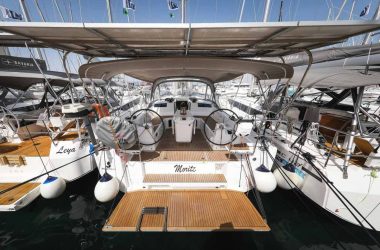
Electric Beneteau Oceanis 40.1 “Moritz”
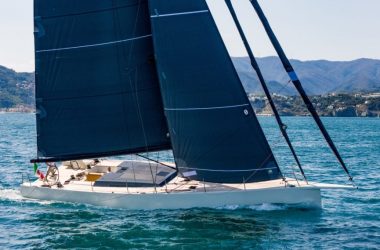
Maxi Dolphin MD55
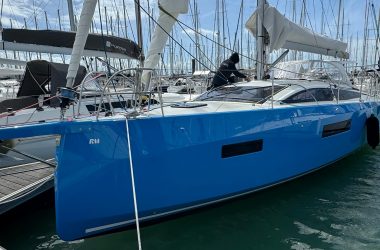
RM Yachts RM 1180
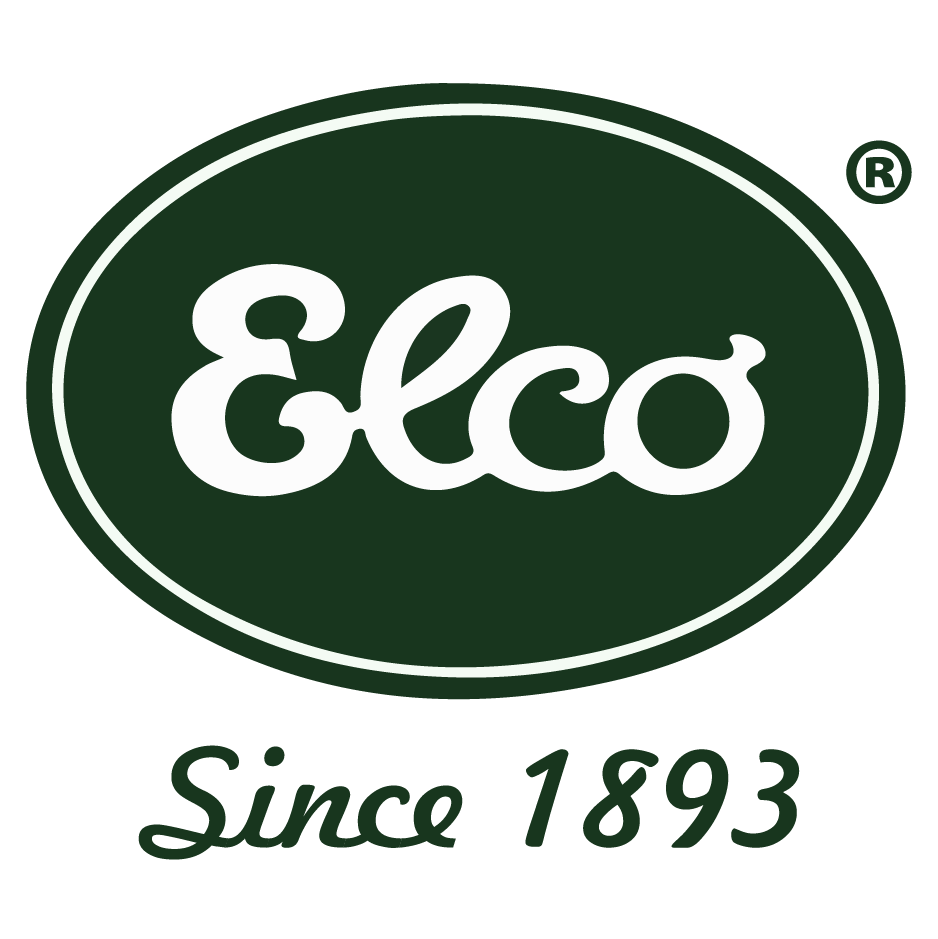
EP-50 Electric Outboard
$ 9,950.00
Comparable HP: 50HP Voltage: 96 Volts Suggested Battery Package Options: Deep Cycle AGM – Victron – 12V / 220Ah (8 pack) Lithium Iron Phosphate – 96V / 200Ah (4 pack minimum)
Congratulations on getting one step closer to purchasing your award-winning Elco Electric Outboard. Select the options and accessories below.
Download Dimensions Sheet
If your transom is 15″ or longer, a long shaft is recommended.
Step 2. Select Throttle Control, if remote throttle was chosen above.
(Remote throttle selection is not needed if tiller was chosen above)
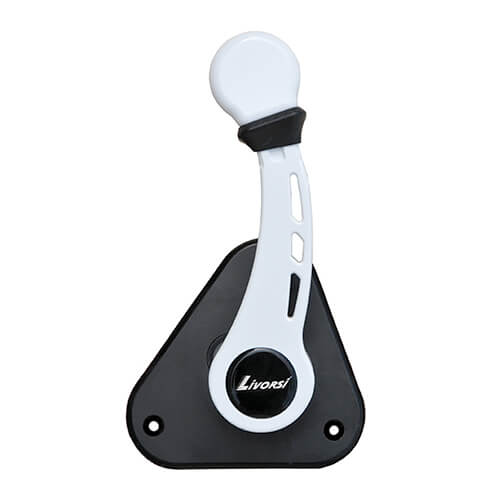
LIVORSI SIDE MOUNT REMOTE THROTTLE (Throttle Package)
$ 450.00
- 16-Foot Throttle Cable
- Motor cut-off switch.
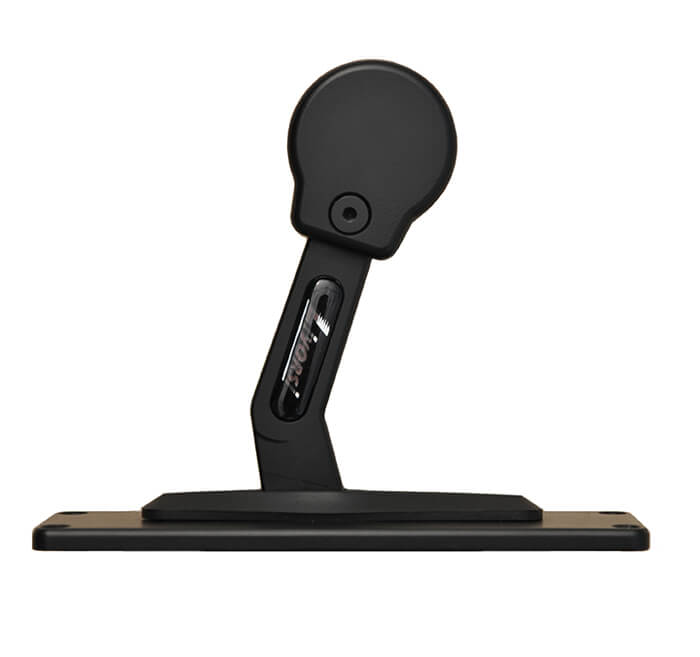
LIVORSI TOP MOUNT REMOTE THROTTLE (Throttle Package)
$ 650.00
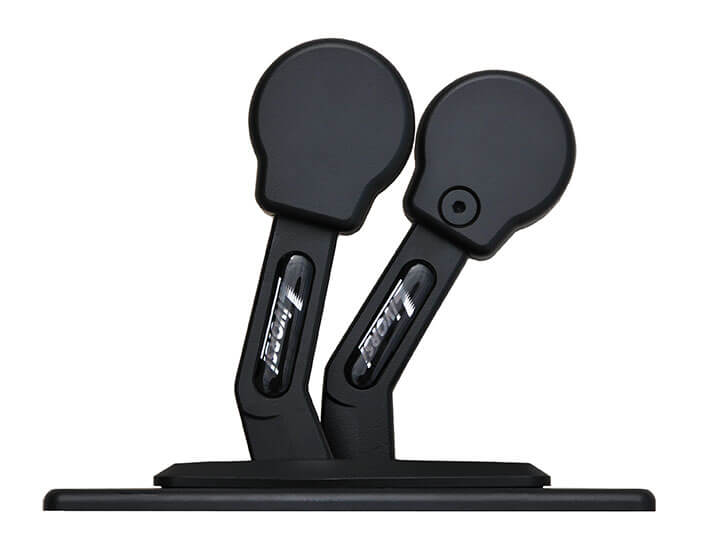
LIVORSI DUAL TOP MOUNT THROTTLE (Throttle Package)
$ 1,300.00
Step 3. Select Batteries & Charger
If you do not have batteries and a charger, you will need to select either AGM or Lithium batteries with the matching charger type. If you already have batteries but need a charger, select the applicable charger based on the type of battery you have.
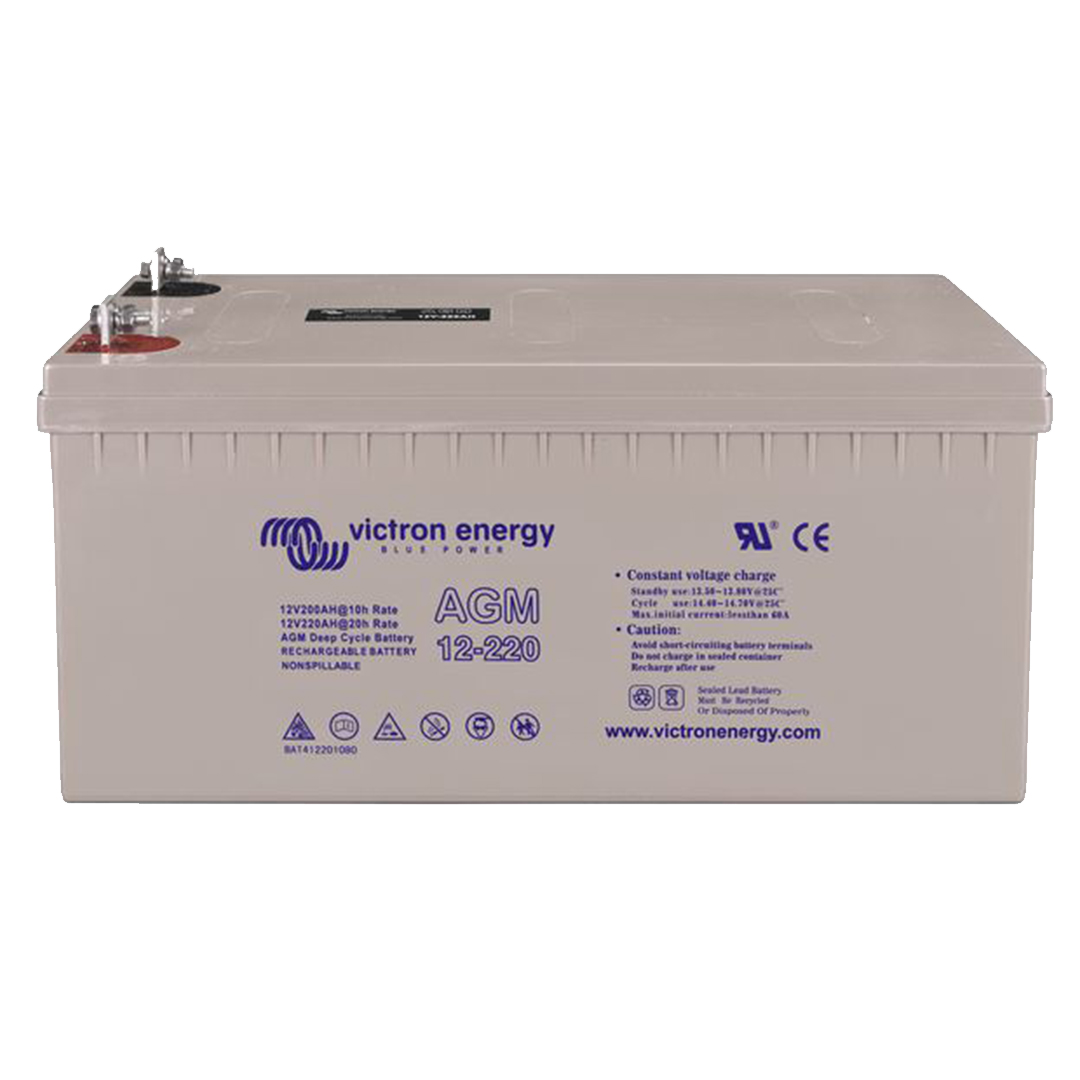
VICTRON 12V AGM – 220AH (8 PACK)
$ 5,352.00
96 Volt Power Supply, 8 Batteries – 12V / 220Ah | L-20.6″ x W-9.4″ x H-9.4″ | 143lbs ea.
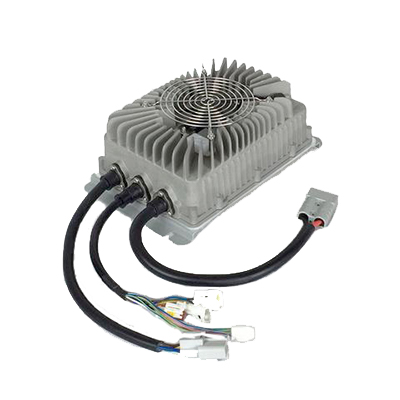
EV – AGM – 96V BATTERY CHARGER
$ 895.00
* Deep Cycle chargers are only compatible with Deep Cycle Batteries.
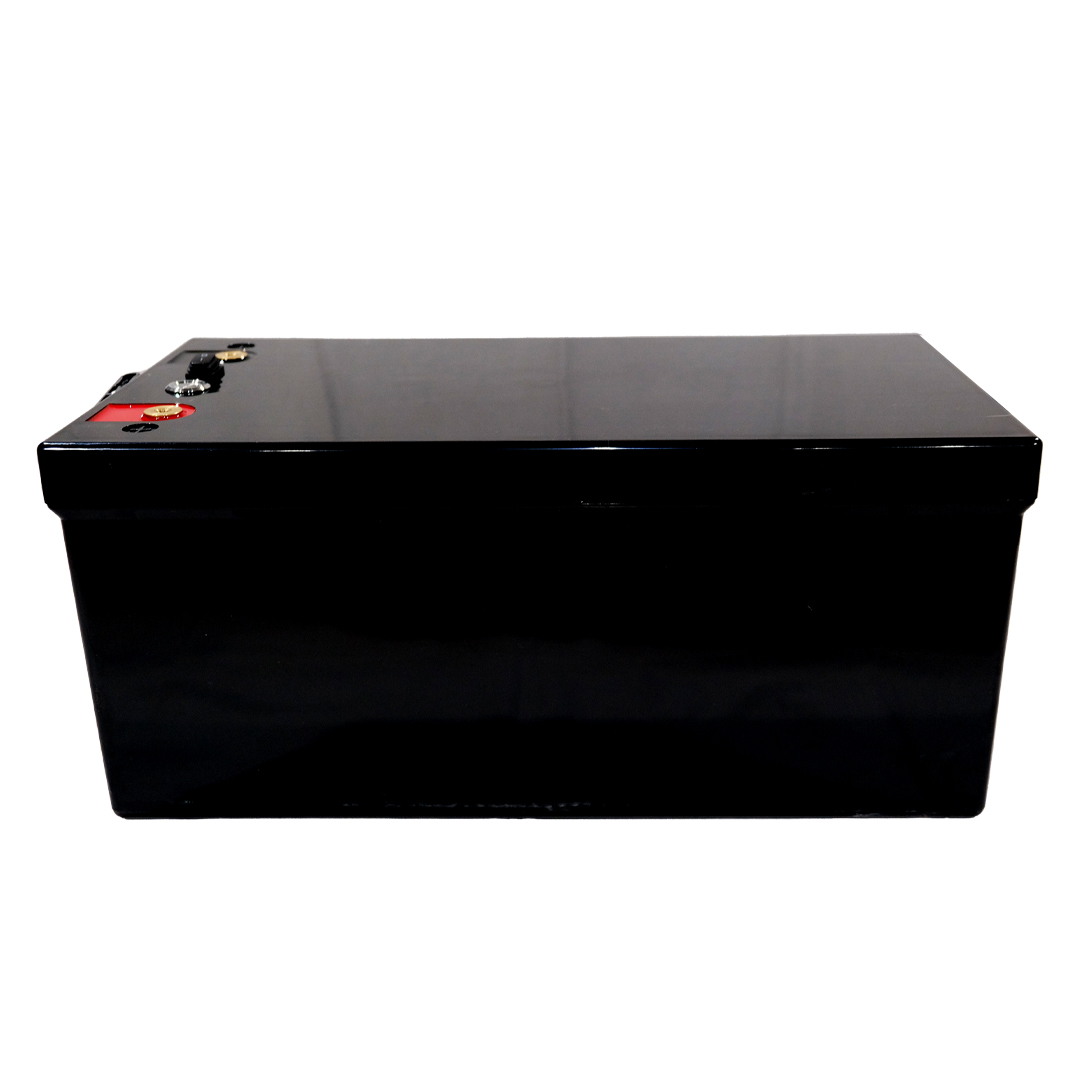
LITHIUM IRON PHOSPHATE BATTERY – 96V – 200AH = (4) 100AH BATTERIES
$ 11,800.00
Recommended Motors: EP-30 (96V- 4 pack) Size (L x W x H): 25″ x 9.8″ x 9″ Weight: 101lb/ea Long Life Cycle: Grade A LiFePO4 Cells make the 200Ah battery more stable, lighter, and greater.
LITHIUM IRON PHOSPHATE BATTERY – 96V – 300AH = (6) 100AH BATTERIES
$ 17,700.00
Recommended Motors: Outboards - EP-30 | EP-50 Inboards - EP-40 | EP-70 Size (L x W x H): 25″ x 9.8″ x 9″ Weight: 101lb/ea Long Life Cycle: Grade A LiFePO4 Cells make the 300Ah battery more stable, lighter, and greater.
LITHIUM IRON PHOSPHATE BATTERY – 96V – 400AH = (8) 100AH BATTERIES
$ 23,600.00
Recommended Motors: EP-50 (96V- 8 pack) Size (L x W x H): 25″ x 9.8″ x 9″ Weight: 101lb/ea Long Life Cycle: Grade A LiFePO4 Cells make the 400Ah battery more stable, lighter, and greater.
EV – LITHIUM – 96V BATTERY CHARGER
* Lithium chargers are only compatible with Lithium Batteries.
Step 4. Select Battery Connection Kit
Pre-assembled battery connection cables simplify motor installation. Our 7-foot electric battery cables and 18-inch battery jumper cables are adequately sized based on the motor amp draw. Swaged terminal ends are sealed with epoxy-impregnated heat-shrink tubing where they connect to marine-grade fuse blocks, Anderson motor connectors, and batteries.
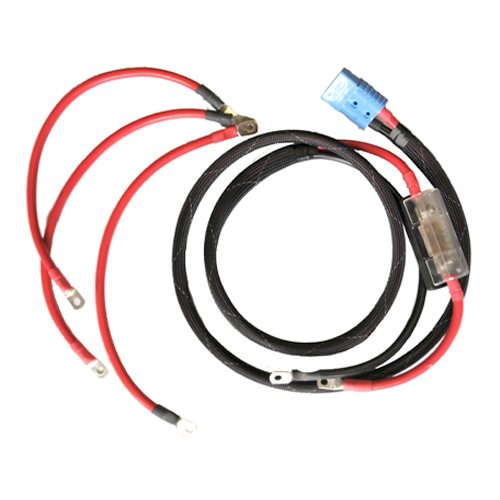
Battery Connection Kit | EP50-OB | 7 FT
$ 290.00
Use this 7ft Battery Connection Harness to connect your batteries.
Compatible with outboards: ep-50, step 5. select battery monitor.
Battery monitors help you take better care of your battery. Your battery monitor also provides real-time and historical information on voltage, power consumption, and more.
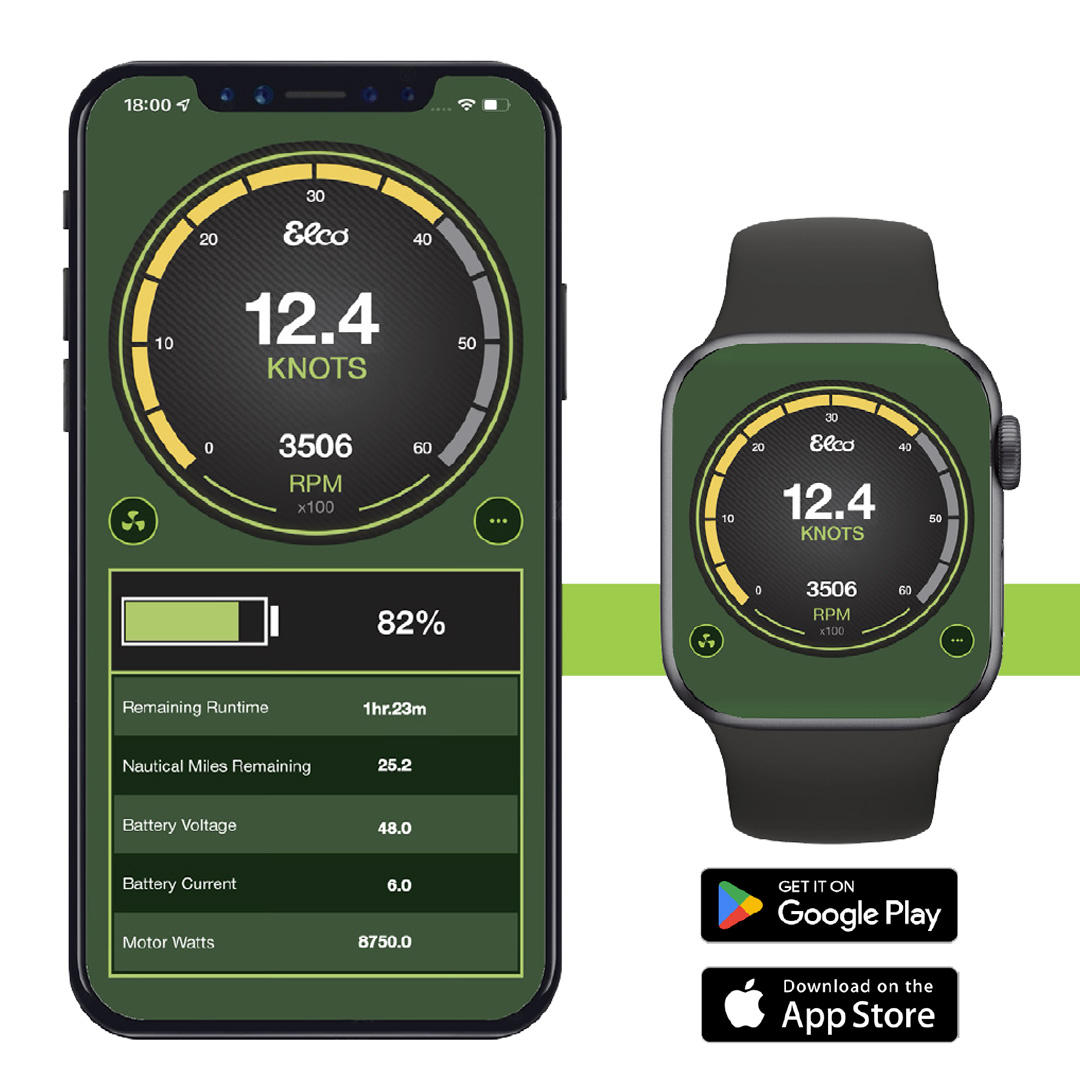
Elco DASH App – Bluetooth Connector
$ 345.00
Elco’s D ASH motor app wirelessly turns any iOS or Android mobile device into a full-function dashboard.
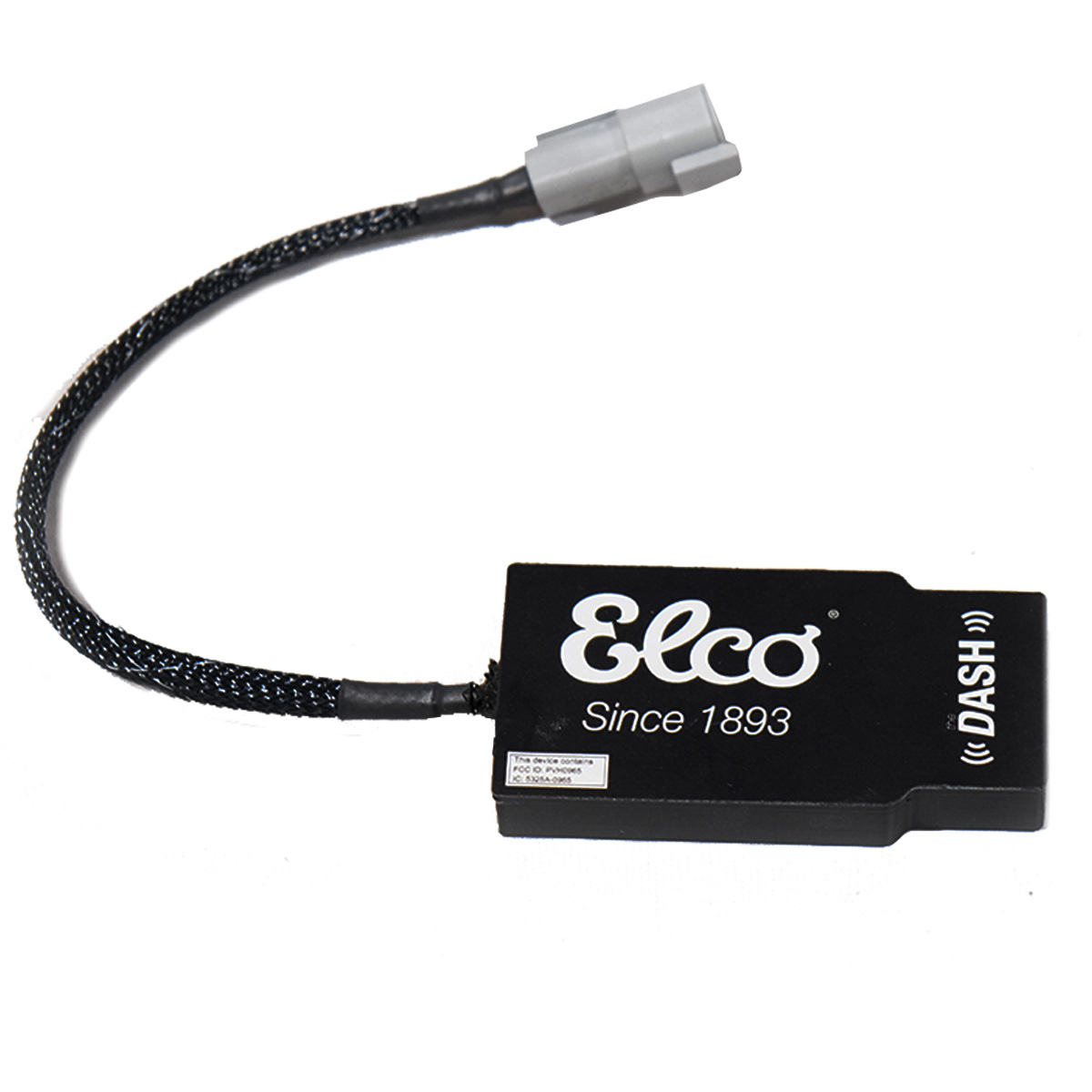
Click Store to Download after install

VICTRON BMV-700H
$ 728.00
This monitor is used to see how much charge you have left in your batteries.
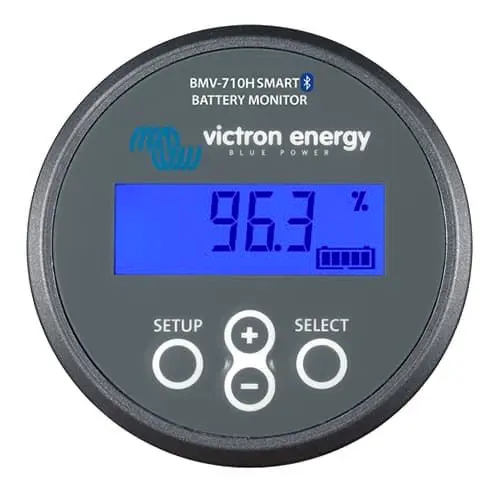
VICTRON BMV-710H- BLUETOOTH BATTERY MONITOR
$ 775.00
Step 6. Select Electric Trim and Tilt
Electric trim and tilt units simplify boat operation, increase performance and safety. This electric trim and tilt model matches this electric outboard.
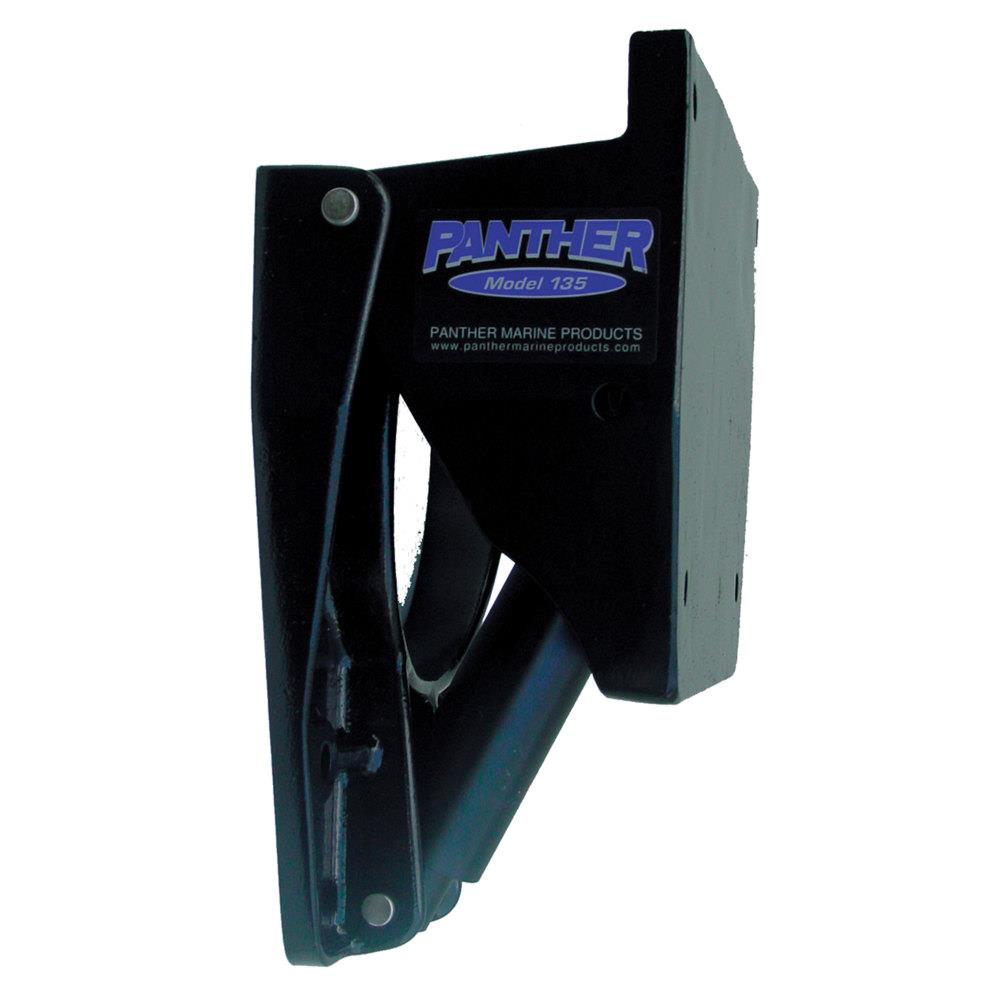
PANTHER ELECTRIC HYDRAULIC MODEL 135 TILT AND TRIM
$ 995.00
Electric trim and tilt
Product total
Options total
Grand total
- Description
Specifications
Experience a blend of history and innovation with Elco’s EP-50 electric outboard. This 50-hp electric outboard motor, built on a legacy dating back to the 1893 World’s Columbian Exhibition in Chicago, offers powerful and quiet propulsion for your boating adventures. The EP-50 electric outboard is more than just a motor; it’s a testament to Elco’s unwavering commitment to sustainability and technological advancement. Customize your 50-hp electric boat motor with accessories like remote throttles and a dash app for real-time battery charge monitoring. Journey with Elco Motor Yachts and make a difference with every nautical mile you traverse.
EP-50 ELECTRIC OUTBOARD FEATURES AND BENEFITS
• Reliable and durable construction with minimal maintenance required • Available in tiller or top- and side-mount throttle control • All motors available in long- or short shaft models • Traditional aluminum casting so replacement parts are readily available • Water-cooled system that prevents over-heating • Multiple safety precautions including over-speed protection, overload protection, temperature protection, over-voltage and over-current protection • Consistent power throughout the speed range • Brushless PMAC motor that is over 90-percent efficient • Cruise with peace of mind thanks to our “Get Home Safe” battery alert system • Clean cruising without the hassles and hazards of gasoline • Low cost of operation compared to traditional gas motors
See how easy it is to install the Elco electric outboard.
| 50 hp | |
| 26, 400 watts | |
| 96 VDC | |
| 275 amps DC | |
| Brushless PMAC | |
| 975 lb | |
| Water Cooled | |
| Remote control or Tiller option | |
| Side mount or Top mount option, 16′ length | |
| 6’ | |
| 2.08:1 (27/13) | |
| 8.5 ounces | |
| Manual or Electric | |
| 3- 9.875″ x 12 | |
| 190 lbs | |
| 17.5″ | |
| 45.4″ x 14.8″ x 27.7″ | |
| 22.5″ | |
| 50.4″ x 14.8″ x 27.7″ | |
| $9,950 |
Related products
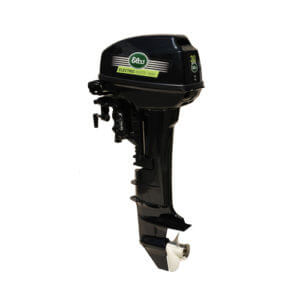
EP-30 Electric Outboard
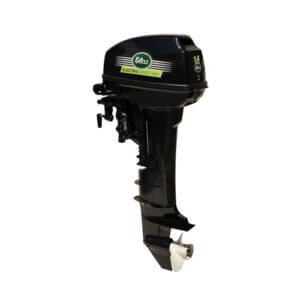
EP-14 Electric Outboard
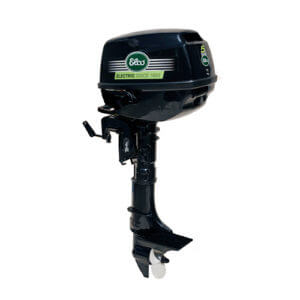
EP-5 Electric Outboard
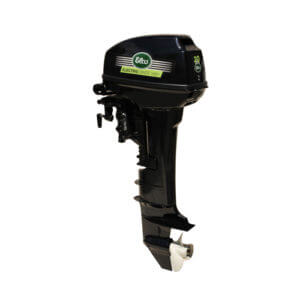
EP-20 Electric Outboard
Quick shopping links.
- Electric Outboard Motors
- Electric Outboard Motor 5 HP
- Electric Outboard Motor 9.9 HP
- Electric Outboard Motor 14 HP
- Electric Outboard Motor 20 HP
- Electric Outboard Motor 30 HP
- Electric Outboard Motor 50 HP
- Electric Inboard Motors
- Electric Inboard Motor 6 HP
- Electric Inboard Motor 12 HP
- Electric Inboard Motor 20 HP
- Electric Inboard Motor 40 HP
- Electric Inboard Motor 70 HP
- Electric Inboard Motor 100 HP
- Electric Inboard Motor 200 HP

Battery Chargers
- NOCO GEN 2 Deep Cycle Battery Charger
- NOCO GEN 3 Deep Cycle Battery Charger
- NOCO GEN 4 Deep Cycle Battery Charger
- NOCO GX2440 Lithium Battery Charger
- NOCO GX4820 Lithium Battery Charger
- EV- AGM / Lithium Battery Charger
- Electric Boat Motor Batteries & Accessories
- Elco Classic Launches
- Elco in the News
- Customer Stories
- Press Releases
- Get Updates
- Benefits of Going Green
- Our Technology
- Frequently Asked Questions
- Honoring Heroes
- Tell us about your boat
- Dealer Application
- Dealer Log-In
- Return Policy
© 2024 Elco Motor Yachts. All Rights Reserved. Sitemap.

- Privacy Overview
- Strictly Necessary Cookies
This website uses cookies so that we can provide you with the best user experience possible. Cookie information is stored in your browser and performs functions such as recognising you when you return to our website and helping our team to understand which sections of the website you find most interesting and useful.
Strictly Necessary Cookie should be enabled at all times so that we can save your preferences for cookie settings.
If you disable this cookie, we will not be able to save your preferences. This means that every time you visit this website you will need to enable or disable cookies again.
Practical Boat Owner
- Digital edition

Best electric outboard motors: 9 of the best options on the market
- Jake Kavanagh
- June 9, 2021
Electric outboard motors (where the motor is outside the hull) fall into three distinct categories, with some overlap: standard electric outboard, rim drives and pod drives, writes Jake Kavanagh

Portable electric outboards have no trouble moving even quite large hulls with relatively little power. This is an ePropulsion 1kW unit pushing a day sailer quite happily. Photo: Bill Doster
The electric motor is either sealed in an underwater casing, or housed above the waterline under a cowling, as in a standard petrol outboard . Keeping the motor below the water helps with cooling and makes an already quiet engine virtually silent. The downside to electric outboard motors is that they are more vulnerable to water ingress if the seals get damaged.
Above the waterline the electric outboard engine is easier to access, but the transmission is via a gearbox rather than direct drive so there will be some efficiency loss and a little more noise. However, this configuration allows much larger electric outboard motors to be installed as no submersible casing is required.
Our pick of the best electric outboard motors

4.5hp equivalent Mitek electric outboard looks much like a petrol engine
Mitek: 2.6-20hp electric outboard motors
Italian-based Mitek makes a series of outboards where the drive is enclosed under a cowling and the power is fed in from a separate battery bank.
“Our outboard sales are focused on the portable market, from 2.6hp up to the newest 15hp and 20hp,” says sales manager Silvia Peduto.
“Mitek outboards look familiar on the outside with a classic ultra-tested construction, but the inside is a completely different story. We have efficiency above 90%, a high and constant torque and lighter weight.
“The status of the motor and batteries is digitally under control on your phone. I would say that real innovation lies in higher efficiency and simplicity. All our products are designed to simplify our lives without compromising our ecosystem.”
Article continues below…

How to choose the right electric outboard engine
Marine electrician Jamie Marley explains what you should look out for when choosing an electric outboard engine for your type…

Why I chose serial electric hybrid propulsion with lead carbon batteries for my narrow boat
During the first lockdown in March 2020, my wife, Kay, and I began musing about the possibility of trying to…

DIY electric outboard motor: How to build your own electric engine
Olly Epsom explains how (and why!) he built his own 1kW electric outboard motor for under £600

Torqeedo has borrowed from big ship technology and placed a ‘swirl energy enhancer’ onto the boss of the propeller. This captures an extra 5% energy from the displaced water, extending battery range
Torqeedo Travel
The German-made Torqeedo 1103 Travel typifies a design where the motor unit is submerged. This 1kW motor is roughly equal to a 2hp petrol outboard, but with the obvious limitations of range. The 1103 nomenclature refers to the 1100W battery, which is detachable and weighs 17kg (37lb).
Torqeedo was arguably the pioneer of lightweight electric outboards but is now facing some stiff competition. As such, it has been refining existing models and producing new ones, with the redesigned 603 model (left) out in 2021. Both motors are IP67 waterproof, meaning you can immerse them to 1m for 30 minutes and they’ll still work just fine.
The control handle contains a built-in GPS and has an LCD display showing charge state, speed, estimated range and energy draw. The new generation of motors are exceptionally quiet, as earlier models were known for a distinctive whine. Now, thanks to new technology, the motor is described as ‘little more than a human whisper’ when under way.

e’dyn is producing outboard motors from 2kW to 11kW in power
e’dyn: 2.6hp-8hp electric outboard motors
A co-operation between Slovenian-based Podkrižnik and Italian-based e-concept, e’dyn is a good example of futuristic design and lightweight construction. The motor is housed conventionally under a cowling and fed from a separate battery bank.
A new ‘Free Time’ line of 2kW, 4kW and 6kW models will be available from 2021. e’dyn is also upgrading its popular 11kW model with a new communications protocol and a 25kW version will be available shortly. As with most modern outboards, energy management is a priority.
“We saw lack of customisable options in our old design so we are working on more open protocol-based systems that are user friendly,” said project manager Tomaž Murko.
“In the future there will definitely be significant improvement in battery chemistry and power management. With our new systems we will be able to replace old technologies or make small optimizations such as communication signals without a problem”.

TEMO 450 electric outboard motor
The latest option on the market is the TEMO 450 electric outboard, which we recently got a chance to test.
Marine technical editor Fox Morgan said: “I like the low-profile design, the speed of mounting and dismounting, the ease of carrying and stowing and the speed it charges.”
You can read their full review of the 2hp TEMO electric outboard online now.
Best rim drive electric outboard motors
Developed from commercial shipping applications, the rim drive uses the outer part of the tunnel as the stator, and the inner section as the rotor. Basically, this gives just a single moving part, with all the electrical components ‘potted’ in resin to be completely watertight.
Some designs even have inward-pointing blades, which allow ropes and nets to pass harmlessly through the central void without fouling.

RAD Propulsion’s 40kW RAD2
RAD Propulsion
Although a relatively new start-up, the team at UK-based RAD Propulsion has a long history in ‘extreme’ marine equipment. With skills gleaned in autonomous vessels, advanced composites and deep-sea submersibles, the result is a lightweight rim motor that will soon be available in a useful selection of outputs.
The RAD designs are all fully sealed, ruggedly-built in metal and composite and feature advanced electronic protocols that have the ability to ‘learn’ from the motor’s performance.
Energy data is downloaded to RAD HQ for refining the operational parameters as part of an ongoing development programme.
The first model is the 2kW RAD2 and will be followed by the RAD1 designed for paddle boards and kayaks. A larger 40kW RAD40 (pictured) version is due for launch at the end of 2021.

HY-Generation’s first model is the 6kW RIM6
HY-Generation
The French company HY-Generation is also exploring the versatility of the rim drive and has made two breakthroughs which, it says, has greatly increased the unit’s efficiency. The first is to introduce a hydrodynamic ‘stall’ into the tunnel to eliminate some of the vortex restrictions associated with high-speed running and reverse.
The result is an improvement in range claimed to be around 35%. The second is with the blade design, which can now pivot freely depending on loading and speed.
This variable pitch is also said to reduce energy consumption and is the principle behind more conventional e-propellers such as Brunton’s Eco Star. The company’s first model is the 6kW RIM6 (pictured) which weighs in at just 12kg (26lb).

Vetus E-POD
Netherlands-based Vetus has developed the E-POD (pictured), a rim drive with a central hub which they say has been thoroughly tested in the ‘bicycle-filled’ canals around Amsterdam and has escaped without damage. “The propeller itself is the rotor of the permanent magnet motor.
Because there are no gears, transmission or shaft, the truly direct drive is extremely efficient,” says Vetus’s Jan van Dijk. “We have calculated efficiency of up to 95%.
“Another huge advantage is there are no rotating parts onboard of the boat, meaning no vibration. Having minimal machinery inside the hull also optimises the available boat space. Having the whole system designed in a ring and tunnel also minimises cavitation.”
Best pod drive electric outboard motors
A development of the electric outboard, the submersible motor is either fixed to a mounting under the hull, or to a steerable through-hull shaft. Some can even be mounted on the rudder to act as a directional thruster. The power cable is usually fed down through the pod’s control shaft or attachment flange for protection.

Seadrive ‘puller’ unit
Norwegian-based start-up Seadrive began with the premise of a steerable ‘puller’ (pictured right) or ‘pusher’ pod capable of efficient regeneration. Most striking is the swept shape of the propeller, which spins efficiently when sail-milling. The control unit has also been set to optimise the energy produced.
The Seadrive unit is also rotatable for directed thrust and can be turned through 180° so the propeller is facing forwards (or rearwards on ‘pullers’), opposing its usual drive orientation.
This greatly improves the auto-rotation speed, something already used by companies such as ZF on their steerable re-gen saildrives.

The DeepSpeed pod drive from Sealence
Italian company Sealence has developed a pod drive with some closely guarded technology within its ‘aircraft jet engine’ style cowling.
The drive compresses and ejects water electrically and is designed to run from a generator, although it can also be battery fed.
Originally intended for fast ferries and large yachts, the DeepSpeed model is also available in much smaller units for leisure craft.

ePropulsion’s EVO
ePropulsion
ePropulsion has taken its outboard motor technology and developed it as the EVO range of pods. The big advantage of this design is it also produces significant hydro-regeneration, but no loading is placed on the prop until a suitable speed is achieved.
The company is using advanced electronic protocols to maximise battery efficiency with mobile phone apps to keep tabs on range, energy consumption and speed. The EVO is offered in three units: 1kW, 3kW and 6kW.
Read Ali Wood’s review of the 2hp ePropulsion electric outboard motor
Can you build your own electric outboard motor?
It’s not easy, but a couple of intrepid boaters have had some success creating DIY electric outboard motors .
One impressive example is PBO reader Olly Epsom who explained to us back in 2018 how (and why!) he built his own 1kW electric outboard motor for under £600.
What about inboard electric boat motors?
In addition to all the above, there are plenty of options for converting your boat to run off inboard electric motors these days.
Jake Kavanagh recently spoke to four boat owners who’d converted to electric power and explained how it can be done, right the way up to a 46fter powered by twin 10kW (13.4hp) Oceanvolt Servoprop electric saildrive units.
Why not subscribe today?
‘Best electric outboard motor: 9 of the best options on the market’ first appeared in the July 21 edition of Practical Boat Owner . For more articles like this, including DIY, money-saving advice, great boat projects, expert tips and ways to improve your boat’s performance, take out a magazine subscription to Britain’s best-selling boating magazine.
Subscribe, or make a gift for someone else, and you’ll always save at least 30% compared to newsstand prices.
See the latest PBO subscription deals on magazinesdirect.com
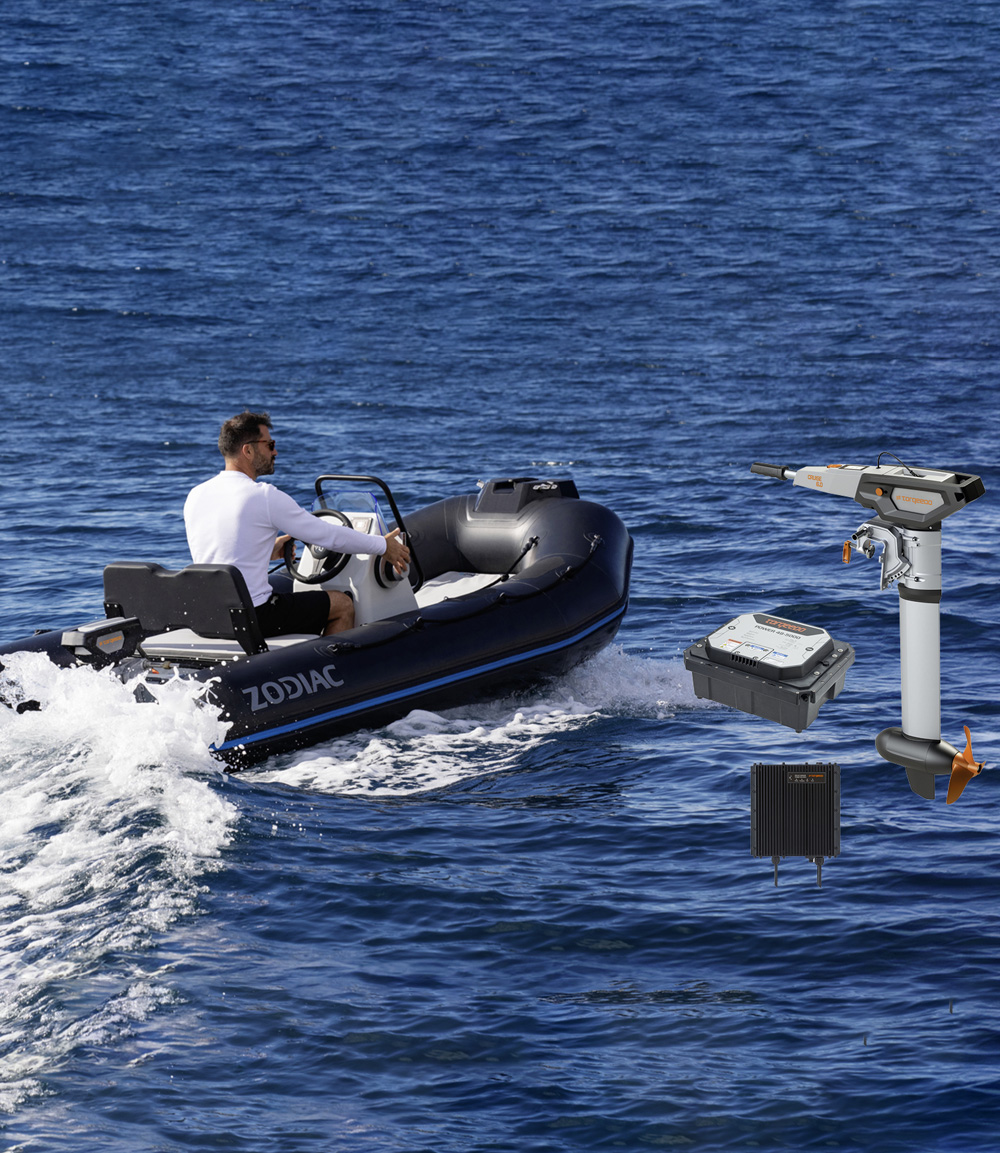
JavaScript functionality for your browser has been deactivate. Please activate JavaScript so you can use all functions on this page.

The Best Outboard Motor for a Sailboat

Last Updated by
Daniel Wade
June 15, 2022
The technology of sailing has remained mostly unchanged for centuries. Since learning to harness the power of wind, sailors have been transiting the world’s oceans, expanding trade routes and exploring new cultures. Although nothing more than a renewable natural resource and a single sail is needed to move a sailboat along the water, there are times when it’s important (and in our modern age, convenient) to leverage off a motor to get you where you need to go.
Like any unique piece of equipment in the world of sailing, outboard motors come in a variety of sizes with features and options to fit any owner’s needs. But of course, one size doesn’t fit all. Every boat is different – even those that come off the production line at the same time – and every owner is looking for something specific when it comes to their sailboat. From the purpose of owning the boat (blue water sailing vs. racing) to the location and impact on maintenance (cold weather vs. tropical weather), an outboard motor is just one of the many elements that will define a sailboat’s function and performance.
Whether you’re a new owner, or a veteran sailor, it’s important to know the basic components of any outboard motor . You should also have an idea of what you want your outboard motor to do for your size and model sailboat.
Table of contents
Outboard Motor Size
A larger boat doesn’t necessarily mean a larger motor. Although there are different ratings for different classes of boats, a small power plant can be more effective than a larger one. Conversely, an outboard motor can easily overpower a small boat and create unsafe conditions at high speeds. Guidelines and requirements differ between motorboats and sailboats. And while there is some overlap, these considerations apply directly to sailboats.
Engine power has to do with how much water a boat displaces. For sailboats, smaller is better. If you’re a bit of a math geek, the exact formula is 4 horsepower for every 2200lb of weight. Coupled with a propeller size, which can be determined using a propeller calculator , you’ll get a rough estimate to use as a guideline to start shopping. This is a good first step, since size is essentially a fixed variable. Though it’s worth noting for those who are buying a sailboat directly from the manufacturer, that actual weight will increase after delivery – once all other rigging and outfitting has been completed.
Physical size of your outboard motor is an important consideration and is directly related to the design of your sailboat. An outboard motor is made up of three parts from top to bottom:
- The Powerhead – Houses the engine. The bulbous part of the motor.
- The Midsection – Houses the exhaust system. Varies in length and design.
- The Lower Unit – Propellers attach to the gearbox. Submerged when operational.
Shaft length is an important design element and should be considered when purchasing a motor. A shaft that is too short will obviously prevent the propeller from being submerged in water, while a shaft that is too long will extend the propellers too far. Not only will it decrease the efficiency of your engine, it will create unnecessary drag. Know your transom length when looking at different models.
When an outboard motor is not being used, it should be stowed in its upright position. Some of the larger motors have an automated switch that will raise it out of the water, but some must be secured manually. Make sure everyone who sails with you is capable of lifting and securing the motor out of the water in case of an emergency.
Outboard Motor Power
Any kind of motor installed on a sailboat (inboard or outboard) should be viewed as a tool to help with maneuvering. Although there are some very skilled sailors out there who can sail into their slip without the aid of a motor, many harbors have restrictions that either don’t allow for the use of full sails, or there simply isn’t enough room to maneuver. A motor with both forward and reverse gears helps tremendously with docking.
While there is no exact correlation between boat length and total weight, the following is a rough guideline:
- 1-4 HP for boats up to 20’ (approximately 1000-2000lbs)
- 4-18 HP for boats between 20-30’ (approximately 2,000-10,000lbs)
- 18-34 HP for boats between 30-40’ (10,000lbs or more)
There are some things to consider when deciding how much horsepower you need or want. Location and the type of conditions you expect you’ll be sailing in is one of the biggest factors. Heavy seas and high winds typically associated with open ocean sailing will put more strain on your engine, and in some cases overpower it, whereas an engine that is heavier than needed will add unnecessary weight when racing. If you plan on motoring for long distances, consider purchasing an engine that will stand up to a lot of use.
Less HP is required for:
- Boat Design – Single hull boats made out of fiberglass require less power.
- 2-Stroke Engines – This is due to an overall lighter weight engine and higher torque.
- Diesel Engines – Diesel delivers more torque because the rate of compression is greater.
- Bigger Propellers – More surface area means more water displacement.
- Location – Motoring on lakes and rivers requires less power than open ocean.
- Distance – A smaller engine is suitable for shorter distances.
More HP is required for:
- Boat Design – Catamarans and heavier boats (regardless of size) require more power.
- 4-Stroke Engine – Engine weight and an extra step of compression yields less power.
- Gas Engines – The rate of compression for gas engines is much lower than diesel.
- Smaller Propeller – A smaller propeller displaces less water.
- Location – Open ocean, with tides and currents, will strain a smaller engine.
- Distance – Cover more distance when wind conditions are poor requires a larger engine.
Outboard Motor Cost
There is no way to quantify how much you will pay for any given motor. But there are several costs associated with owning an outboard motor that are definitely worth considering when making your purchase.
Certainly, a lager, more-powerful engine is going to be costlier than a smaller engine with lower horsepower. But as mentioned earlier, size is not necessarily a guarantee of performance and efficiency. At the same time, there’s only so much you can get out of an engine before you exceed its capability. Larger engines tend to help with resale value should you choose to sell your boat at some point, but a boat outfitted with right motor to begin with will always perform better than a motor that’s large just for the sake of it.
Factor in maintenance costs and fuel when looking at models. You want to run your engine at around 90% of its max RPMs to balance proper fuel usage and with wear and tear. Making a few calls to marine mechanics to inquire about an engine you’re interested in will give you a lot of information a sales person won’t be able to give you. The good news about outboard motors is that most of them are portable, which means you won’t have the added cost of either paying a mechanic to come to you, or having to get your boat to the yard, which usually requires help from a very good friend willing to spend all day driving and sailing back and forth.
Owning a boat requires constant care and maintenance, so a little knowledge goes a long way. While an outboard motor is not required for sailing, it’s a convenient addition that can greatly increase your enjoyment out on the water. Being patient and spending time researching engines will not only help you make the correct purchase but will help you take advantage of a great deal when it presents itself. Whether you sail the Caribbean, or race off the coast of California in a catamaran, there is an outboard motor that’s just right for you.
Related Articles
I've personally had thousands of questions about sailing and sailboats over the years. As I learn and experience sailing, and the community, I share the answers that work and make sense to me, here on Life of Sailing.
by this author
Sailboat Upgrades
Most Recent

What Does "Sailing By The Lee" Mean?
October 3, 2023

The Best Sailing Schools And Programs: Reviews & Ratings
September 26, 2023
Important Legal Info
Lifeofsailing.com is a participant in the Amazon Services LLC Associates Program, an affiliate advertising program designed to provide a means for sites to earn advertising fees by advertising and linking to Amazon. This site also participates in other affiliate programs and is compensated for referring traffic and business to these companies.
Similar Posts

How To Choose The Right Sailing Instructor
August 16, 2023

Cost To Sail Around The World
May 16, 2023

Small Sailboat Sizes: A Complete Guide
October 30, 2022
Popular Posts

Best Liveaboard Catamaran Sailboats
December 28, 2023

Can a Novice Sail Around the World?
Elizabeth O'Malley

4 Best Electric Outboard Motors

How Long Did It Take The Vikings To Sail To England?

10 Best Sailboat Brands (And Why)
December 20, 2023

7 Best Places To Liveaboard A Sailboat
Get the best sailing content.
Top Rated Posts
Lifeofsailing.com is a participant in the Amazon Services LLC Associates Program, an affiliate advertising program designed to provide a means for sites to earn advertising fees by advertising and linking to Amazon. This site also participates in other affiliate programs and is compensated for referring traffic and business to these companies. (866) 342-SAIL
© 2024 Life of Sailing Email: [email protected] Address: 11816 Inwood Rd #3024 Dallas, TX 75244 Disclaimer Privacy Policy

Home » Blog » Gear » Buyers guide to electric boat motors (2023)
Buyers guide to electric boat motors (2023)
By Author Fiona McGlynn
Posted on Last updated: August 3, 2023
Considering making the switch to an electric boat motor? With electric vehicles now commonplace on the roads, it’s no wonder so many boaters are curious about electric boats.
While electric boat motors have been around for a while, in the last several years the technology has taken huge leaps, resulting in more powerful motors, longer-lasting batteries, and ultimately more options for recreational boat owners.
Today, many types of boats can be outfitted with an electric propulsion system including pontoon boats, sailboats, jon boats, powerboats, fishing boats, yachts, and trawlers . If your boat’s combustion engine is in the range of 1 to 135 hp (.75 to 100 kW), you should be able to find an electric substitute.
While electric boating hasn’t gone mainstream—it’s estimated that close to 2% of recreational boats are electric—it’s still a great time to be thinking about making the switch, particularly if you own a tender, sailboat, or boat on a green lake where combustion engines are prohibited.
Table of contents
- 1.1 Benefits
- 1.2 Drawbacks
- 2.1.1 Key features of electric outboard boat motors
- 2.1.2 Electric outboard manufacturers
- 2.2.1 DIY electric inboard boat motor conversion
- 2.2.2 Key features of electric inboard boat motors
- 2.2.3 Electric inboard manufacturers
- 2.3.1 Serial vs. parallel hybrids
- 2.3.2 Key features of marine hybrids
- 2.3.3 Marine hybrid manufacturers
- 2.4.1 Electric pod and sail drive manufacturers
- 3 Batteries
- 4 Ready to catch the electric boating wave?
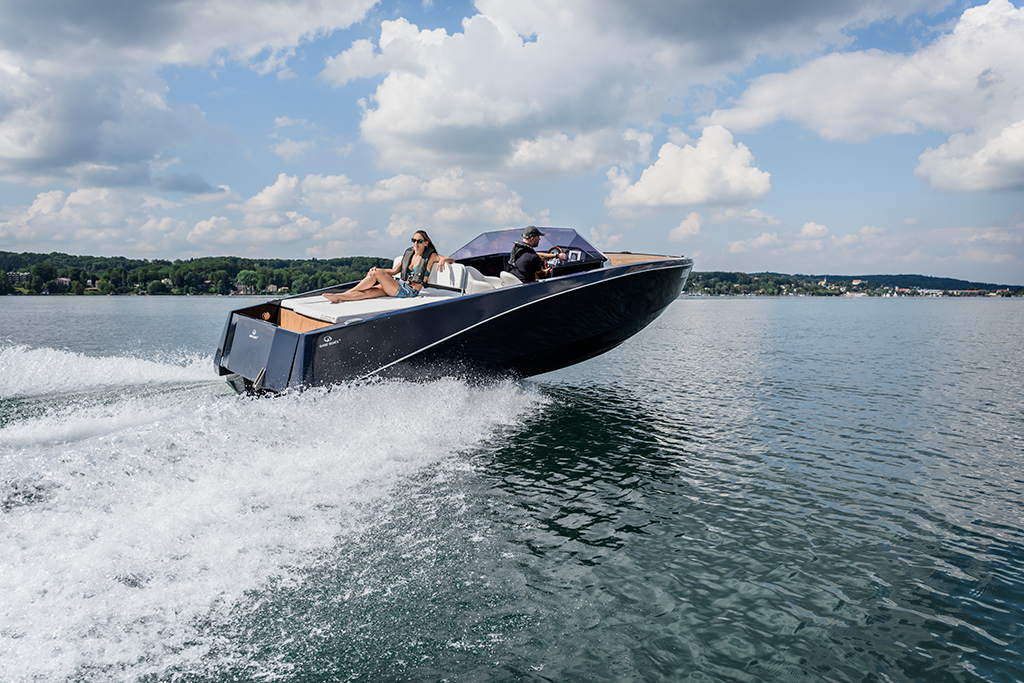
Benefits and drawbacks of electric boat motors
Electric marine motors offer several advantages over internal combustion engines:
- They’re completely silent .
- No noxious fumes or smelly exhaust gases to deal with.
- Instant torque. Electric propulsion provides instant torque, giving you better maneuverability and more consistent speeds in choppy conditions.
- Lightweight. An electric setup (including motor, batteries, and generator) typically weighs less than its diesel counterpart.
- No fuel cost. Charging an electric boat may cost a couple of dollars per charge.
- Easy to maintain. Imagine the maintenance on an outboard with no gas, spark plugs, or oil! Electric motors are simple, more reliable, and virtually maintenance-free.
- Renewable power. Once you’ve gone electric you can get power from renewable sources like wind generators and solar panels.
- Better for the planet. Electric marine motors don’t produce water pollution or produce harmful emissions like carbon dioxide (CO2), nitrogen oxides (NOx), and hydrocarbon (HC).
- Range. The greatest drawback of electric boats is their limited range, which is often measured in the 10s of miles. Range is limited because batteries don’t have the same energy density as fuel — they can’t provide the same energy, pound-for-pound as a tank of gas. A good battery monitoring system, one that displays the remaining range in real-time, can help boaters manage energy consumption and ease range anxiety. For those who want to go farther afield, hybrid propulsion may be a better option.
- Upfront cost. This new technology isn’t cheap. For example, a small electric outboard boat motor may sell for two-and-a-half times the cost of a gas outboard. However, prices are expected to come down as the industry reaches scale.
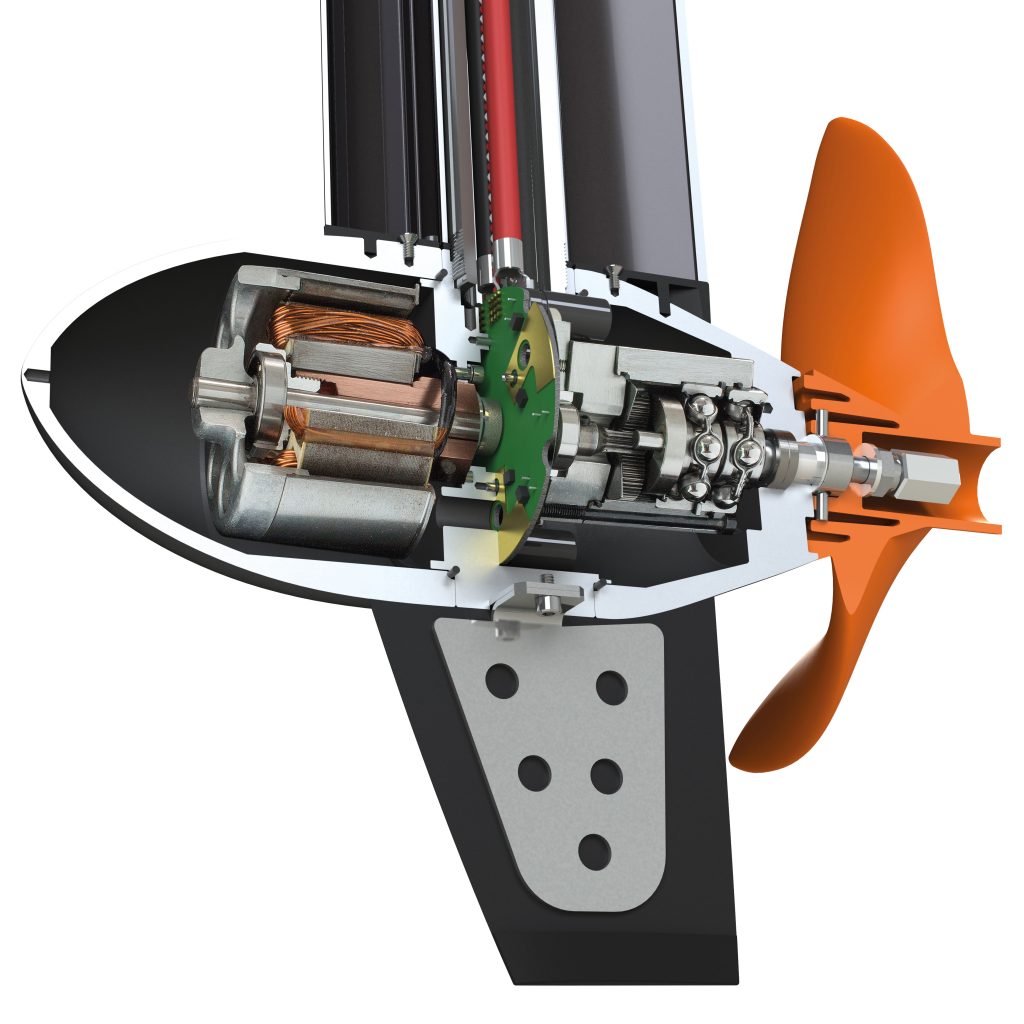
Types of electric boat motors
Electric outboard boat motors.
Some of the first electric outboards to hit the recreational boating market were smaller electric motors, typically used as trolling motors on fishing boats.
Today, it’s possible to buy far more powerful electric outboard motors in the 1 to 80 hp (.75 to 60 kW) range , with ever more powerful versions hitting the market each year. In 2022, Norwegian start-up, Evoy launched the world’s most powerful outboard to date, the 225kW Storm, a 300-hp beast of an electric outboard!
The range on electric outboard boat motors varies dramatically depending on your boat, total weight, propellor, and battery capacity .
The range also depends on how fast you want to travel. If you go slowly you’ll have a much greater range.
For instance, at a slow speed (5 knots) Torqeedo’s Deep Blue 50R , a 50 kW motor (80 hp equivalent) with a 40 kWh battery, has a listed range of 33-100 nm. But at full throttle (20-25 knots), the listed range drops to 16-20 nm.
To get a better sense of what range to expect on your boat (at both low and high speeds), you can look at the manufacturer’s website. See our list of electric outboard brands below.
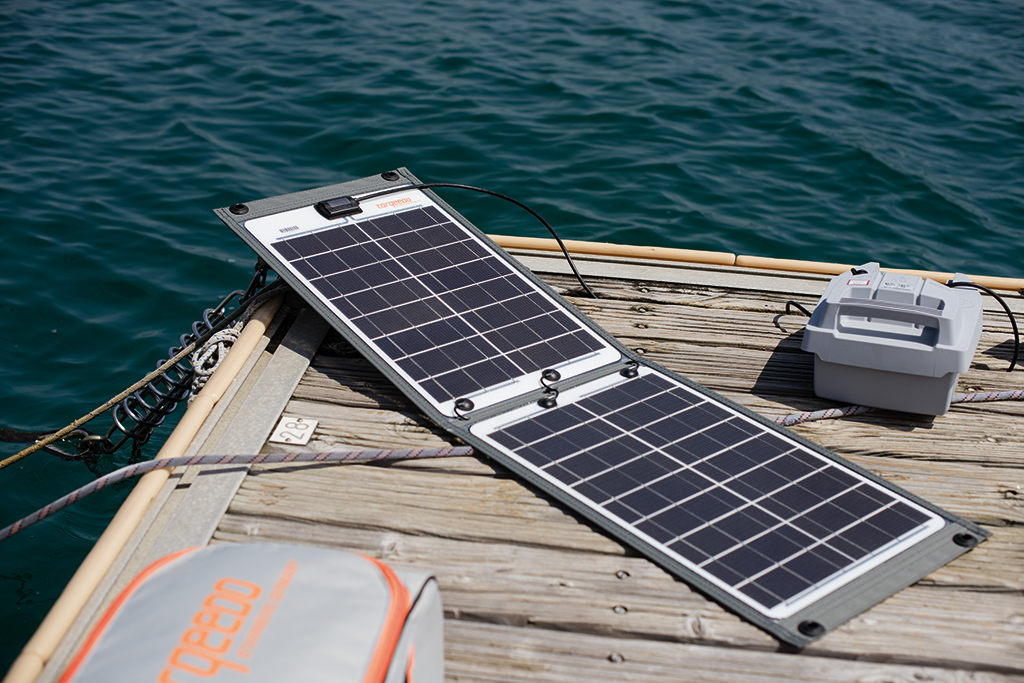
One of the great things about electric outboards is that they can use renewable power sources. So, for instance, you could plug your boat into a portable solar panel while picnicking and get an extra boost for the trip home.
Some electric outboard boat motors can even generate power! Motors with hydro regeneration capabilities can charge the batteries while the boat is being towed or under sail.
While hydro regeneration is a fairly new feature for electric outboards, some manufacturers, like EPropulsion, are offering it across their outboard product line.
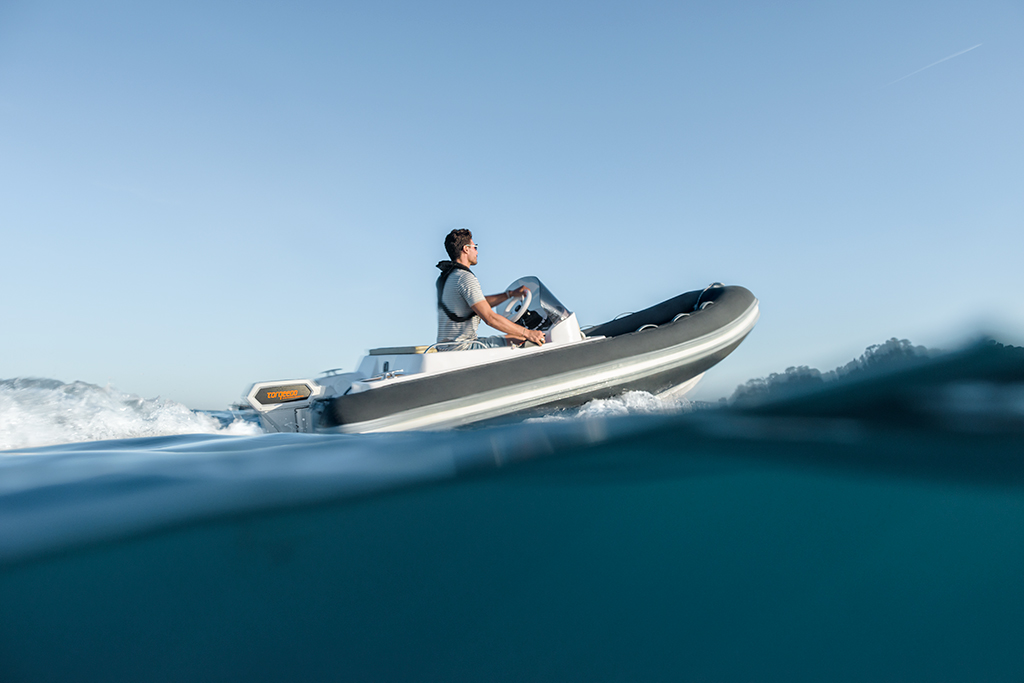
Key features of electric outboard boat motors
Each electric outboard motor brand has slightly different standard offerings and add-on features. Here are some of the key features and options to look for.
- Waterproof. Some electric outboards are fully sealed and designed to withstand immersion
- Remote controls. Choose between tiller and remote throttle controls
- On-board computers . Some electric outboards come with chartplotter connectivity, navigation functions, sonar, GPS anchoring, and autopilot features
- Built-in or stand-alone batteries. Some of the smaller motors come with built-in batteries, while the larger ones have separate battery packs
- Battery monitoring and tracking systems that calculate and display the remaining range in real-time
- Shaft length. Electric outboards come in both short and long shaft lengths to accommodate a variety of applications.
- Hydro regeneration capabilities
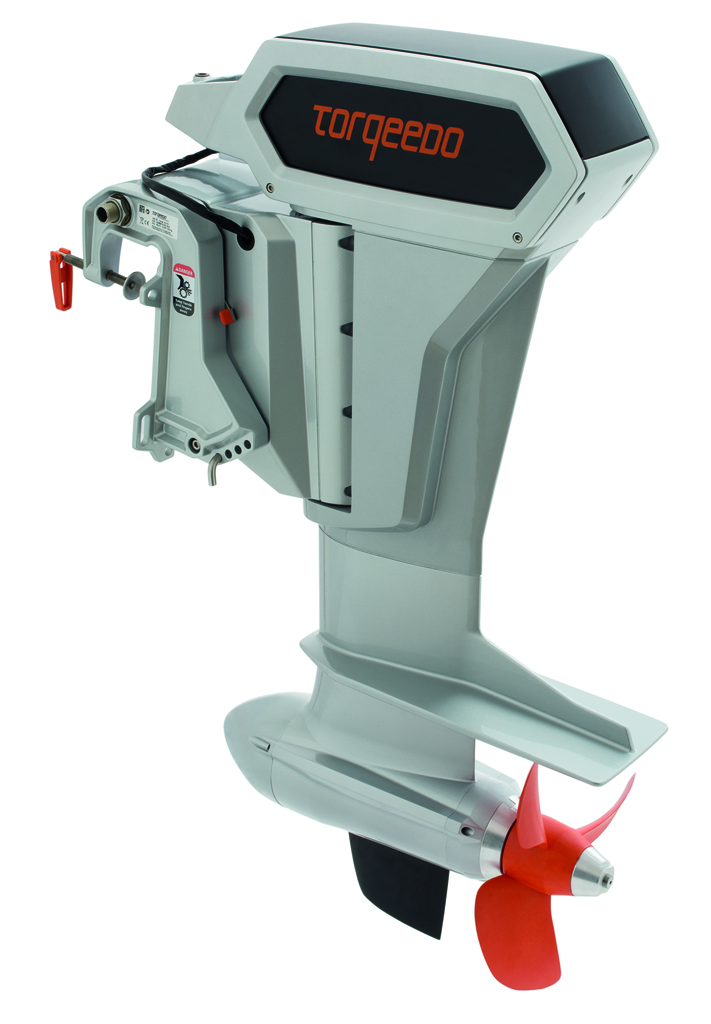
Electric outboard manufacturers
These electric outboard boat motor manufacturers (listed in alphabetical order) range from small startups to large companies and serve the North American market.
If you’re looking to learn more about what each of these companies offers (and how they compare) I’d highly recommend checking out the Plugboats’ electric outboard guides and directories . Jeff Butler, the editor at Plugboats has done a great job of compiling motor specifications from across the market.
Headquartered in San Diego, California, Bixby makes a small electric motor system for kayaks, inflatable boats, canoes, and paddleboards.
Elco has been building electric motors for 125 years and counts the likes of Henry Ford and Thomas Edison among their customers. Their award-winning electric marine motors range from 5 to 50 hp. The company is based in Lake George, New York, and its electric motors can be found on boats around the world.
Flux Marine
Flux Marine was founded by mechanical engineering Princeton grads and offers three outboard models—a 40 hp, 70 hp, and 100 hp. In 2021, they won an award for the best new green product at the Newport International Boat Show.
Joe Grez, a consumer product developer from Washington, invented the EP Carry , a compact, ultralight electric outboard system because he was concerned about exposing his young daughter to the carbon monoxide (CO) emissions produced by gas outboards.
The EP Carry retails for $1,600 and is a great size for small vessels like dinghies, canoes, inflatable boats, and kayaks.
ePropulsion
ePropulsion , based in Guangdong, China, manufactures 3 to 9.9-hp electric motors for sailboats, fishing boats, as well as dinghies and tenders. They all come with hydro regeneration capabilities.
Mercury Marine launched the Avator 7.5 electric outboard (3.5 hp equivalent) in early 2023. The leading outboard manufacturer is currently developing more powerful 20e and 35e models which it plans to release later this year.
In 2023, Newport , a well-known US-based inflatable boat manufacturer, launched three small outboards ranging from 1.8 to 3 hp.
If you’re into fishing, you’re probably familiar with the Minn Kota name, derived from MINNesota North DaKOTA, prime fishing country where the company has its roots. They introduced their first electric trolling motor back in 1934 and they’ve been making them ever since.
Pure Watercraft
Pure Watercraft was founded by CEO Andy Rebele in Seattle in 2011. Their 25 kW (50 hp) motor starts at $16,500.
Ray Electric Outboards
Ray Electric Outboards is a 3rd generation family-owned business based in Cape Coral, Fl. They manufacture one outboard model that can be operated at different power ratings ranging from 10 to 22 hp.
Stealth Electric Outboards
The 50 and 75-hp Stealth electric outboards were developed by Scott Masterston of Houston, Texas.
German manufacturer, Torqeedo , has been leading the propulsion industry for years and sells some of the best e outboard motors in the 1 to 80-hp range
Vision Marine Technologies (formerly The Canadian Electric Boat Company).
Based in Quebec, Canada, Vision Marine Technologies has been in the boating industry for 25 years and produced some very innovative electric boats. In 2021, they launched E-Motion 180E, one of the most powerful electric outboards on the market.
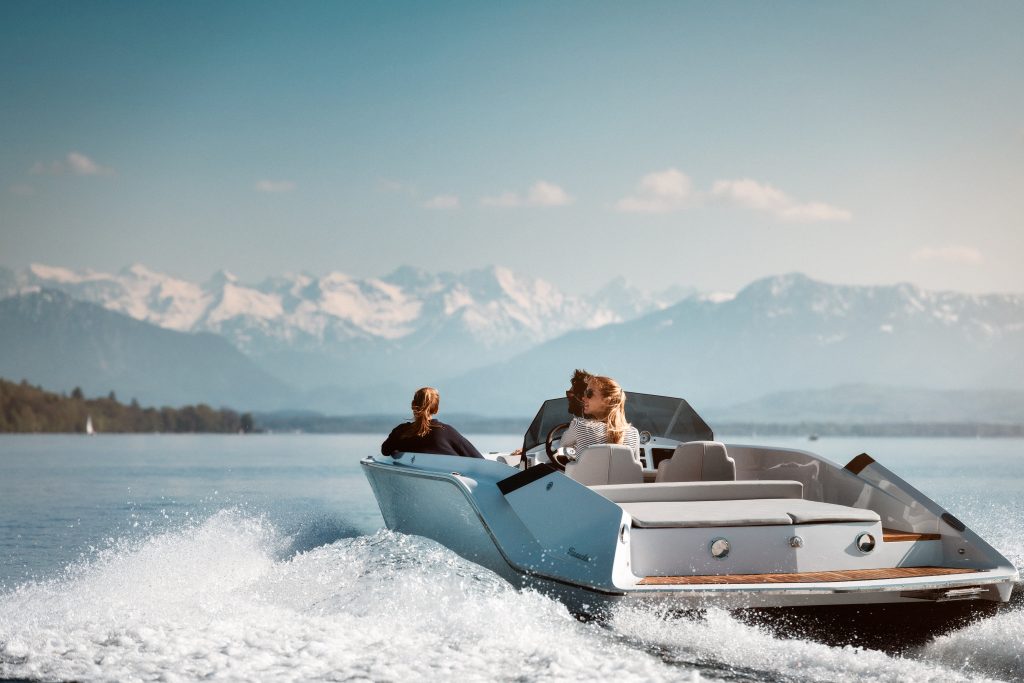
Electric inboard boat motors
Today’s electric inboard motors can provide anywhere from 3- to a whopping 330 hp (2 to 246 kW) and are used in a range of applications from heavy displacement vessels to fast, planing powerboats.
Similar to outboards, the range on electric inboard engines will vary based on your boat, load, battery capacity, and boat speed (among other things).
However, with an inboard electric boat motor, you have the option of a hybrid motor which can significantly extend your range. We’ll discuss the pros and cons of hybrid boat motors later in this post.
Sailors may also want to consider choosing an inboard electric motor with hydro regeneration capabilities. These electric power motors can charge the battery while the boat is under sail.
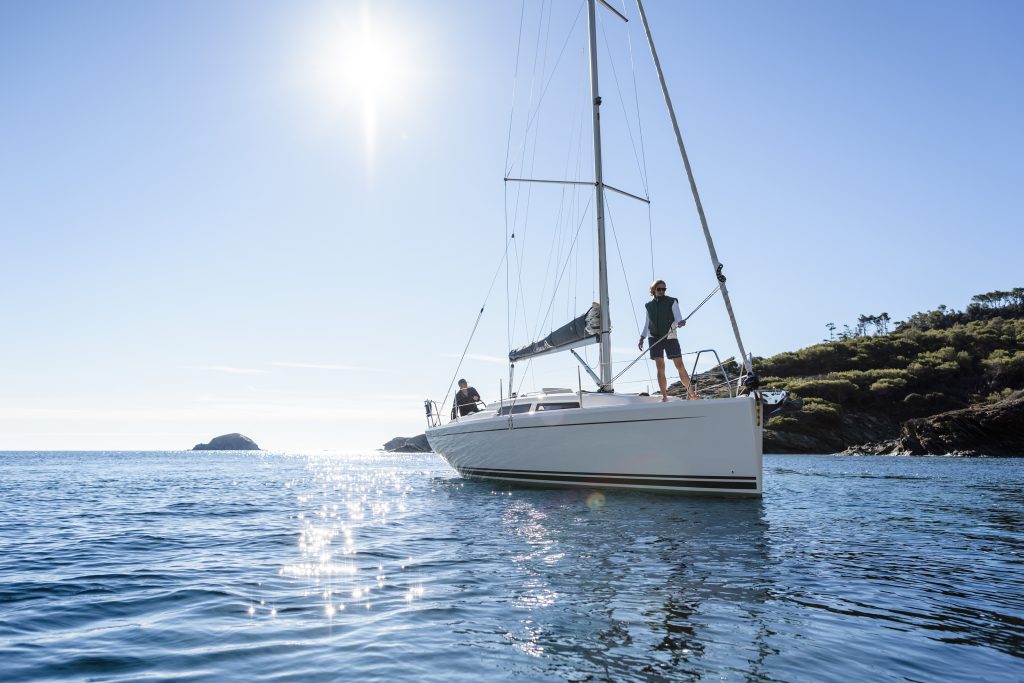
DIY electric inboard boat motor conversion
One way to save money on an electric inboard is to do the installation yourself. There are a few DIY electric inboard boat motor conversion kits available on the market.
I’ve spoken with a few sailors who’ve had great success replacing their inboard diesel engines with these electric boat motor conversion kits from Thunderstruck-EV , an electric drive manufacturer in Santa Rosa, California.
Key features of electric inboard boat motors
Each brand has a slightly different set of electric inboard motor options. Here are some of the key features and options to look for.
- DIY conversion kits
- On-board computers and touchscreen display
- Waterproof system components
Electric inboard manufacturers
US manufacturer, Elco Motor Yachts , has been building electric motors for over 125 years, having gotten their start in 1893, supplying electric boats for the Chicago World’s Fair. They have seven inboards ranging from 6 to 200 hp.
Electric Yacht
Electric Yacht is a US supplier focused on providing plug-and-play electric motors for DIY installations on sailboats. Their electric propulsion systems range from 10 to 30. They’ve had over 450 installs in 10 years of production.
Oceanvolt is a leader in regenerative systems and their electric inboard motors are popular among sailors. They offer shaft drive systems ranging from 6 to 60 hp.
Torqeedo, a German manufacturer, is the world’s leader in electric boat motors. They have two lines of inboards, one for displacement boats and another for fast planing boats. Their Deep Blue inboard systems range from 25 kW to 100 kW (40 to 135 hp)
Hybrid systems
Hybrid systems combine an electric motor and combustion engine, so you can cruise in silence (but know you’ve got enough gas to get home). These systems offer many of the benefits of pure electric motors, without the limited range.
If you want additional power for onboard luxuries like air-conditioning, hybrids can also provide a significant increase in house-side fuel efficiency.
The downside to any hybrid solution is that the systems are far more complex . Not only do they require more equipment, but, for an optimized system, you’ll need highly sophisticated software to manage multiple power sources and switch back and forth between diesel and electric.
Unsurprisingly, the increased complexity adds cost, making hybrids less economical than either a conventional or pure electric install.
Serial vs. parallel hybrids
As with cars, there are two types of hybrid systems: serial and parallel. A serial hybrid uses a generator to power a large electric motor connected to the drive shaft. Whereas, a parallel hybrid has both a conventional combustion engine and a small electric motor connected to the drive shaft.
There are plenty of factors to consider when choosing between a parallel and serial system. Marine mechanics and electrical expert, Nigel Calder, does a great job of explaining serial and parallel hybrids in detail.
In general, serial systems may be a better fit for boats that can get most of their propulsion energy from renewable sources (e.g., a sailing catamaran). Whereas, a parallel system makes more sense on boats that regularly require sustained propulsion (e.g., Greenline’s power yachts ).
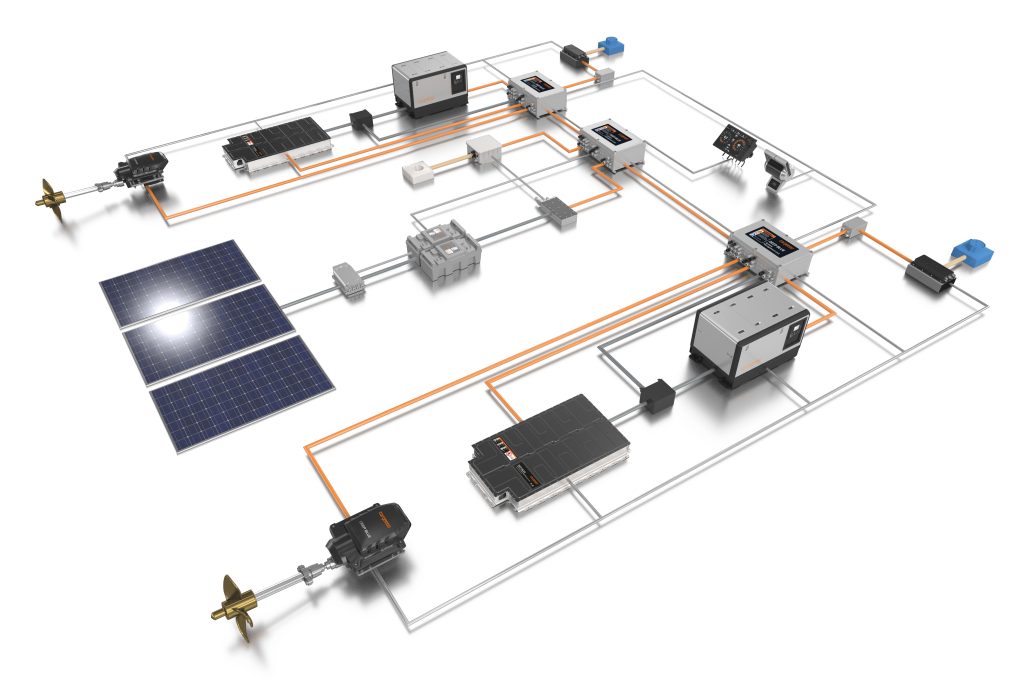
Key features of marine hybrids
- Parallel and serial hybrid options
- Integrated energy management systems
Marine hybrid manufacturers
Elco motor yachts.
Elco manufactures serial, parallel, as well as a combined serial-parallel system. Their systems can be used on sailboats, trawlers, yachts, and boats up to 85′ feet.
Hybrid Marine Ltd.
Hybrid Marine sells parallel hybrid systems in the 10 to 230 hp range. Beta, John Deere, and Yanmar’s hybrids all incorporate Hybrid Marine technology.
Finnish manufacturer, Oceanvolt , offers serial hybrid systems for both sailboats and powerboats.
Torqeedo makes hybrid systems for yachts up to 120 feet as well as powerful motorboats.
Electric pod drive and sail drive
Several manufacturers are now making electric pod and sail drives. These electric drive systems are more efficient and can save space onboard.
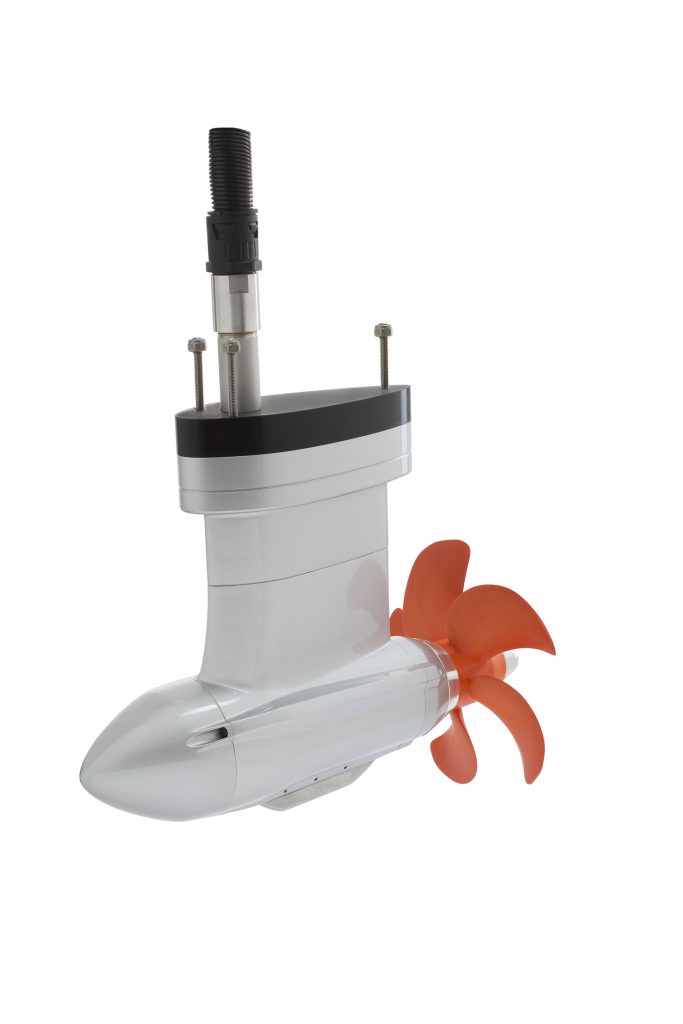
Electric pod and sail drive manufacturers
Electric Yacht produces a range of sail drives that can replace diesel engines up to 75 hp.
propulsion sells a 3 hp, 6 hp, and 9.9 hp fixed pod drive.
Oceanvolt’s sail drives range from 6 kW to 15 kW (8 to 20 hp)
Torqeedo sells a 40 hp and 80 hp equivalent electric sail drive as well as electric pod drives in the 6 to 25 hp range.
While it’s possible to power an electric motor with a conventional lead-acid battery, there are many good reasons to upgrade to lithium-ion batteries.
Their increased usable capacity is roughly double what you can get out similarly sized lead-acid battery. More battery capacity means more range—and hours of fun—on your electric boat.
They also charge more quickly and have a longer life span than lead-acid batteries. Unlike flooded lead-acid batteries, which need to be watered, lithium-ion batteries are practically maintenance-free.
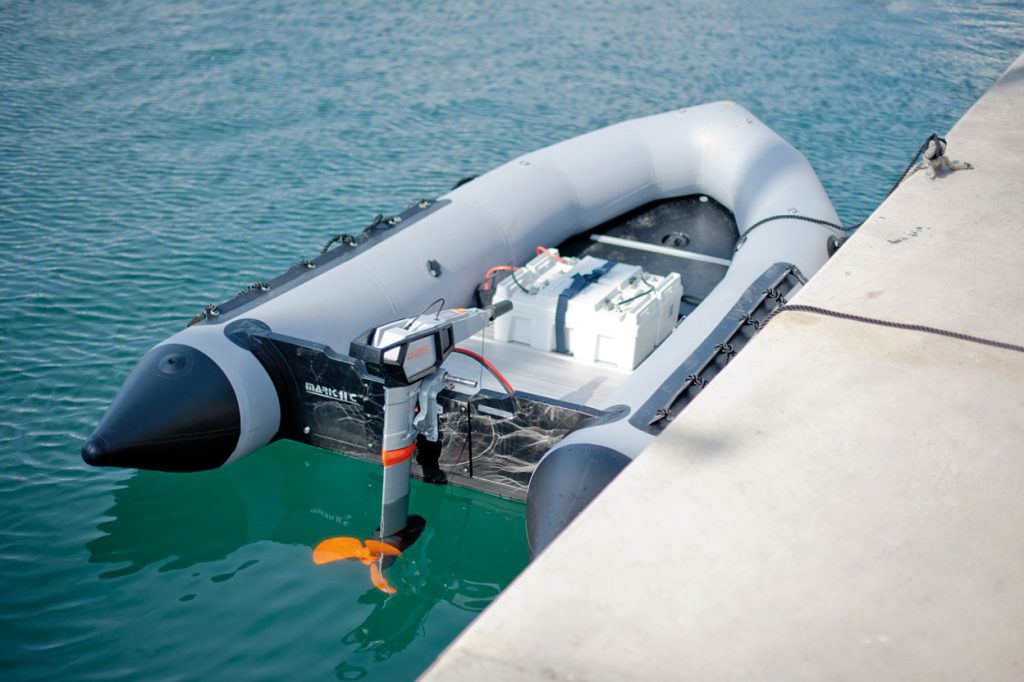
The downside is that lithium-ion batteries are far more temperature-sensitive and can’t be charged much above 113 F (45 C) or below 32 F (0 C).
They can also present major safety issues . Lithium-ion batteries can go into what’s known as thermal runaway—a self-heating process that can cause the battery to catch fire.
Simply put, lithium-ion batteries are NOT a drop-in substitute for lead-acid batteries. They need to be specially designed for the marine environment and paired with a robust battery management system.
Electric motor manufacturers often provide complete solutions (including motor, batteries, and battery management system). It’s a good idea to work with a manufacturer with extensive marine experience and an ABYC-certified technician on any installation.
The other catch is that lithium-ion batteries cost two to four times as much as lead-acid batteries. However, the increased capacity and longer life span may make lithium batteries a better value option over the long run.
Ready to catch the electric boating wave?
With ever more powerful and feature-packed electric options launching each year, it’s an exciting time to be in the market for a new motor or engine. If you have any doubts about whether an electric boat motor is right for you, head to your local boat show and see, first hand, what all the buzz is about.
Fiona McGlynn is an award-winning boating writer who created Waterborne as a place to learn about living aboard and traveling the world by sailboat. She has written for boating magazines including BoatUS, SAIL, Cruising World, and Good Old Boat. She’s also a contributing editor at Good Old Boat and BoatUS Magazine. In 2017, Fiona and her husband completed a 3-year, 13,000-mile voyage from Vancouver to Mexico to Australia on their 35-foot sailboat.
Douglas McQuilken
Sunday 30th of January 2022
Great article!
For those who wish to collaborate with prospective & current electric boaters, highly recommend this forum - https://groups.io/g/electricboats
Thanks for the suggestion, Douglas!
Terms and Conditions - Privacy Policy

Electric boating Powered by Evoy®
Evoy® brings “irresistible boating” to the modern boater. An experience by delivering long-lasting Electric Boat Motor systems ranging from 120-400 hp continuous, accelerating the transition to emission free, blissfully quiet and sustainable boating.
Norway has led the world's adoption of electric cars. Evoy and Norway will lead the world's adoption of electric boats.

A combustion engine has on average over 2000 parts. An Evoy® motor has only 4 moving parts.

Fast-charging
Offering flexible charging solutions from standard AC to fast DC – charging in less than an hour.

Remote support & maintenance, location services, updates and charge status at your fingertips.
Evoy® Electric Outboard Motor Systems
Ready to turn heads at the local marina? The Evoy high-power outboards set the new standard for recreational boating. The continuous power is equivalent to 120 hp or 300 hp with peak power of 185 hp or 600 hp, motor depending. Available Series – Breeze 120+ hp and Storm 300+ hp.
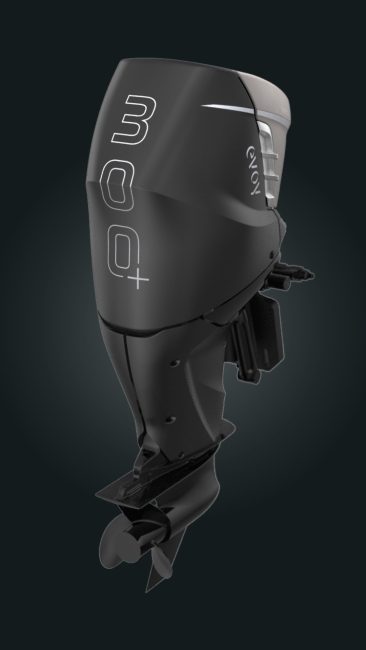
Storm outboard 300+ hp
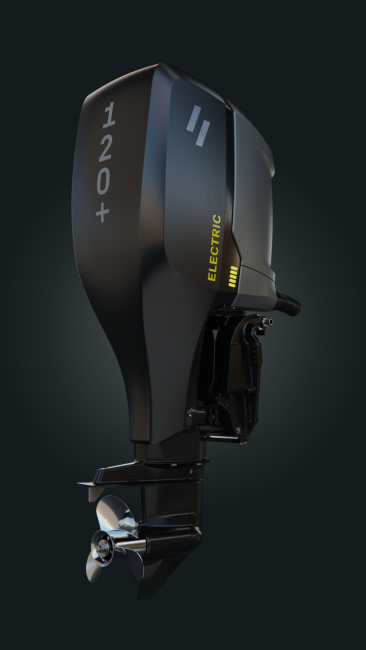
Breeze outboard 120+ hp
Evoy® electric inboard motor systems.
Evoy®’s turnkey inboard electric system is a robust system designed for 1000+ hours per year. Due to the over-the-air updates and programmable system, we can monitor, troubleshoot and update the software onboard. The system is nearly maintenance-free and very affordable to use. The system can be connected to a stern drive, water jet, or shaft. Available Series, Breeze 120+ hp, Storm 300+hp and Hurricane 400+ hp.
Ready to turn heads at the local marina? The Evoy high-power outboards set the new standard for recreational boating. The continuous power is equivalent to 120 hp or 300 hp with peak power of 185 hp or 600 hp, motor depending. Available Series – Breeze 120+ hp, Storm 300+ hp and Hurricane 400+ hp.
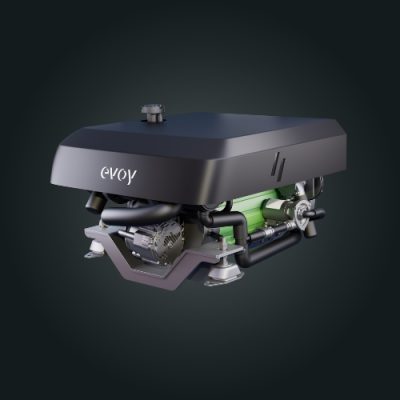
Hurricane inboard 400+ hp
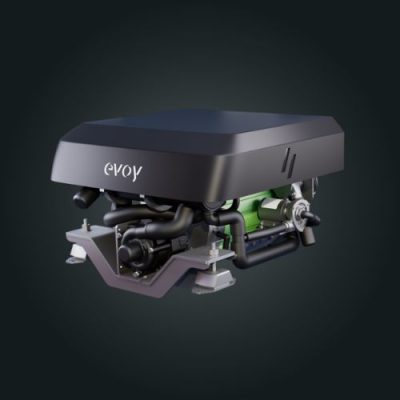
Storm inboard 300+ hp
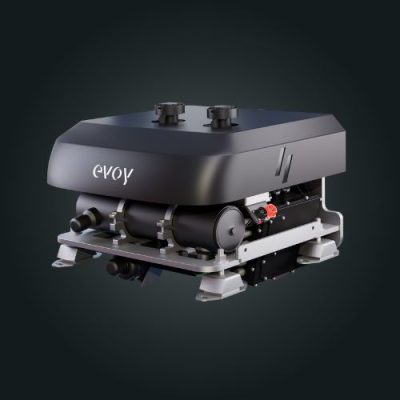
Breeze inboard 120+ hp
Meet up with us.
We know boaters love nothing more than a test drive on the water! We attend several events each year and love to connect with likeminded boaters. Find out where to meet us next and let us introduce you to the world of electric boating.
The shift to electric boating is happening now, powered by Evoy®

Accelerate to Silent Boating
Accelerate to Zero E missions
Accelerate with Evoy
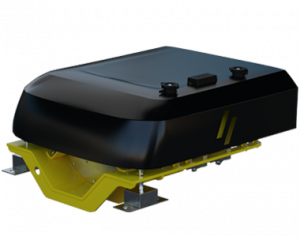
Hurricane - 400+ hp Inboard Electric Motor System
Evoy®’s turnkey inboard electric system is a robust system designed for 1000+ hours per year. Due to the over-the-air updates and programmable system, we can monitor, troubleshoot and update the software onboard. The system is nearly maintenance-free and very affordable to use. The system can be connected to a stern drive, water jet, or shaft.
The continuous power is 400+ hp and the peak power is 800 + hp.
Breeze - 120+ hp Outboard Electric Motor System
Ready to turn heads at the local marina? The Evoy Breeze sets the new standard for recreational boating. The response to our launch has been tremendous. The continuous power is equivalent to 120 hp or even 150 hp ( in cold waters) with a peak power of 185 hp.
Hold on to your hats ladies and gentlemen!
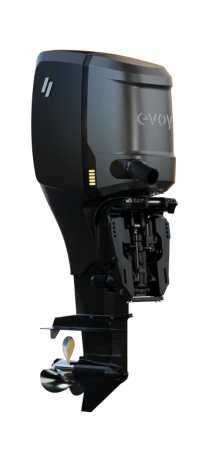
Evoy Florø, Norway
Founded in 2018, Evoy® designs, develops and distributes powerful 100% electric motor systems for commercial and leisure boats, bringing the superiority of electric voyaging into new markets with Evoy’s®ground-breaking technology.
Subscribe to our Newsletter
Enter your email *

- Order E-System
- Media & Press
© Evoy AS 2023
Privacy Policy

get the news first!
Join our newsletter to get the latest updates from Evoy!

Please verify you are a human
Access to this page has been denied because we believe you are using automation tools to browse the website.
This may happen as a result of the following:
- Javascript is disabled or blocked by an extension (ad blockers for example)
- Your browser does not support cookies
Please make sure that Javascript and cookies are enabled on your browser and that you are not blocking them from loading.
Reference ID: 68938815-680d-11ef-b9b4-1e2a2b5a72dd
Powered by PerimeterX , Inc.
- 2024 BOAT BUYERS GUIDE
- Email Newsletters
- Boat of the Year
- 2024 Freshwater Boat and Gear Buyers Guide
- 2024 Boat Buyers Guide
- 2024 Water Sports Boat Buyers Guide
- 2024 Pontoon Boat Buyers Guide
- Cruising Boats
- Pontoon Boats
- Fishing Boats
- Personal Watercraft
- Water Sports
- Boat Walkthroughs
- What To Look For
- Watersports Favorites Spring 2022
- Boating Lab
- Boating Safety
- Ultimate Boating Giveaway

Boat Test: 2024 Monterey Elite 30
- By Randy Vance
- August 28, 2024
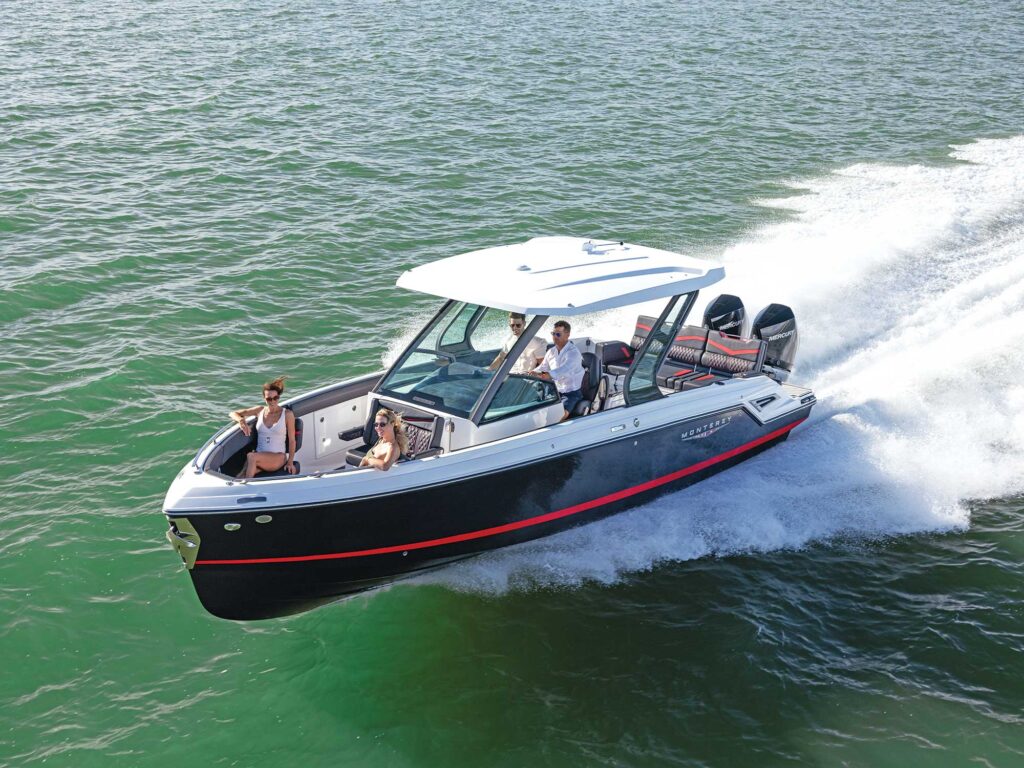
Nothing calls for change like an election year, and at this writing, Monterey is offering a bold new candidate for performance- and luxury-minded boating enthusiasts. We don’t use the word “unique” casually in referring to this sleek boat with sports-car flavors and cutting-edge European style—there’s nothing like it on the water.
The Elite 30’s appeal for votes begins with its square stem and sleek, tucked-to-the-stem, custom, polished stainless-steel anchor, a fresh look at a center helm, and a broad hardtop that straddles the cockpit port to starboard.
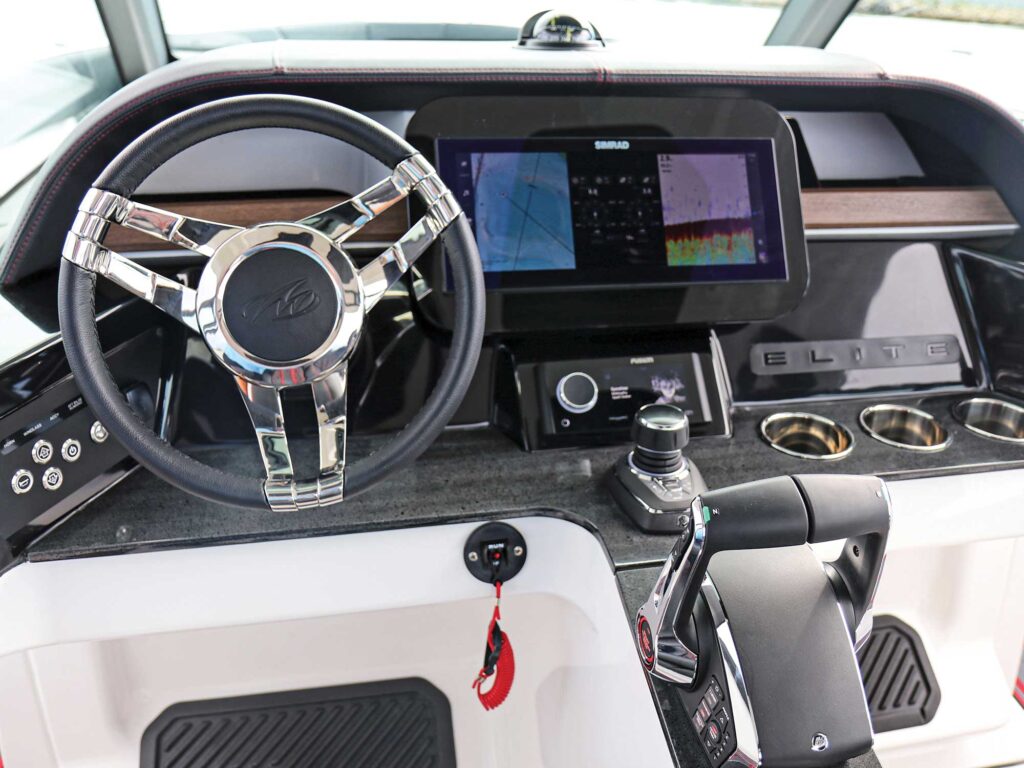
We’ve seen square-stem boats in the US before, and they can have an alarming gift for stabbing into the next wave, spraying water all over the cockpit. In hard turns, doubling back over rolling wakes, we saw none of that bad behavior. Though the stem brings up the foreword freeboard in a near-vertical angle to the water, that freeboard doesn’t begin until the hull beneath it flares out broadly to keep the stem comfortably above the seas. The 21-degree hull deadrise at the transom cleaves chop for a comfortable ride without allowing it to roll excessively with shifting crewmembers, broad seas or crisp turns. The power of dual Mercury 250 hp V-8 outboards offers exciting acceleration—3.2 seconds to plane and 5.6 seconds to 30 mph. Our top speed was over 53 mph, and the joy of having all this in your throttle hand comes not just from the raw power, but also the unique centered helm that you’ll need to see to believe.
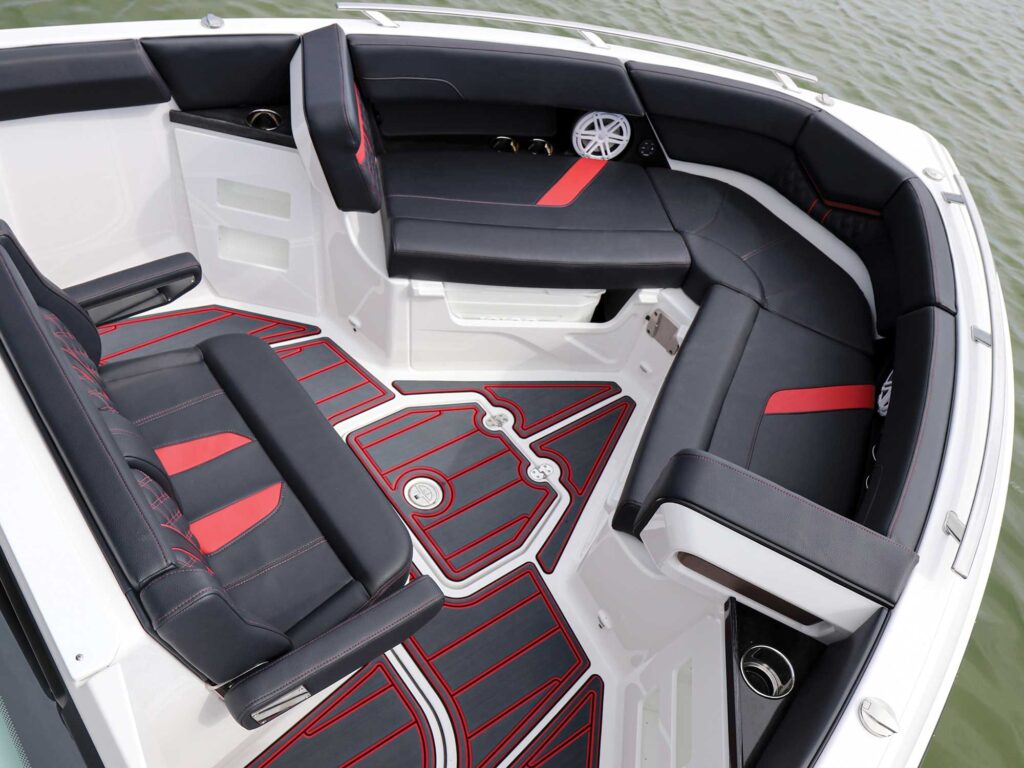
Interior and Accessories
Helm styling is straight out of a performance sports car, with a pair of bucket seats separated by a center console that positions the throttle levers as comfortably as an eight-speed racing shifter and makes the joystick equally reachable. In top-level race boats, the throttle is so arranged as one-half the skippering crew manages the wheel while the throttle man reacts to the seas by varying rpm and 150 mph speeds. You could employ a throttle man in this vessel just for fun if you wish, but even at its maximum throttle speed, it handles like a charm, thrilling crewmembers while protecting them from unexpected changes to direction and acceleration.
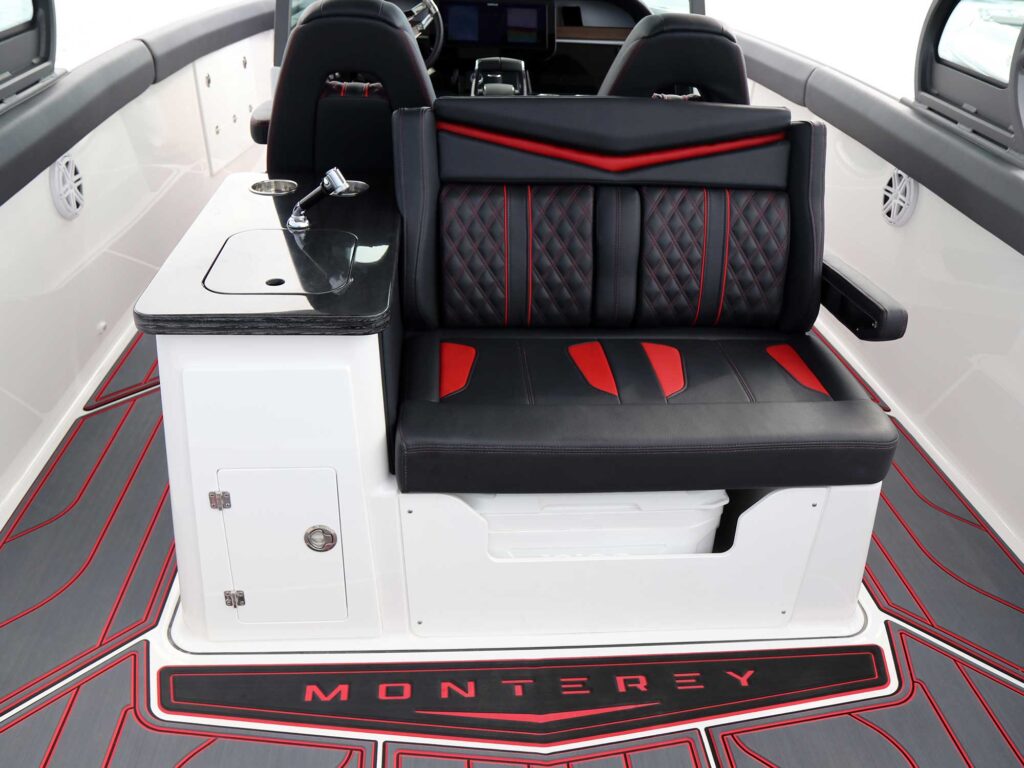
The next remarkable plank to this compelling candidate’s platform is the design of the hardtop and windshield. Mention center console and hardtop, and you’ll picture enormous stanchions springing from the console fore and aft of the helm, blocking sight lines. The top may extend only halfway to the gunwales from the helm perimeter, leaving much unprotected from the sun. Not here. The hardtop rests on highly styled and brilliantly sturdy supports affixed to the gunwales, and it extends well forward of the racily raked windshield and aft over the lounge and bar back-to-back with the helm bucket seats. The safety-glass windshield is full width of the helm and bucket seats, but the windshield stops at the helm sides, allowing fresh air (and passengers) to pass through the cockpit on port or starboard passageways, refreshing us on our test day’s 95-degree, 95-percent-humidity summer swelter. The arrangement is a moderate blend of the extremes of a dual-console windshield and a typical fishing center console. Nothing better than a well-balanced candidate!
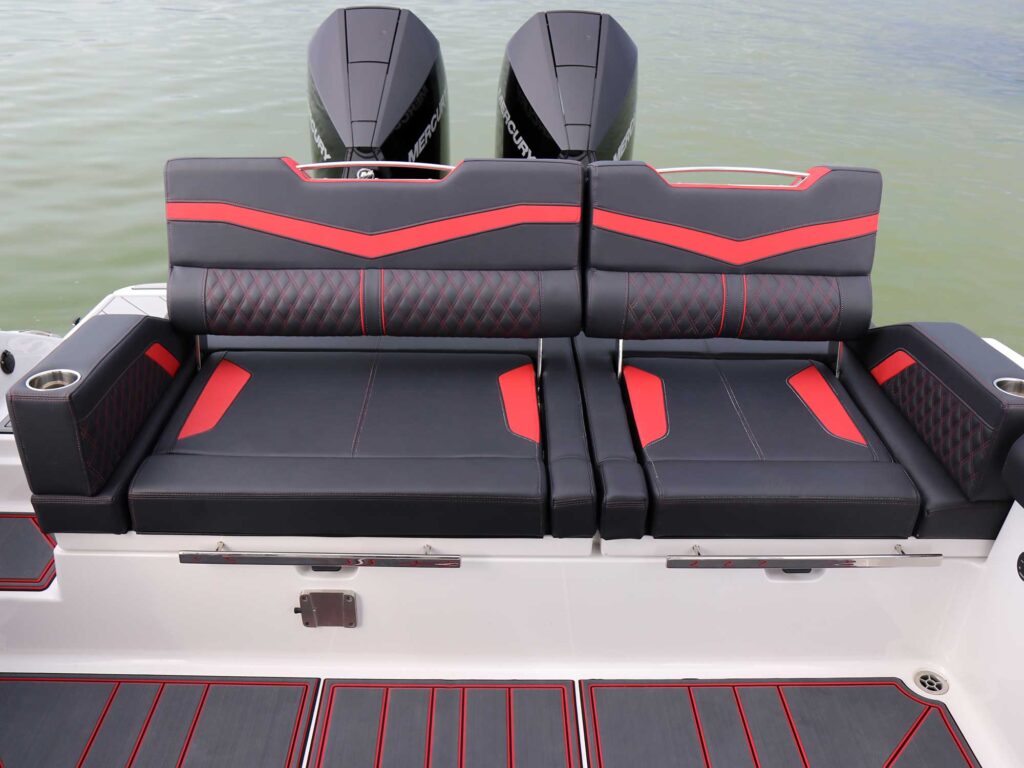
We scoured the marketplace for a similar deck and helm plan to no avail, but the Four Winns H9 at a length overall of 29 feet, 11 inches brings a challenger with that vertical-stem style and with a comfortable standard bowrider setup ($343,025 base price with test power and hardtop). It too boasts a glass cockpit, and the hardtop lowers and raises on concealed ram screws to shrink storage height and can even be dropped down for more rain protection while running from a storm. Four Winns’ new designs from across the pond are the result of the company’s purchase by Groupe Beneteau, the world’s largest boat manufacturer.
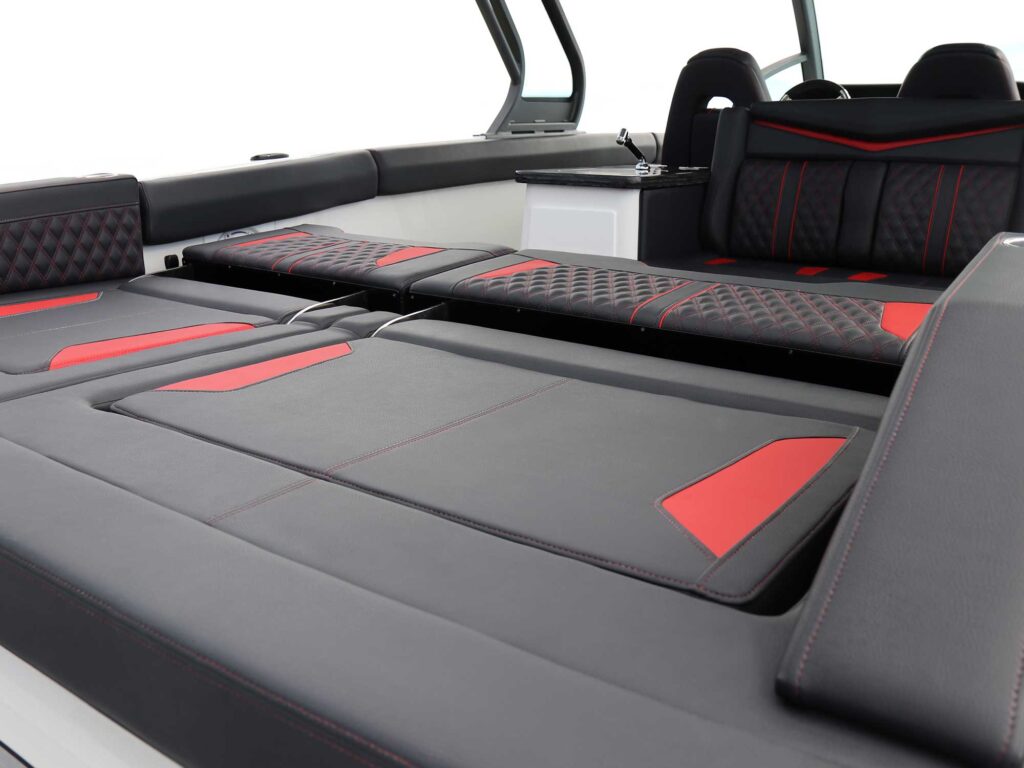
Forward of the Monterey Elite’s windshield is another lounge that swings on hinges to reveal a comfortable changing room with a head and freshwater outlet that competes well with the Four Winns H9. There’s a ton of storage in drawers and cabinets on the Elite. While neither offers stand-up headroom, it’s deep enough aboard the Elite for comfortable movement. Door closed, the Elite’s forward lounge completes a triangular seating area with bow seats and padded coamings to allow crew to relax and chat.
Read Next: Monterey 255 SS OB
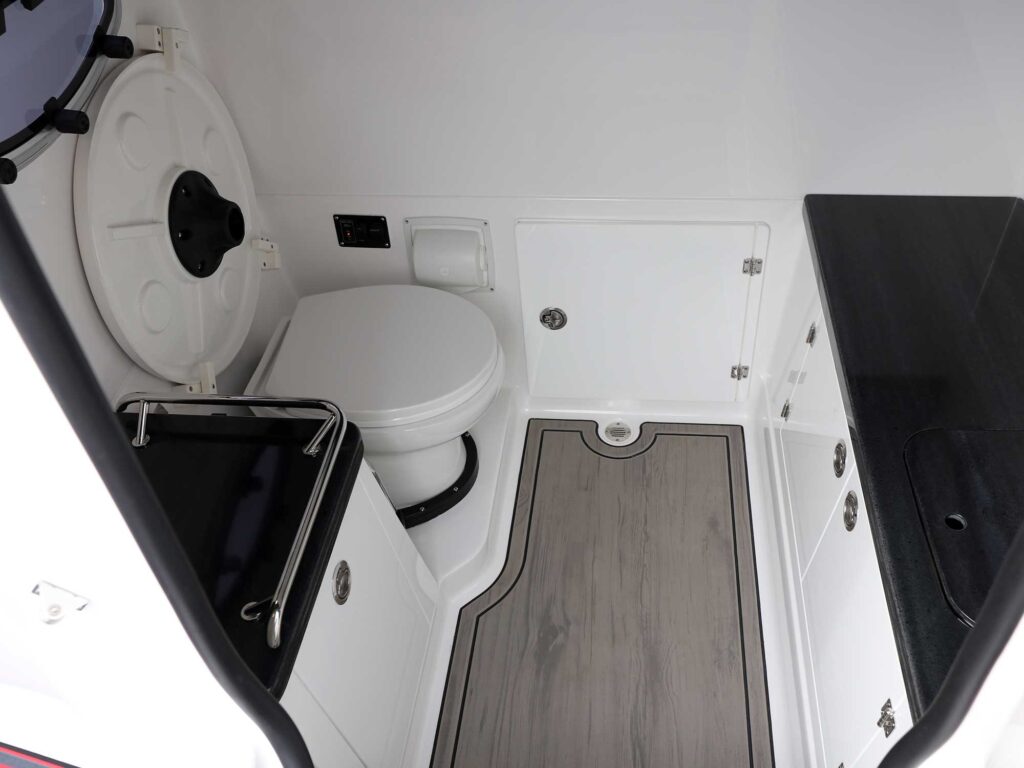
Aft of the helm is the back-to-back lounge that I mentioned earlier. Nestled up to it is a refreshment bar with sink and fresh water. There are large coolers beneath the lounge. This faces a large lounge astern, giving up to six people face-to-face conversation in comfortable seating. A transom door leads to a spacious swim platform. The seatbacks rock forward, allowing boaters to face the water over the transom, or lay the seatbacks down for a comfortable sun lounge.
In a market filled with big, strong dayboat candidates, the Elite 30 stands out on the campaign trail. It may well emerge as the new sheriff in town.
How We Tested
- Engines: Twin Mercury 250 DTX
- Drive/Props: Outboard/Mercury Rev 4 14.6″ x 20″ 4-blade stainless steel
- Gear Ratio: 1.85:1 Fuel Load: 200 gal. Water on Board: 0 gal. Crew Weight: 430 lb.
High Points
- Glass-cockpit design displays all switching, engine functions, temp, oil pressure, speed and more via the flush-mounted MFD.
- Foredeck and cockpit can be quickly shaded with carbon-fiber poles and canvas covering, installable in two minutes or less.
- USB and USBC charge points throughout. The skipper gets an inductive charger.
- Natural light and/or ventilation in the form of a window or port would be welcome inside the console head compartment.
Pricing and Specs
| $200,172 (nationally advertised base price with test power) | |
| 30′ | |
| 9’10” | |
| 1’11” (engines up) | |
| 8,450 lb. | |
| 21 degrees | |
| 8’9″ | |
| 200 gal. | |
| 600 | |
| Twin Mercury outboards |
Speed, Efficiency, Operation
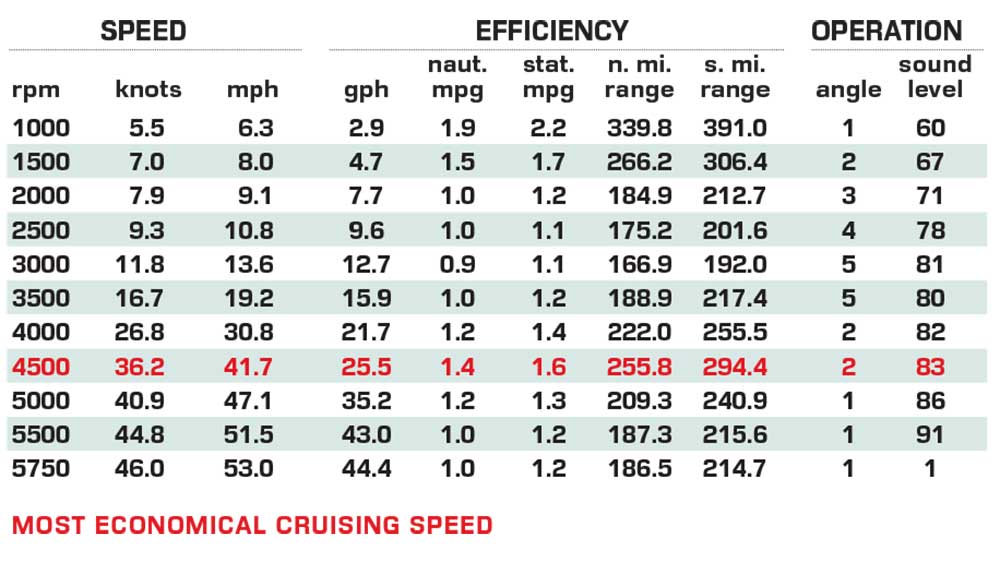
Monterey Boats – Williston, Florida; montereyboats.com
- More: 2024 , 30-40ft , boat tests , Boats , Cruising Boats , monterey , October 2024 , outboards
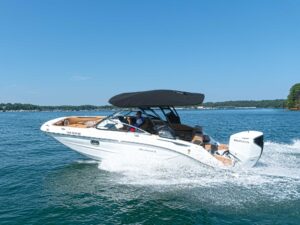
Boat Test: 2024 Hurricane SunDeck 2600 OB

Boat Test: 2024 Brabus Shadow 1200 Sun-Top

Boat Test: 2024 Fjord 39 XP

Boat Test: 2024 Jeanneau NC 895 Sport Series 2
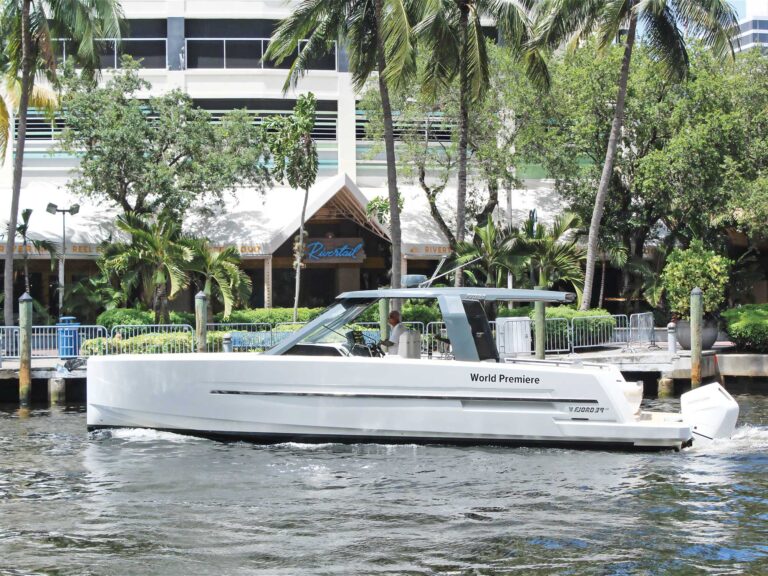
2025 Alumacraft Competitor 205X

2025 Alumacraft Trophy 185X

2024 Alumacraft Timeline: Two Groups of Boaters x One Day Out on the Water

- Digital Edition
- Customer Service
- Privacy Policy
- Terms of Use
- Cruising World
- Sailing World
- Salt Water Sportsman
- Sport Fishing
- Wakeboarding
Many products featured on this site were editorially chosen. Boating may receive financial compensation for products purchased through this site.
Copyright © 2024 Boating Firecrown . All rights reserved. Reproduction in whole or in part without permission is prohibited.
Do water and electricity mix? Rhode Island company bets that formula is the future of boating.

On a recent Friday morning, I hopped into my electric car in the driveway, drove to a marina in Salem, and boarded a 21-foot powerboat that — like my car — had been charging overnight.
As we put the House of Seven Gables behind us, we could barely hear the electric outboard motor attached to the boat’s rear end. Even after speeding up to 25 miles per hour, we could carry on a conversation at a normal volume.
Is this the future of boating?
While electric car sales have begun to take off — more than 1 million were sold in the US last year, according to Kelley Blue Book — marinas are still full of gas guzzlers.
And gas can be a big part of the expense of owning a boat. Matt Perry, a cabin cruiser owner who was watching us take the electric-powered boat for a test ride, said he might spend $300 on fuel over the course of a weekend on the water.
Flux Marine, based in Bristol, R.I., hopes to change that. Founded in 2018, it has raised nearly $16 million , but has sold only a handful of motors. The company’s new strategy is to pair its outboard with new boats made by Scout or Highfield, Flux’s first two partners. Flux was showing off one such boat last month at a sailing regatta in Marblehead and plans to exhibit at the Newport Boat Show in September.
Advertisement
Electric motors have made a small splash in the boating world, but they’re mainly used to power dinghies that take boaters from a mooring or anchorage to shore, or small sailboats that need to be under power only for a short stretch. They rely on a portable battery that you can remove from the boat, and charge at home.
Still, they’re about five times more expensive than a gasoline-powered outboard. When I counted dinghies in part of the Salem marina, 17 had motors. Of those, four were electric.
But the Flux-powered boat, at 21 feet long, was the only large electric boat I could find in the marina. Boatbuilders such as Candela in Sweden and Navier in California have been designing new, fully electric boats, and others such as the engine suppliers Yamaha, Mercury, and Evoy are working on electric outboards similar to Flux’s.
Elco, based in Lake George, N.Y., has made electric boats since 1893 — when one big customer was the Chicago World’s Columbian Exposition — and has sold electric outboards since 2009.
So, Flux will not be the only supplier in the market by a long shot. But cofounder Daylin Frantin says the company is aiming for a sweet spot of enough power, speed, range, and charge time — at the right price.
The entire motor is sealed so saltwater doesn’t corrode the components. Instead of a fuel tank, the company’s boat-making partners leave an empty space where an 84-kilowatt-hour lithium-ion battery pack gets installed. (By comparison, a base-level Tesla Model 3 sedan, with a range of about 270 miles, comes with a 57-kilowatt battery pack.)
The company has 50 employees; a 2022 package of tax incentives from the state of Rhode Island set a target of 80 new employees by the end of 2024. Frantin said he feels good about hitting that number.
Electric boating has some advantages that could help it win over customers more quickly than electric vehicles. First, so-called shore power outlets already installed at most marinas can be used to charge batteries at a much lower cost than gassing up.

Second, electric motors produce much less noise and vibration — not to mention exhaust fumes, which is a real plus if you’re riding on an inner tube or water skis behind one. Third, maintenance costs may be lower over time because electric motors have fewer moving parts and don’t require oil.
The factors that could slow adoption include the same “range anxiety” that afflicts EV drivers: Will I have enough charge to go where I want, and come back? Some boaters will wait to see if the promised benefits prove out, and if the technology is reliable.
On my test ride in Salem, I kept an eye on the digital display in the boat’s cockpit that showed battery range. As we got ready to head out, sales manager Matt Murphy of Flux told me the range was between 30 and 75 miles, “depending on the number of passengers and how fast you’re going.” But once the boat got up to about 20 miles per hour — a brisk clip in a small boat like the Scout, but not blazingly fast — I watched the range dip to 19 miles (with the batteries at 94 percent full, and three people aboard).
Companies trying to electrify pleasure boating will be tested by strong currents, starting with customer demand. Lyle Butts of Bay Sails Marine in Wellfleet says he has rented out boats with electric motors for nearly 20 years, including a small electric-powered catamaran (without sails). But, Butts said, “I don’t get customers asking” for electric motors.
Another obstacle to adoption is physics: It’s much easier to power a car along a highway than it is to push a boat through water, said Larry Russo Jr., regional president at the boat dealer MarineMax. That means that boats use far more electricity to go a mile — and need more on-board battery storage — than a car.
Finally, there’s the price tag. The Scout powerboat I rode on sells for $120,000 with the Flux electric motor; a similarly equipped model with a Mercury 150-horsepower gas-powered motor costs $90,000. That’s a big difference.
As a result, Russo said, the transition in recreational boating from gas to electric is going to take a while.
“There will be a few early adopters who can afford it and think it’s cool,” Russo said. “But others will think, ‘If I’m going to spend that much more money, why don’t I just get a bigger boat?’”

Scott Kirsner can be reached at [email protected] . Follow him @ScottKirsner .
- Spirit 1.0 Plus
- Spirit 1.0 Evo
- Pod Drive Evo
- E-Series Battery
- G102-100 Battery
- Find a Dealer
- Have a Dealer Contact Me
- Product Registration
- Support Center: FAQ & Guide
- Video Tutorial
- Download Center
- Performance Bulletins
Outboard Motor Battery: What Size Do I Need & What’s Best for My Boat?
New to boating and trying to figure out what outboard motor battery you need?
However, you might get overwhelmed by the vast choice of outboard motor batteries in the market.
To name just a few: marine batteries, lithium batteries, lead-acid batteries, AGM batteries, deep cycle batteries, starting or cranking batteries…
And all outboard motor batteries are available in various volts, sizes, brands, etc.
The more you search online, the more confused you might be.
You are not alone! Here we will explain all your confusion in a simple guide.
If you are one of those who are trying to figure out the battery needs for your boat (types, sizes, etc), read this post to find quick answers.
Besides that, you will also learn about outboard motor battery wiring and charging in minutes.
Table of contents:
Outboard Motor Battery Types
Electric boat motor battery sizes, best outboard motor battery, outboard battery wiring, outboard motor battery charging.
- FAQs About Outboard Batteries

What kind of battery do I need for an outboard motor?
You might have seen outboard motor batteries with confusing labels. In fact, they are categorized according to their purposes and chemistry.
2 Types Based on Purposes
Basically, all outboard motor marine batteries serve two purposes: starting the engine or running the electrical load onboard. This divides outboard motor batteries into two types.
- Starting Batteries
As the name implies, a starting battery (or cranking battery) is ultimately designed to start the engine. This kind of outboard motor battery comes with high CCA values, providing high current surges and cranking amps to start your engine.
If using the wrong battery that’s not designed for a starting (or high-power) application, you will have a high chance of starting a fire in the voltage regulator and killing the battery.
- Deep Cycle Batteries
By contrast, a deep cycle battery is made for discharge and supports intensive cycling. It provides rechargeable power for many cycles, ideal for running electric outboard motors, trolling motors, and electronics onboard.
Compared with starting batteries, deep cycle batteries are more expensive and heavy, but they are perfect for powering stuff without an engine running.
Key takeaway:
Basically, the kind of battery you need for an outboard ultimately depends on your purpose.
If you’re looking for a battery for an electric start outboard motor (vs pull start) , the starting battery is what you want. However, if you own an electric outboard or trolling motor, you should use deep cycle batteries ( LiFePO4 is recommended).
4 Types Based on Chemistry
You will find four kinds of outboard motor batteries if you look at their chemistry inside the cells, namely flooded batteries, gel batteries, AGM batteries (advanced lead-acid batteries), and lithium batteries.
Among them, lithium is a HUGE upgrade in battery technology, and there are a great number of advantages that people run to lithium (especially LiFePO4) for their outboard motors:
You can fully discharge the battery cells every day (almost 100% vs 50% for AGM) without killing them. Moreover, they can recharge 2k-10k times vs 300-800 AGM.
These mean significantly more power capacity, so it can last twice as long on the water.
Not to mention they’re also a lot smaller and lighter than the comparable lead-acid battery, and charge much faster. And you can see the battery state on your phone or via a digital screen.
That’s why all reputable electric outboard motor brands, including ePropulsion , use lithium (or even LiFePO4) batteries as their accompanying batteries.
Further Reading : Why You Should Choose LiFePO4 Batteries

What size battery do I need for an outboard motor? What amp-hour rating should I get?
The electric outboard motor batteries are available in a variety of sizes and power levels.
Here is how to calculate the outboard battery sizes in simple steps:
Method #1. Start with Amps.
Step 1. Get the outboard motor electric consumption in Amps (usually available in the manual). Or calculate with Amps = Watts / Volts.
Step 2. Calculate the Amp hour rating of the outboard motor (Ah = Amps x Time).
This Ah rating indicates the battery size that will be sufficient for your requirements.
For example, if your motor consumes about 60 Amps and you want an outboard motor battery that will last 3 hours, you will need a 180 Ah ( = 60 Amps x 3 hrs) battery.
Method #2. Start with Wattage.
(Use this method if you know the wattage rating of your outboard motor.)
Step 1. Calculate the total watt required for the outboard motor battery (Wh = Watt x Time).
Step 2. Calculate the Ah rating with the given voltage (Ah = Wh / Volts).
For example, if you own a 1 kW outboard motor ePropulsion Spirit Evo and you want to use it for six hours on a 48V boat system (on a single charge), you will need a 125 Ah battery.
Note that the calculation is under full load and max amp draw (meaning you’re running the motor wide open the whole time).
In real life, the amp will be much less. That’s to say, you may get away with a smaller battery if you run at part throttle with intermittent use.
However, always go for a larger battery if you go with AGM/lead-acid deep cycle batteries.
Generally, you don’t want to discharge the battery more than 50% to prevent damage. So half the rated capacity.
Alternatively, lithium batteries can be more fully discharged without damage, so you can use more of the rated capacity, which is a big plus for outboard motor batteries.
Reading this far, I believe you should be able to decide the best outboard motor battery for your boat. If you are still not sure, here is a simple guide to help you make a quick decision.
Essentially, three things to consider:
If you are looking for a small outboard motor battery, the weight should be a top priority.
You will never want an outboard motor battery to sink your small boat and break your back every time you carry it from your car and to the dock.
In that case, the lightweight lithium battery would better fit your needs.
Typically, a 12V 100Ah lead acid battery weighs over 60 lbs. Comparatively, a 100Ah LiFePO4 battery weighs only 25 lbs. So you can easily shave about 35 lbs off the weight in your boat.
Not to mention its larger usable battery capacity and smaller lighter battery cell.
As a Zodiac boat owner reported, his 12V LiFePO4 outboard motor battery lasts 2 times as long as a 120 Ah lead acid that weighs 3 times what the LiFePO4 does.
#2. Battery Life
Outboard motor battery life should be a deciding factor in purchase decisions. You need to make sure the outboard motor battery gets enough juice to do the job.
So choose an outboard motor battery that comes with a larger battery capacity and longer life cycles. And the lithium battery goes a long way in these two aspects, with at least 80% DoD (depth of charge) and 5 times more charge cycles than lead-acid batteries.
However, how long your outboard motor battery can run actually depends on a lot more factors.
One of the key factors is outboard power. The best battery for an 25 HP outboard motor is definitely different from the one for 40 HP, since they are running at different watts.
For example, if your motor runs at 300W and you use it with a 230Wh LiFePO4 battery, you will get 40 to 50 minutes’ continuous usage out of this battery.
Note that throttle power settings also make a great difference in your outboard motor battery life:
When moving a boat through water in displacement mode, to go twice as fast you must increase the power about fourfold. That’s to say, if it theoretically takes 200W to go at 2 knots, it would take 800 watts to go at 4 knots.
At the same time, going at half throttle may quadruple your range, even though you’ll get there half as fast. Many electric boat owners simply go quite slowly to make the cost and physics add up.
Also, you can use a solar panel to help keep your outboard motor battery topped up.
Further Reading: Solar Powered Boat Motors: Easiest Way to Set up Your Solar Boat
The last step to get the best bang for your buck is to compare costs.
And that’s not all about the price tags.
Although the lithium outboard motor battery is more expensive, it can last 10+ years if taken care of properly.
Actually, it becomes cheaper if you plan to use it for many years. By this I mean that it may cost 2 times more upfront, but it will survive roughly 5 times as many cycles.
All in all, a lithium battery would be the best outboard motor battery option nowadays if you want to minimize size and weight and don’t mind a higher upfront cost.
Other than that, lead acid is also a reliable technology, proven and improved over hundreds of years. If you have a tight budget, go for a larger lead-acid battery.
How to wire an outboard motor to its battery?
In fact, it’s easy to hook up your outboard motor battery if you follow the manual. You don’t need to fumble with the outboard motor battery cables to get it plugged in.
Basically, you just need to connect the outboard motor and battery with the provided switch cable and communication cable. Also, the control system should be connected to the battery with communication cables.
Some small outboards come with an integrated battery, making it easy for the battery wiring.
For example, the 3 HP ePropulsion Spirit 1.0 Evo only requires you to place the battery in place (secured by two side slots), and then connect the power cable to the battery.

How to charge an outboard motor battery?
Generally speaking, an outboard motor battery needs to be charged with a specialized charger. And the charger decides the charging efficiency.
Fast chargers are available for some models, or you can also use two or more chargers in parallel connection to speed up the charging.
Does an outboard motor charge the battery itself?
Yes, most outboard motors can charge a battery directly while running just like your car’s motor can charge its battery:
The engines come with an alternator or generator. When you start the engine up, the engine will charge the starting outboard motor battery until full. If there is an aux battery, it will then switch over and charge the aux battery.
More About Outboard Motor Batteries
1. does an outboard motor need a battery.
Yes, your outboard motor will need a battery to work unless it’s a pull start.
2. Can a lithium battery start an outboard motor?
Standard deep-cycle lithium batteries are not designed for starter uses.
However, lithium batteries for starting outboard motors are now available, which are specially designed to meet the strict specifications for marine cranking use.
In fact, some outboard manufacturers, such as Mercury Marine, encourage users to use qualified lithium batteries to start the engine for optimal performance.
3. Does an outboard motor charge the battery when running?
Yes, you can charge a battery from an outboard by burning fuel. For electric outboards, some models (including ePropulsion Navy Evo ) can collect electricity from wind and water and charge themselves via a hydrogeneration function.
4. Can an outboard motor charge a lithium battery?
Unfortunately, most outboard motors can not charge a lithium battery directly. You will need a DC/DC charger to make it possible.
Other than that, you can invest in an electric outboard motor with hydrogeneration function which allows the motor to charge itself while sailing.
Hopefully, this post can help you clear your confusion about outboard motor batteries. If you have other concerns, please leave your question in the comment below and I will get back to you ASAP and add it to the list.
Recent Posts

ePropulsion Partners with 37th America’s Cup to Supply Sustainable Electric Power for Autonomous Race Marks
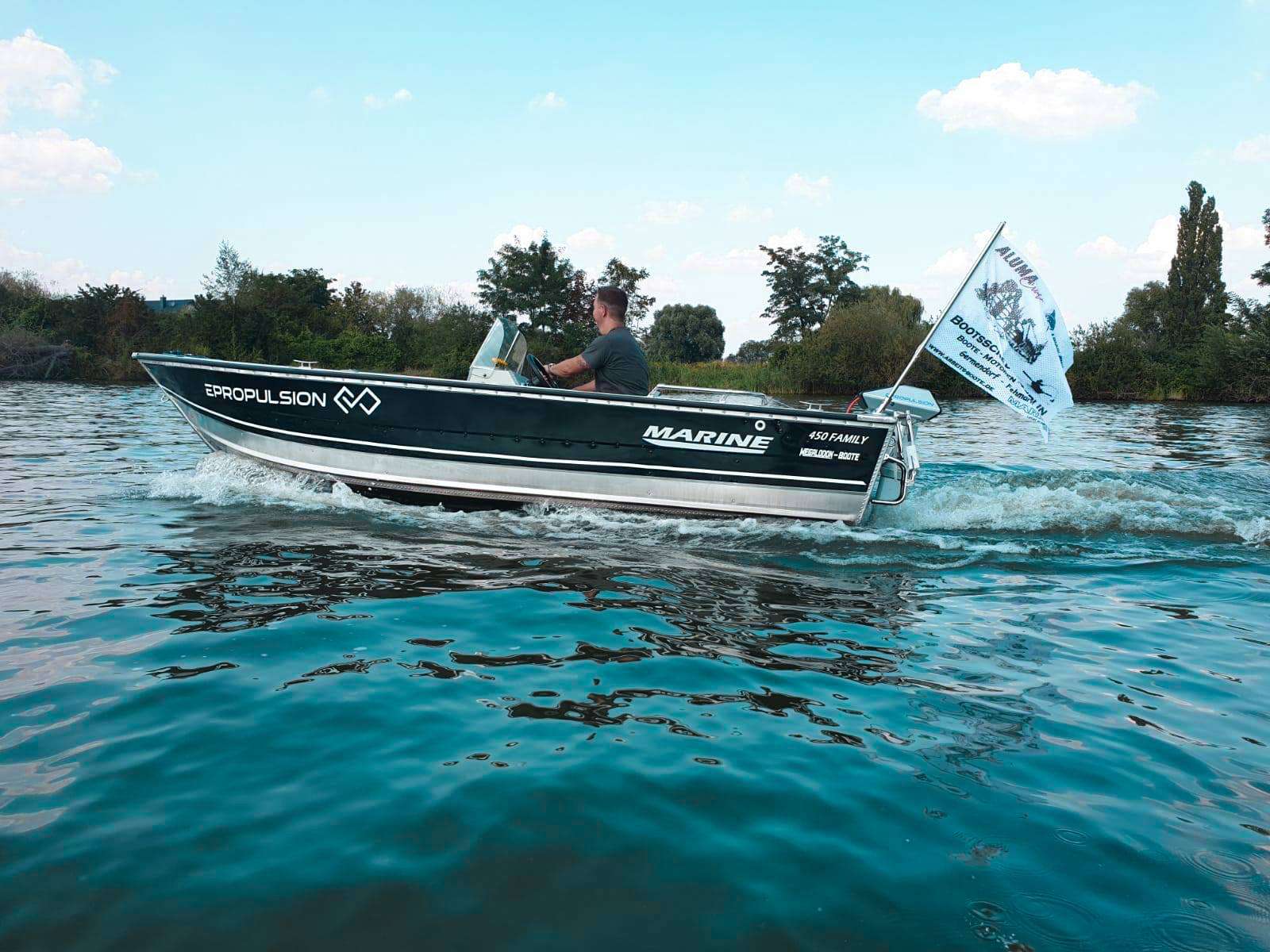
Why Do Boats Porpoise & How To Stop Your Boat From Porpoising
Join the discussion cancel reply.
Save my name, email, and website in this browser for the next time I comment.
Notify me via e-mail if anyone answers my comment.
This site uses cookies to personalize your experience and analyze site traffic. By clicking accept or continuing browsing the site, you are agreeing to our use of cookies. See our Privacy Policy here .
View the Serial Number
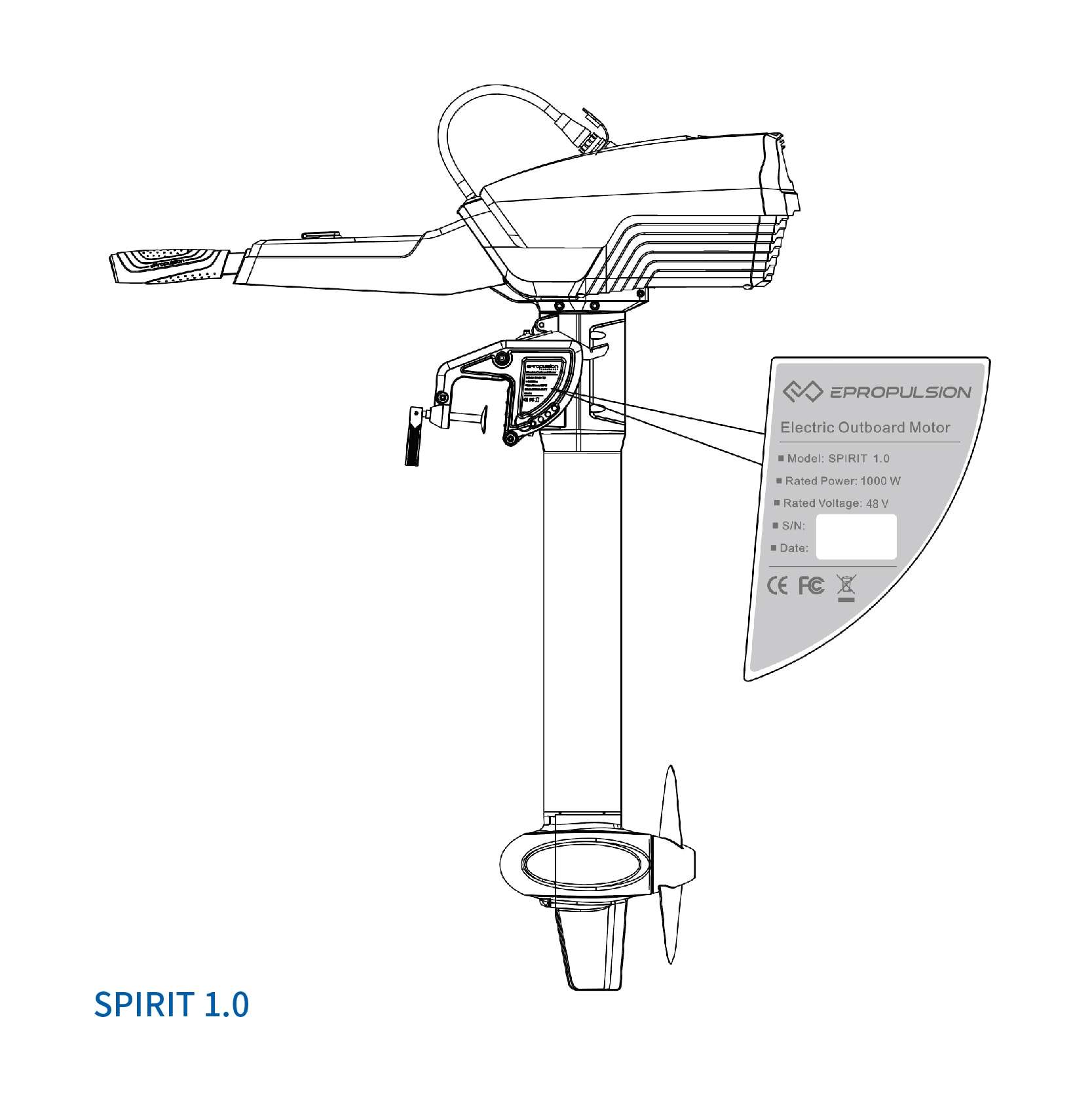

IMAGES
VIDEO
COMMENTS
2) ePropulsion Navy 6.0. If you are looking for something longer lasting than and more powerful than the Spirit 1.0 Plus, ePropulsion also offers the more powerful Navy 6.0. The Navy 6.0 is equivalent to a 10Hp engine, so it won't struggle to move a relatively big boat. The range on the Navy 6.0 is impressive.
With the Spirit 1.0 Evo electric sailboat motor, you can go 5.5 mph (8.8 kph) at top speed on the 21 ft RS21 sailing boat, or troll for 20 hours continuously at 2.2 mph (3.5 kph) according to our test. This electric sailboat motor with regeneration allows you to recover energy from the prop while under sail.
Weight: 27.1kg Power: 750W / 1hp Battery: 1kWh Range: 34nm Price: $1,500. Announced in early 2022 and launched less than a year later, the Mercury Avator 7.5e is the first electric unit from the world's biggest builder of outboard engines.. The whole top plate hinges up to reveal the battery, which can be quickly removed from your electric boat or replaced for convenient charging.
Motor weight: 10.5kg. Battery weight: 9kg. Battery capacity: 1276Wh. Top speed RIB: 4.5mph. Top speed skiff: 6.0mph. Thrust: 31kg/68lbs. The Chinese firm ePropulsion has been developing its electric outboard motor range and lithium batteries for some time. We tested the Spirit 1.0 Plus and Evo, both 1kW motors with integral batteries.
A quiet competitor in the small electric outboard market is the Haswing Ultima 3.0. Like the Torqeedo Travel and ePropulsion Spirit series, this motor is a 3-horsepower-class motor with a built-in battery pack. It's aimed to power dinghies and small fishing boats, with an emphasis on being portable and easy to set up.
This electric outboard motor with a built-in battery provides 3 hp equivalent horsepower and can go up to 22 miles at 4.5 mph, or keep running all day long at trolling speed. Highlights: Direct-drive motor, maintenance-free. 1276Wh capacity for 4-hour economical speed runtime.
Oceanvolt offers Hybrid or Electric systems as a power & propulsion option in partnership with many leading monohull boat builders - adding new partners continuously. We also offer repowering solutions for converting away from legacy diesel engines - removing the diesel engine, fuel tanks and exhaust system - cleaning up greasy, smelly engine ...
TorqTrac. $ 149.00. Magnetic kill switch. $ 29.99. 5-Pin Cable extension for throttle, 5 ft. $ 34.99. Torqeedo Cruise outboard motors are state-of-the-art electric drive systems for boats up to 10 tons. With a respectable performance of 6 to 25 HP.
ePropulsion electric outboards enable one-design sailboats to leave and return to the marina quick, silent and maneuverable. Owners of daysailers and small cruising sailboats love pod drives because they are space-saving, quiet and vibration-free. The hydrogenation and solar charging also allow sailors to travel further and sail sustainably.
Avator 35e Outboard with Two 2300Wh Batteries 20% Longer Runtime*. Electric Outboard Competitor A with One 5000Wh Battery. *Runtimes vary based on boat, load, environmental conditions, battery level and more. Runtime and efficiency figures are based on Mercury internal testing using a 12-foot Lund WC-12 boat starting with fully charged batteries.
22.5″. LONG SHAFT OVERALL (HEIGHT, WIDTH, LENGTH) 50.4″ x 14.8″ x 27.7″. MSRP. $9,950. The EP-50 electric outboard is Elco's most powerful electric boat motor. Experience the tranquility of quiet electric operation with the power your boat needs.
An Avator electric outboard is designed to let anyone take the helm with confidence. Intuitive tiller or remote controls are comfortable, responsive and easy to use, putting boating freedom in your hands. And with its near-zero-maintenance design, it's ready to go when you are. Exceptionally Smooth and Quiet.
Range & Runtime. Based on testing with a 13-foot Veer™ V13 boat (382-pound dry weight), the Avator 7.5e electric outboard can run for 60 minutes or 5 miles at constant full throttle, with one fully charged 1kWh battery, and up to 19 hours or 34 miles at constant 25% throttle. Range and runtime may vary. Environmental conditions, boat type and ...
This site is focused on electric outboard motors for sailboats up to 27ft, and up to 5,000 lb. displacement. Which motor for my boat? How much power do I need As previously discussed, boat speed is directly affected by boat hull design, displacement weight, wind, waves, and boat motor power. When it comes to motor power, diesel and gas-powered ...
Mitek: 2.6-20hp electric outboard motors. Italian-based Mitek makes a series of outboards where the drive is enclosed under a cowling and the power is fed in from a separate battery bank. "Our outboard sales are focused on the portable market, from 2.6hp up to the newest 15hp and 20hp," says sales manager Silvia Peduto.
35 feet 7.9 knots (9.1mph) With an electric outboard motor, or any kind of auxiliary motor, boat speed depends on the hull type, waterline length, and total displacement weight (including passengers, food, and baggage), as well as the motor thrust. Speed factors also include the waves, current, and wind, relative to your heading.
The number one for sustainable outboards and inboards - Torqeedo offers electric outboard motors up to 100 kW, inboards, hybrid-systems, intelligent battery technology and accessories ... The perfect electric motor for rental boats and other use cases in tourism. LEARN MORE. CRUISE 12.0. up to 25 HP. Powers watertaxis and other commercial ...
Introducing Navy. Navy Series is the backbone of ePropulsion electric outboard motors. It provides efficient and clean power for aluminum fishing boats, dinghies, daysailers and cruising sailboats, suitable for saltwater and freshwater. Thanks to the direct-drive technology, the Navy electric outboard boat motor is quiet, Low Maintenance, and ...
2-Stroke Engines - This is due to an overall lighter weight engine and higher torque. Diesel Engines - Diesel delivers more torque because the rate of compression is greater. Bigger Propellers - More surface area means more water displacement. Location - Motoring on lakes and rivers requires less power than open ocean.
Based in Quebec, Canada, Vision Marine Technologies has been in the boating industry for 25 years and produced some very innovative electric boats. In 2021, they launched E-Motion 180E, one of the most powerful electric outboards on the market. Frauscher 740 Mirage Air with Torqeedo Deep Blue 100i 2400.
Evoy®'s turnkey inboard electric system is a robust system designed for 1000+ hours per year. Due to the over-the-air updates and programmable system, we can monitor, troubleshoot and update the software onboard. The system is nearly maintenance-free and very affordable to use. The system can be connected to a stern drive, water jet, or shaft.
Mercury Avator 7.5e Tiller Electric Outboard Motor Kit, 15" Shaft. Travel S Electric Outboard, Short Shaft, 1,100 Watts. Travel S Electric Outboard, Long Shaft, 1,100 Watts. Avator Lithium-Ion Self Connecting Battery, 1KWH NMC. Spare Battery for Travel 603/1003/1103CS/1103CL Series Electric Outboards, 915 Watt Hours.
The X Series electric outboard motors for boats are equipped with innovative technology, smart features, and human-centered design. They provide users with a clean, quiet, powerful, highly integrated, easy-to-use, smart, safe, and reliable experience.
The 21-degree hull deadrise at the transom cleaves chop for a comfortable ride without allowing it to roll excessively with shifting crewmembers, broad seas or crisp turns. The power of dual Mercury 250 hp V-8 outboards offers exciting acceleration—3.2 seconds to plane and 5.6 seconds to 30 mph.
Elco, based in Lake George, N.Y., has made electric boats since 1893 — when one big customer was the Chicago World's Columbian Exposition — and has sold electric outboards since 2009.
The electric outboard motor batteries are available in a variety of sizes and power levels. Here is how to calculate the outboard battery sizes in simple steps: Method #1. Start with Amps. Step 1. Get the outboard motor electric consumption in Amps (usually available in the manual). Or calculate with Amps = Watts / Volts. Step 2.